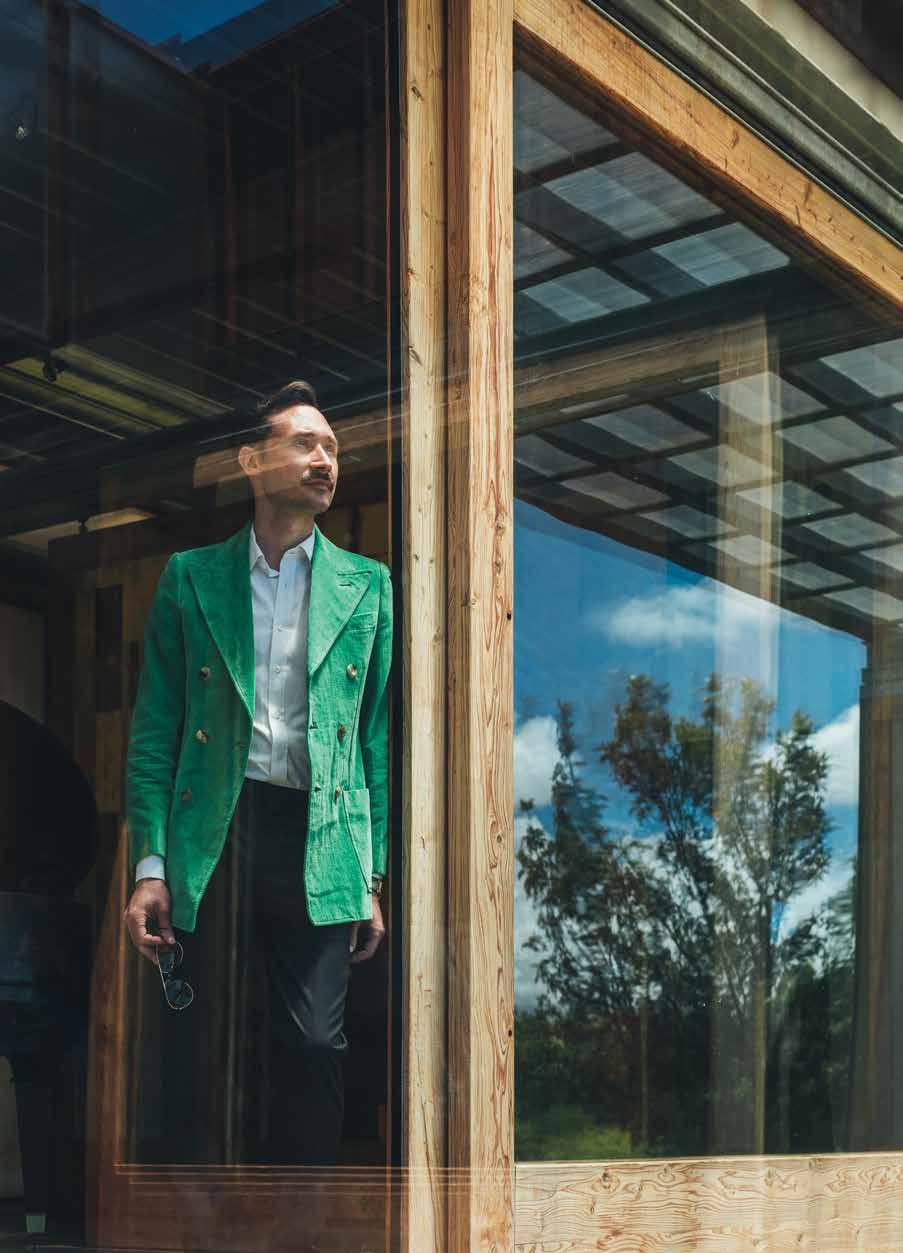
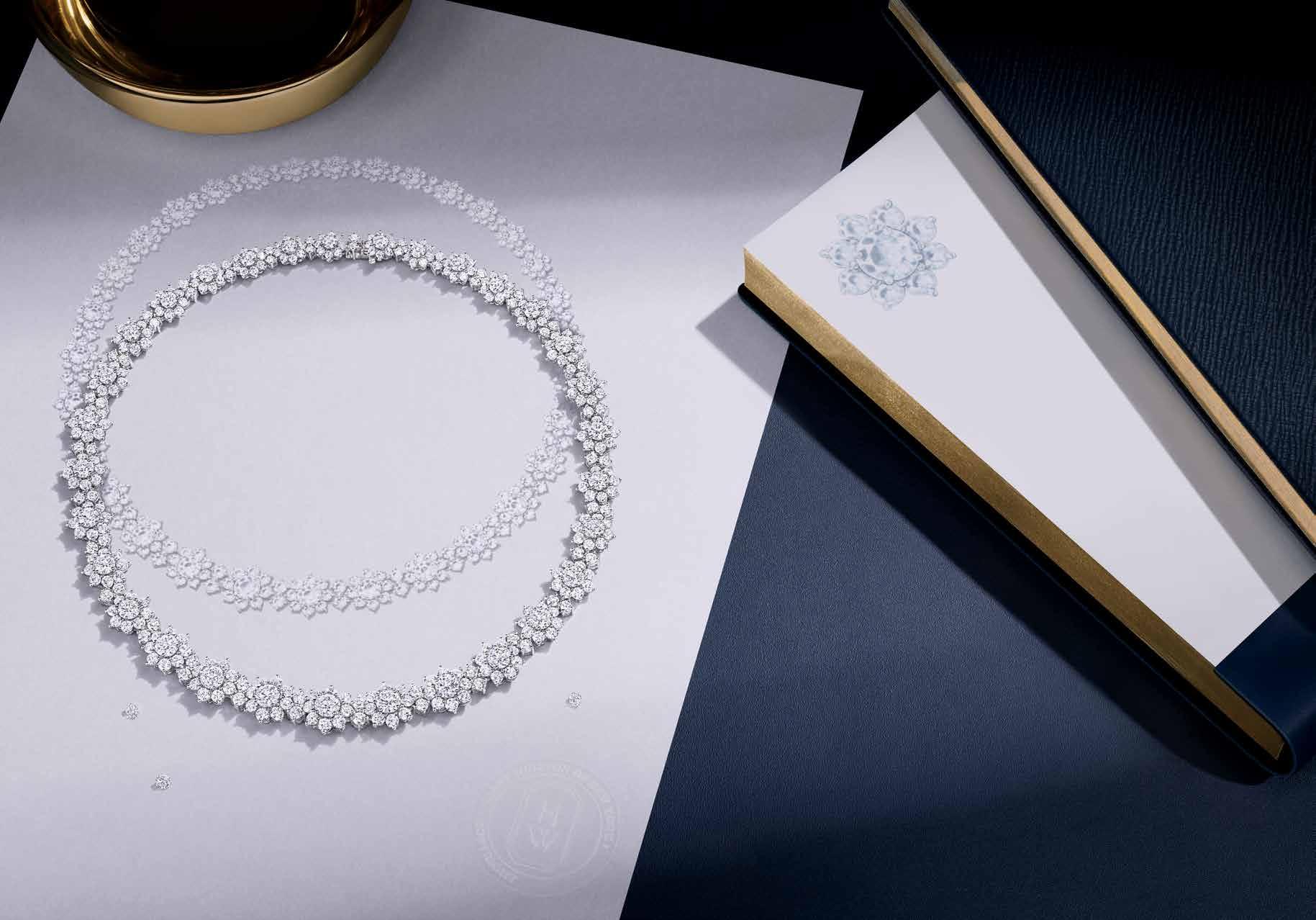

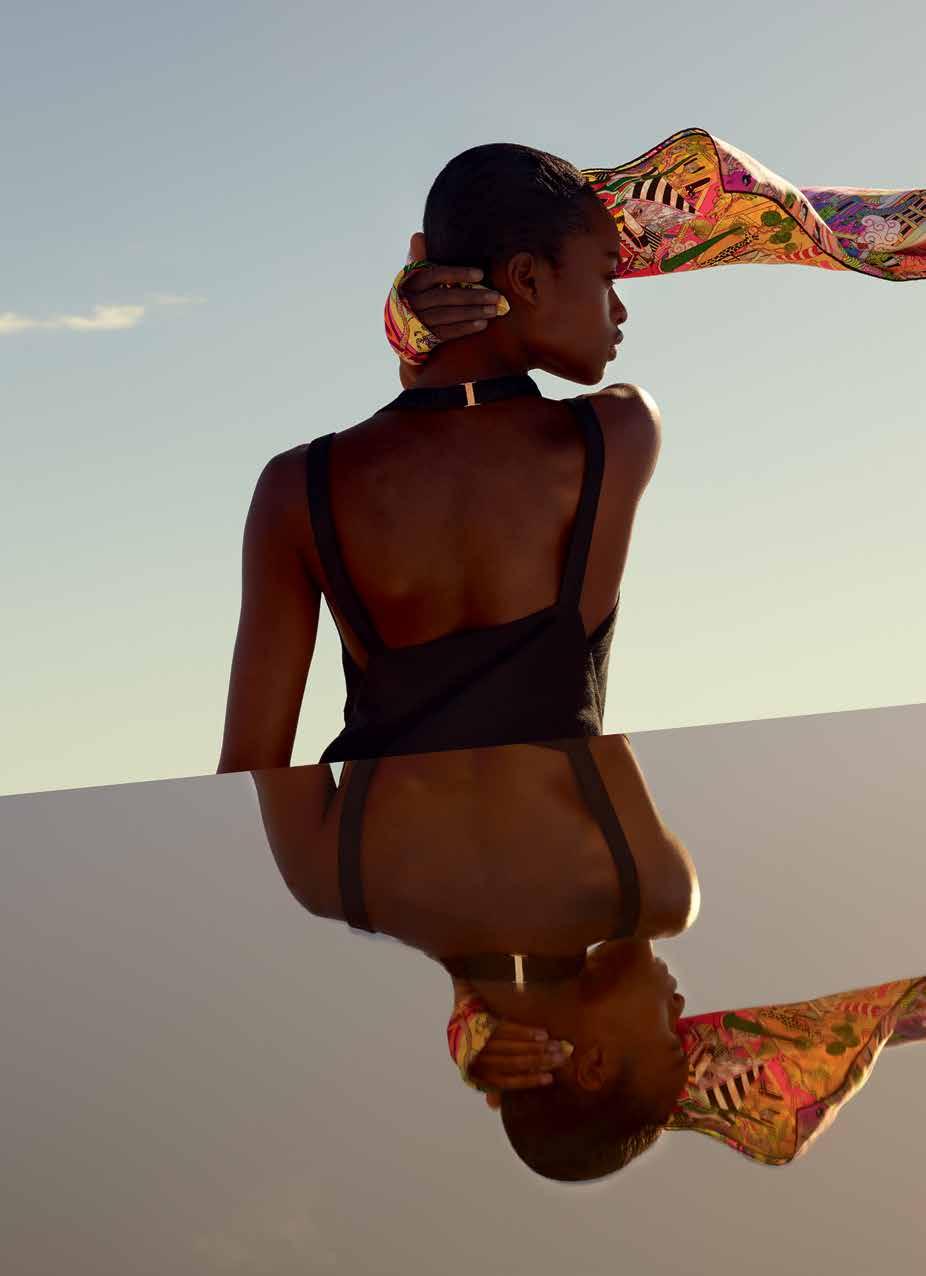
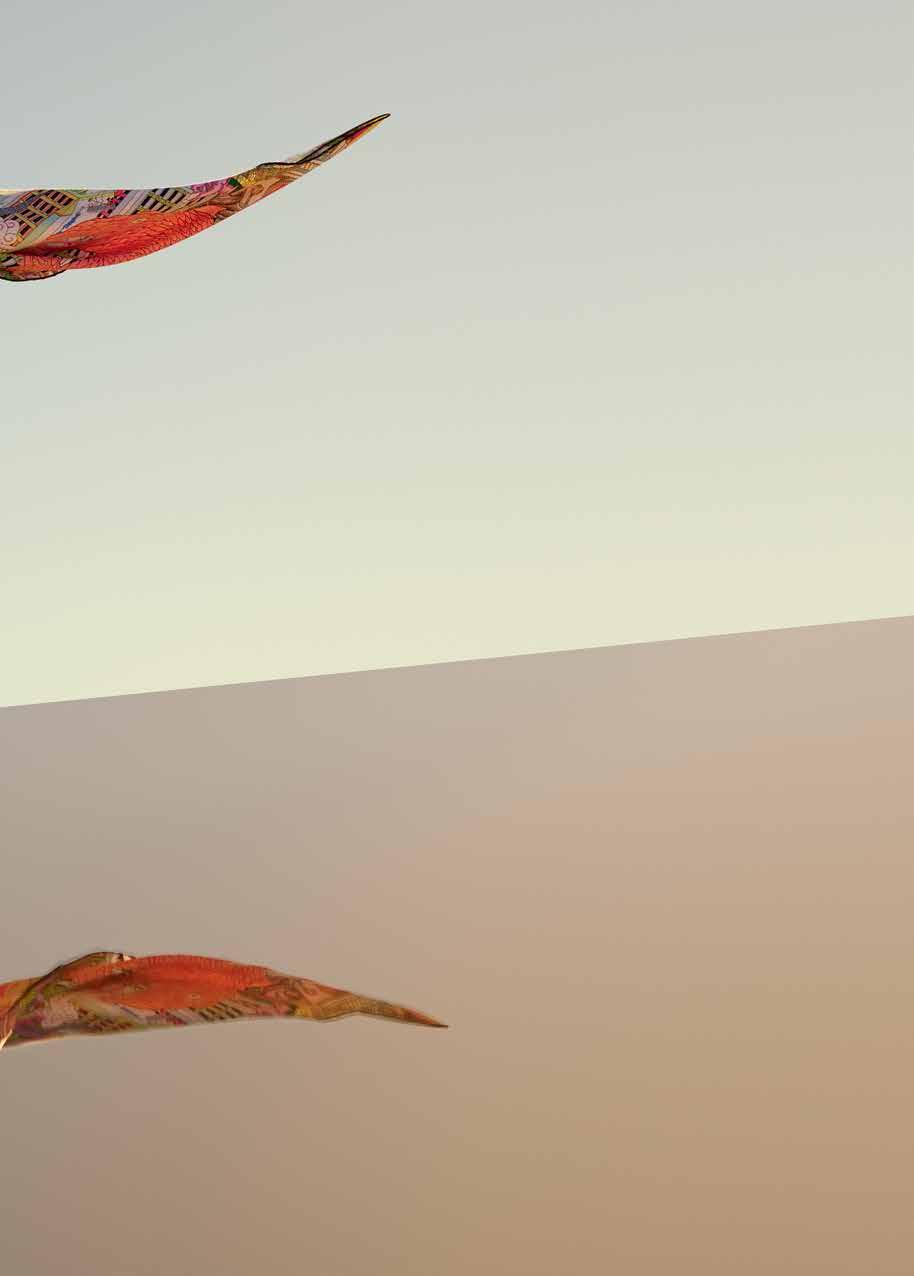


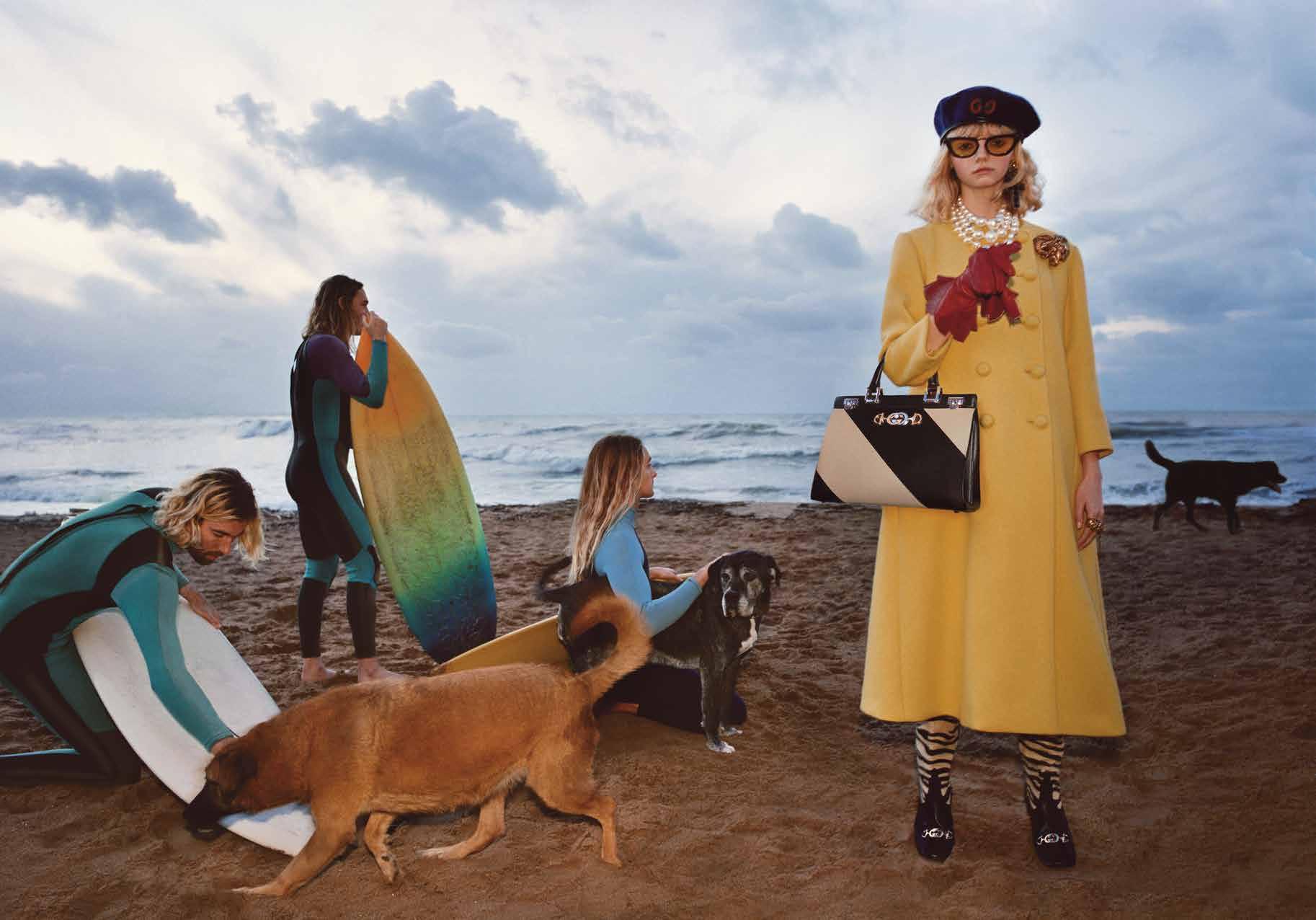

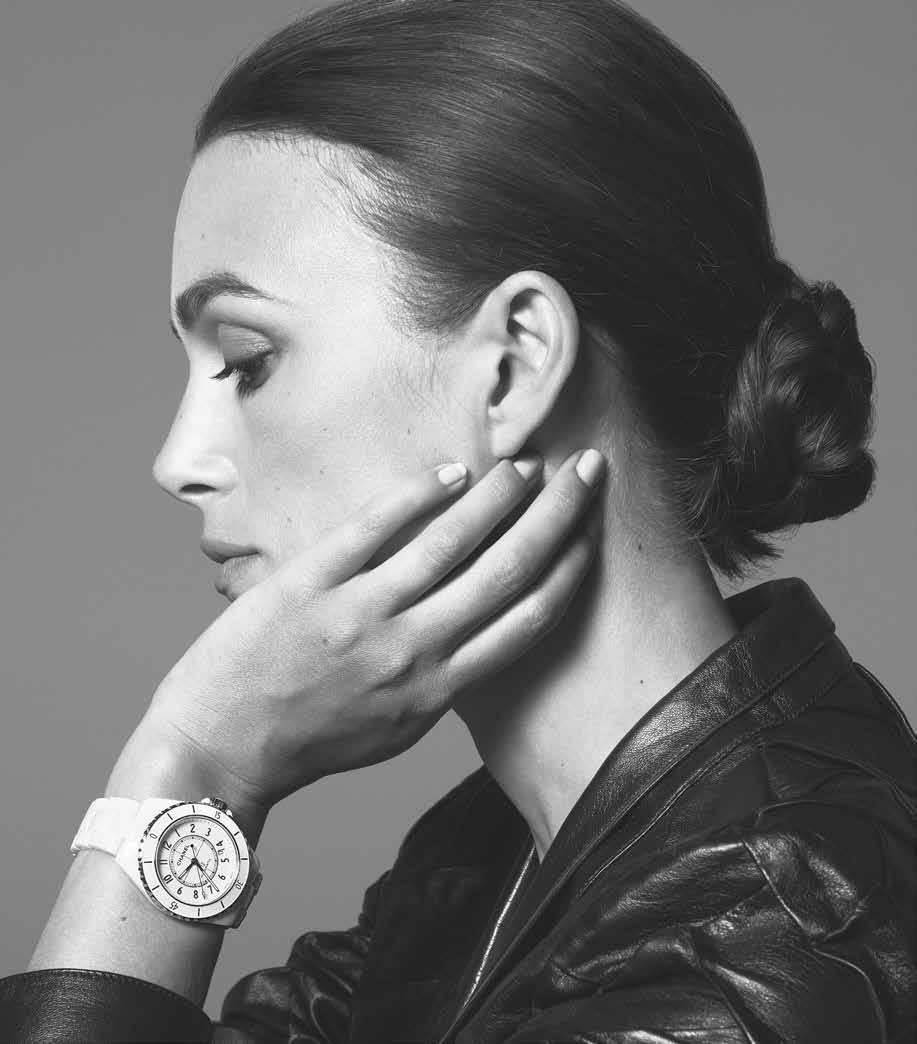 KEIRA KNIGHTLEY
KEIRA KNIGHTLEY

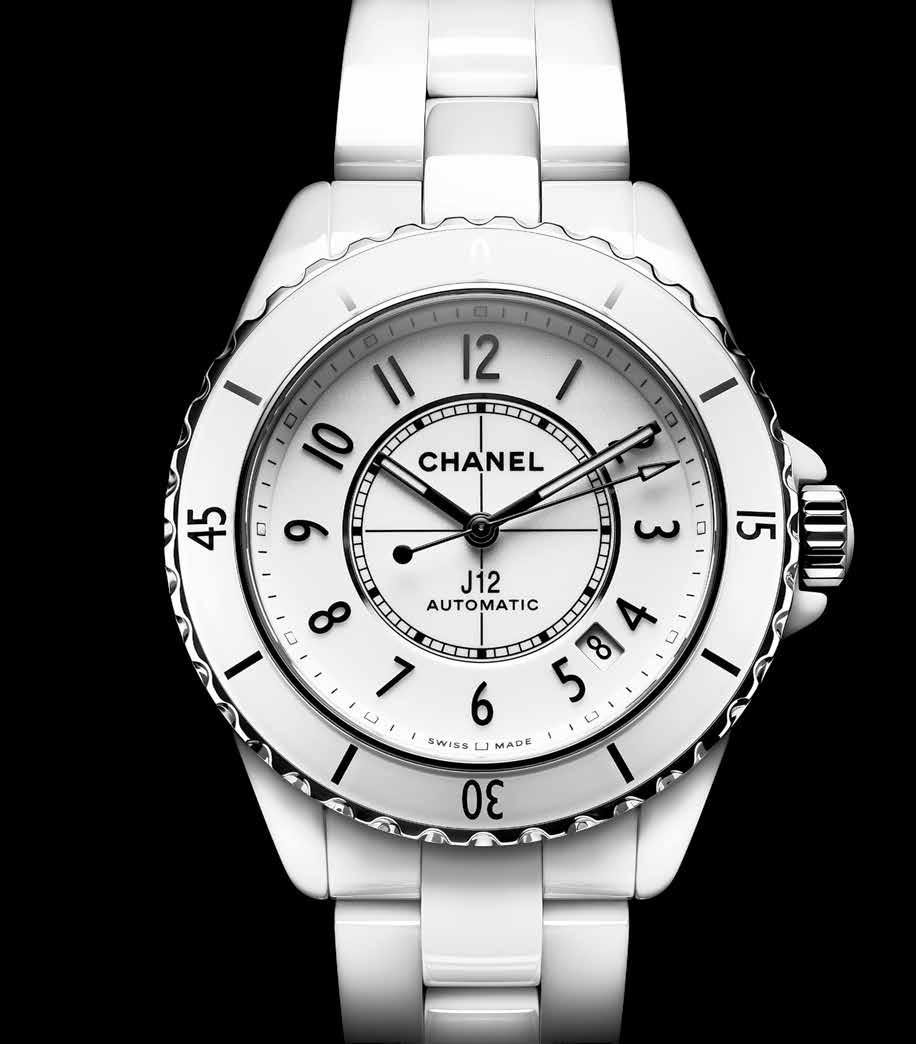
THE NEW J12 IT’S ALL ABOUT SECONDS New self-winding manufacture movement Highly resistant ceramic watch. Swiss made. 5-year warranty. WAIKIKI ALA MOANA CENTER 800.550.0005 chanel.com ©2019 CHANEL ® Inc.
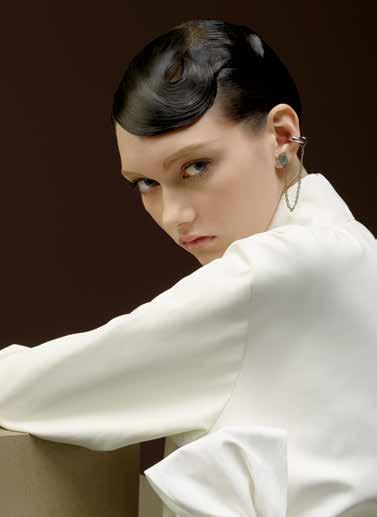
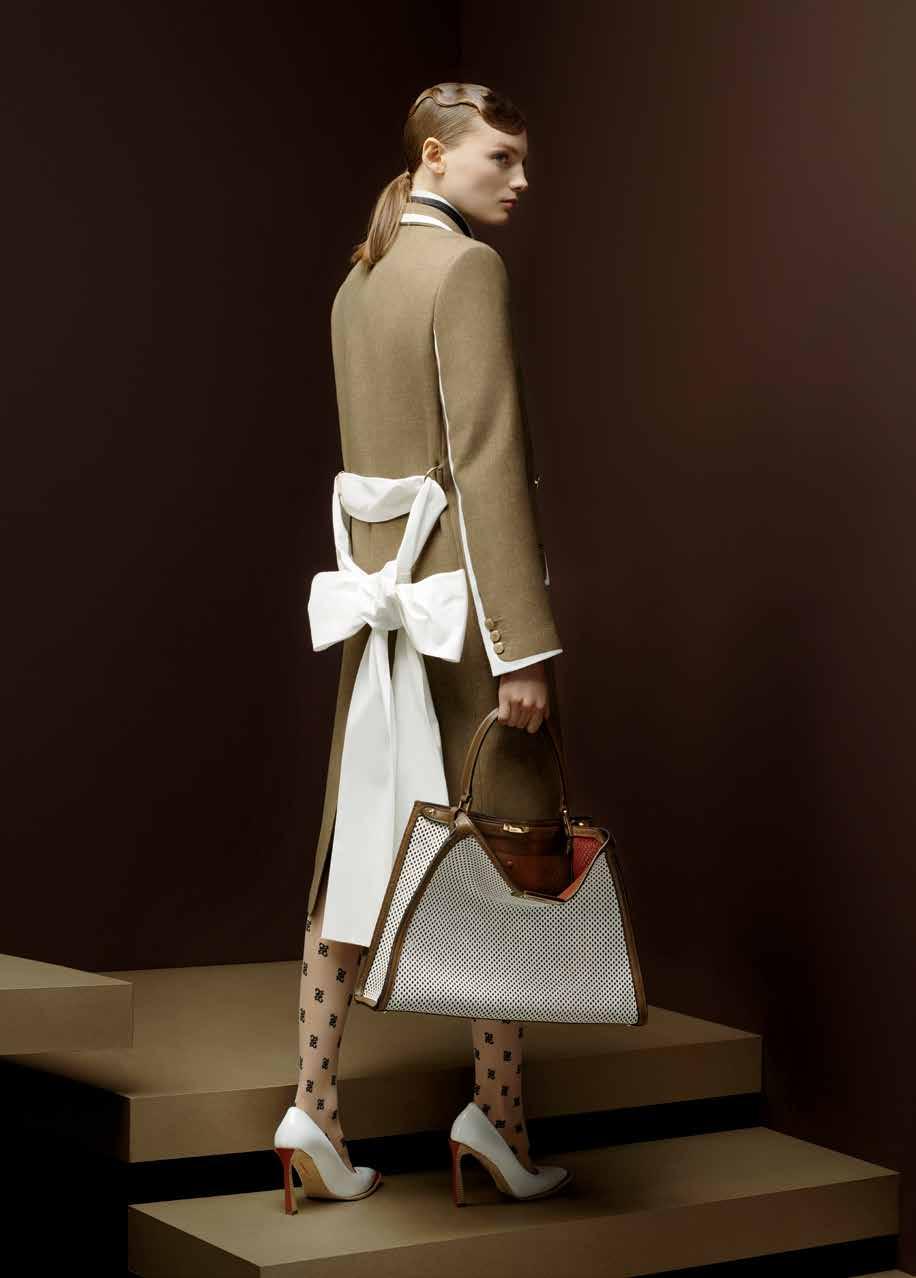


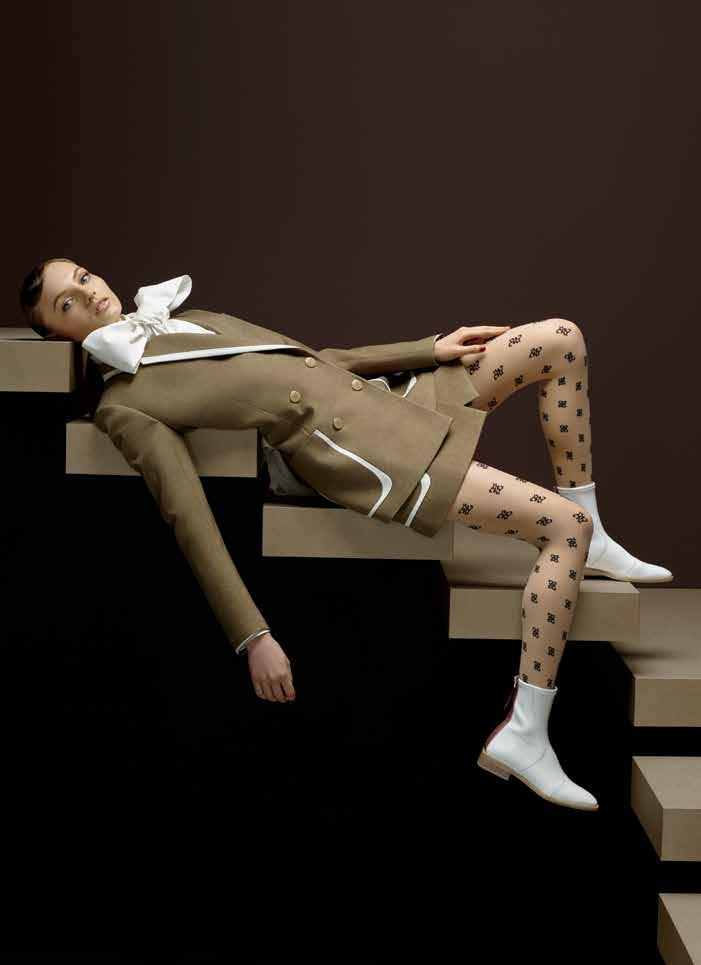
ALA MOANA CENTER F EN d I COM SCAN WITH THE FEN d I APP TO SEE EXCLUSIVE CONTENT
ROYAL HAWAIIAN SHOPPING CENTER
Millions of years ago, a hot spot at the bottom of the Pacific Ocean released lava, which solidified and built over time, eventually creating the islands we live on today. As lava continues to flow into the sea, new land is added to the ancient mold. Layers of time and nature make up the incredible construction of Hawai‘i.
Consider Hawai‘i’s culture and you’ll discover a similar structure. Over time, we’ve developed unique art forms, perpetuated and innovated old locations, and preserved historical items with new techniques.
We are continually building on the old in order to sustain it. In this edition of Palm, we embrace the concept of a layered culture, and with the insight of those who craft these complexities, we peel back the layers. Return to the familiar spots of Bishop Museum and Ala Moana Beach Park while looking out for digital and sculpture installations by New York artist Paul Pfeiffer. Stroll through Honolulu’s lamp-lit streets while searching for exciting speakeasies that are reworking the business model of the traditional bar. Enter the workspace of an island luthier as he restores vintage instruments and uncovers musical Hawai‘i history in the process. Set your sights on the charming assembly of neon lighting, reminiscent of the lava glow we know well.
To our community of homeowners, we hope this issue encourages you to delve into the layers of culture Hawai‘i has to offer and add an element of your own.
何百万年も昔、太平洋の海底にホットスポットが生まれ、そこか ら湧き出た溶岩がやがて海上に陸地を築き、ハワイの島々となっ ていきました。溶岩は流れ続け、新しい陸地を次々に作り出して います。悠久の時と自然の力が幾重にも重なり合い、驚くべきハ ワイの景観を形作っていったのです。
ハワイの文化にも、それとよく似た構造が見られます。何 世代もの時を経てハワイ独自の芸術様式が育まれ、受け継がれ、 古いものが新しく生まれ変わり、そして歴史あるものが新しい技 術によって保存されています。
私たちの文化は、古いものの上に築いていくことでその力 を保っています。今号の『Palm』マガジンでは、幾重にも重なり 合った文化に着目し、複雑な陰影を知る匠たちの視点を借りて、 その重層的な構造に分け入っていきます。まずは、慣れ親しんだ ビショップ博物館とアラモアナ・ビーチ公園を訪ね、ニューヨーク を拠点として活躍するアーティスト、ポール・ファイファーの作品 を鑑賞しました。夜のホノルルの街角では、近年ビジネスモデル として息を吹き返したスピークイージー(秘密酒場)を探訪。ま た、オアフ島の弦楽器工房を訪ね、ビンテージ楽器の修復を手が ける中で発見したハワイアンミュージックの知られざる歴史につ いて話を聞きました。さらに、まるで溶岩のようにどこか懐かしい 光を放つネオンサインの製作現場も訪ねています。 ホームオーナーの皆様が今号の記事を楽しみ、何層にも 重なりあったハワイの文化に触れるとともに、ご自身のハワイ生 活をさらに豊かに彩る何かを見出されますよう願っています。
12 LETTER From the Developer
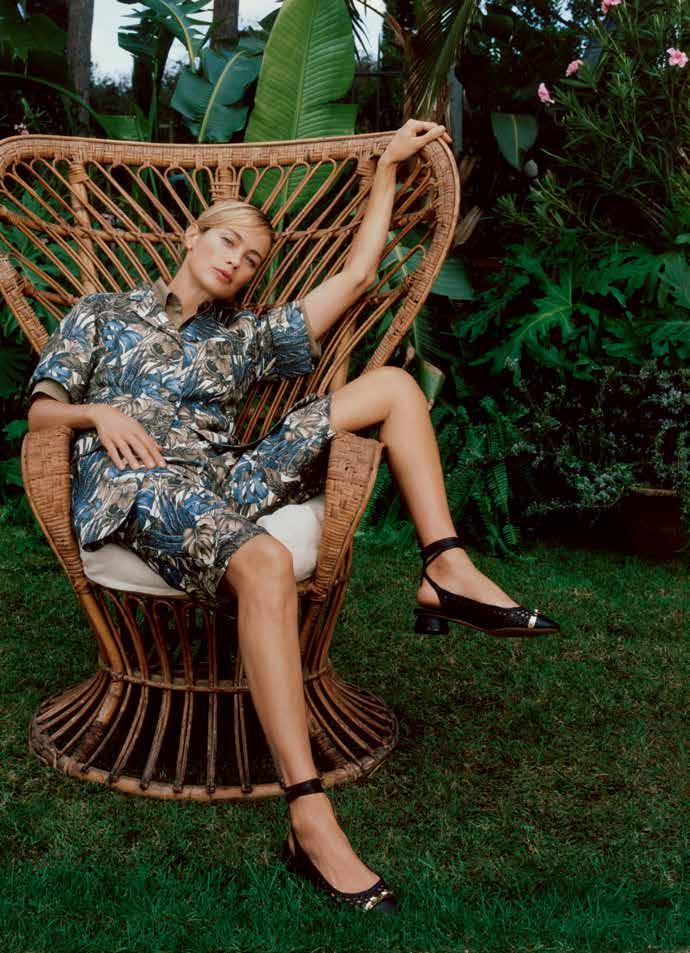
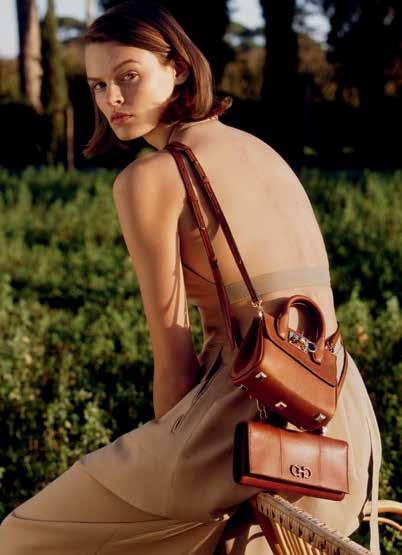
ALA MOANA CENTER FERRAGAMO.COM
CEO & PUBLISHER
Jason Cutinella
CREATIVE DIRECTOR
Ara Laylo
EDITORIAL DIRECTOR
Matthew Dekneef
MANAGING EDITOR
Lauren McNally
SENIOR EDITORS
Anna Harmon
Rae Sojot
PHOTOGRAPHY DIRECTOR
John Hook
PHOTOGRAPHY EDITORS
Samantha Hook
Chris Rohrer
TRANSLATIONS
Japanese Yuzuwords
Korean AT Marketing
PUBLISHED BY:
NMG Network
36 N. Hotel St. Ste. A Honolulu, HI 96817
PALM is published exclusively for:
CREATIVE SERVICES
Tammy Uy VP Creative Development
Shannon Fujimoto
Creative Services Manager
Gerard Elmore
Lead Producer
Shaneika Aguilar
Kyle Kosaki
Rena Shishido Filmmakers
Michelle Ganeku
Skye Yonamine Designers
Aja Toscano
Network Marketing Coordinator
Mutya Briones
Digital Marketing Manager
Kimi Lung
Web Designer & Developer
ADVERTISING
Mike Wiley VP Sales mike@nmgnetwork.com
Phil LeRoy National Sales Director
Chelsea Tsuchida Key Accounts & Marketing Manager
Helen Chang Marketing & Advertising Executive
Kylee Takata Sales Assistant
OPERATIONS
Joe V. Bock Chief Revenue Officer
Francine Naoko Beppu Network Strategy Director
Gary Payne VP Accounting
Courtney Miyashiro Operations Administrator
The MacNaughton Group & Kobayashi Group © 2019 by Nella Media Group, LLC. All rights reserved. No part of this publication may be reprinted without the written consent of the publisher. Opinions are solely those of the contributors and are not necessarily endorsed by NMG Network.
14
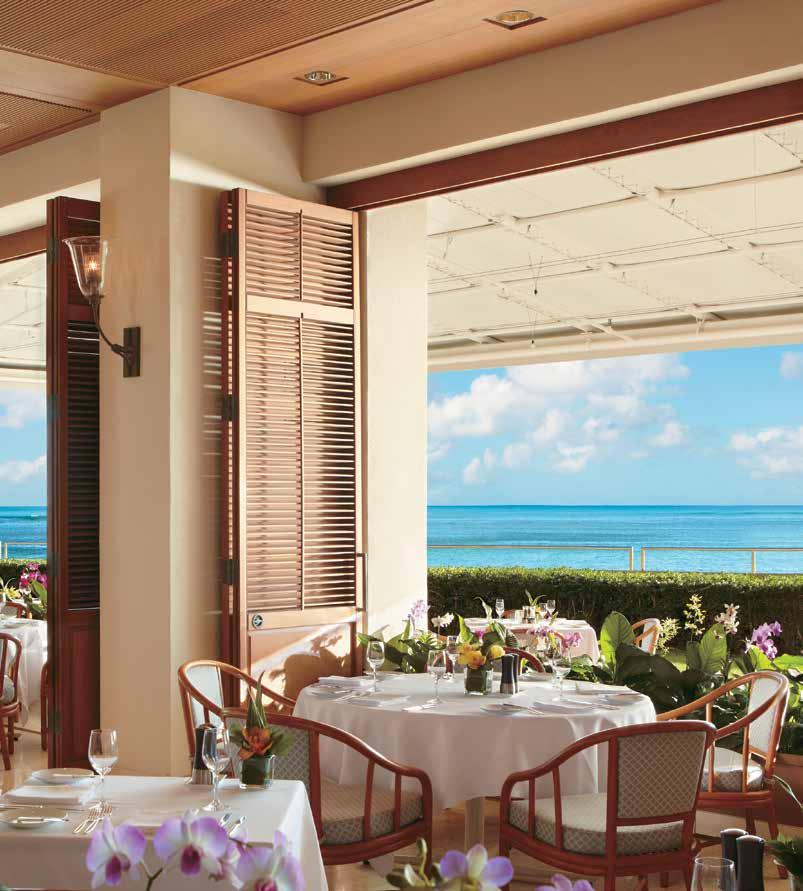
Publication: PALM - Full Run Date: Trim Size: Ad Size: Note: A will frame to create Colors: 4C DUE: 5/23/19 An Orchids Occasion WHERE EVERY DINING EXPERIENCE IS A SPECIAL OCCASION RESERVATIONS RECOMMENDED 808.518.2019 www.halekulani.com | 2199 Kalia Road, Honolulu | Complimentary Parking
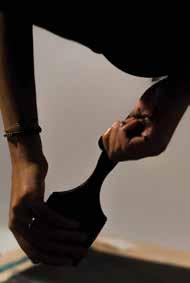
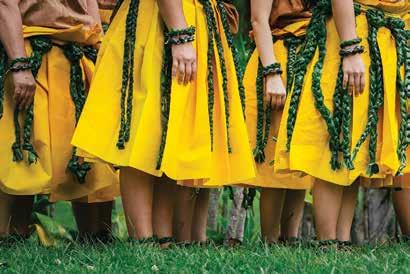
16 TABLE OF CONTENTS ARTS 22 Reality Bites 34 Good Times 44 Paint It Black BUSINESS 58 Cracking the Code DESIGN 72 Bending Light 82 Stringed Revival 94 Fashion: Country Solitude ESCAPES 116 Swiss Storybook 128 Heart of Hula FARE 142 Ensemble Performance 46 126 ON THE COVER
At the handsome Anekona House in Waimea, Hawai‘i Island with architecture professor Lance Walters, photographed by Mark Kushimi.





































































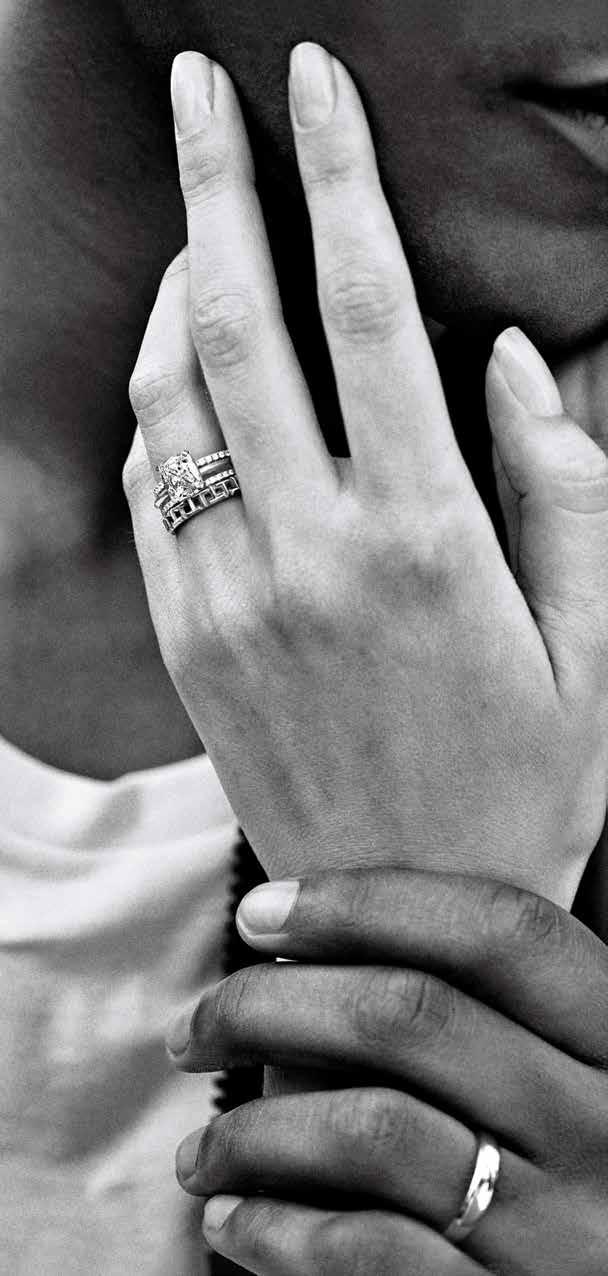
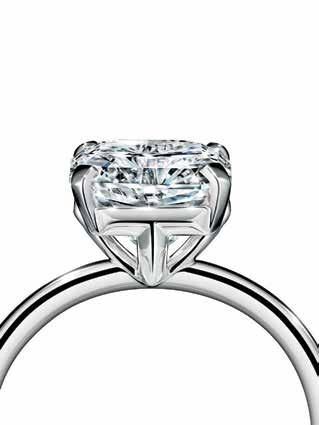
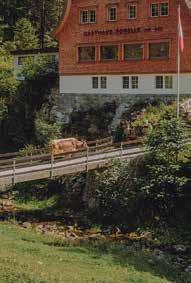
秘密の酒場 デザイン
弦が奏でる音楽
田園のソリチュード エスケープ
光の誘惑
表紙
ハワイ島ワイメアの端正な「アネコ
ナ・ハウス」にて。モデル:ハワイ大
学建築科のランス・ウォルターズ
教授。撮影:マーク・クシミ
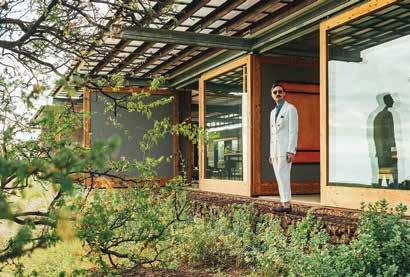
18 116 94 目次
22 リアリティの背後に 34
44
58
アート
ラインの外へ
黒く塗る ビジネス
72
82
94
116
128
食 142 アンサンブルの音色
おとぎの国、スイス
フラの魂

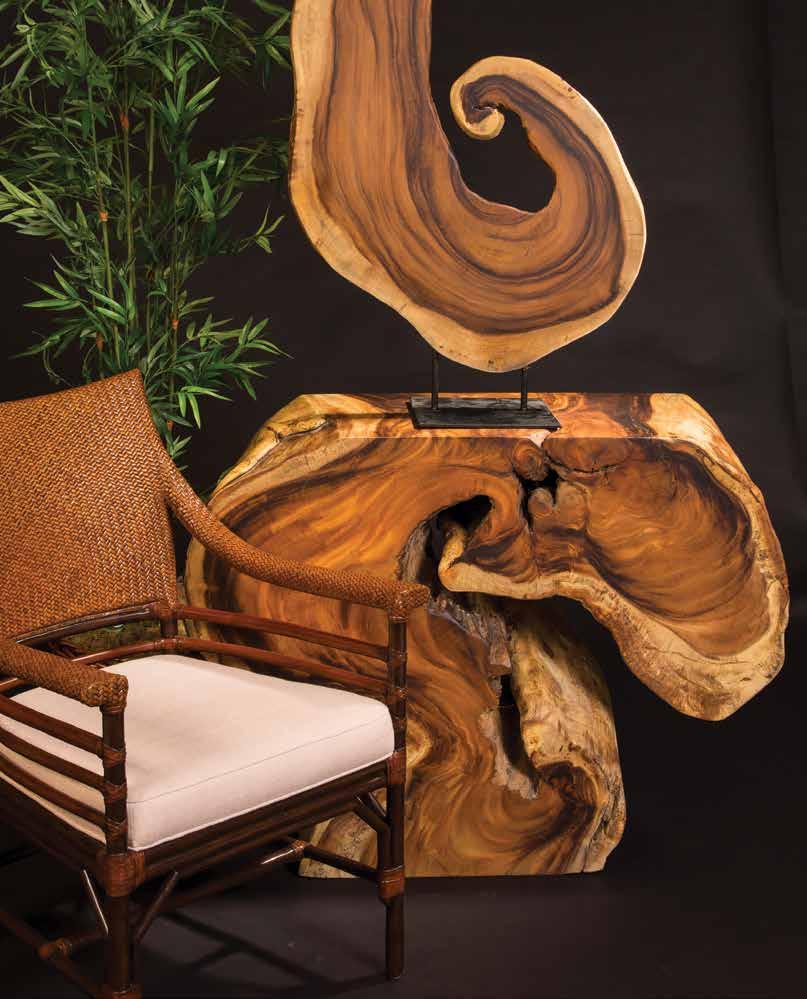
702 SOUTH BERETANIA STREET, HONOLULU, HI 808.543.5388 | CSWOANDSONS.COM
Visual that amplify
notions
AR TS
A PALM アート
CUL TU RE
of place that A sense fosters the human spirit
the soul of the city
PALM PALM A
21
Reality Bites
リアリティの背後に
Text by Noelani Arista
文 = ノエラニ・アリスタ
Images by Joey Trisolini and courtesy of Paul Pfeiffer
写真 = ジョーイ・トリゾリーニ、およびポ ール・ファイファーの好意により掲載
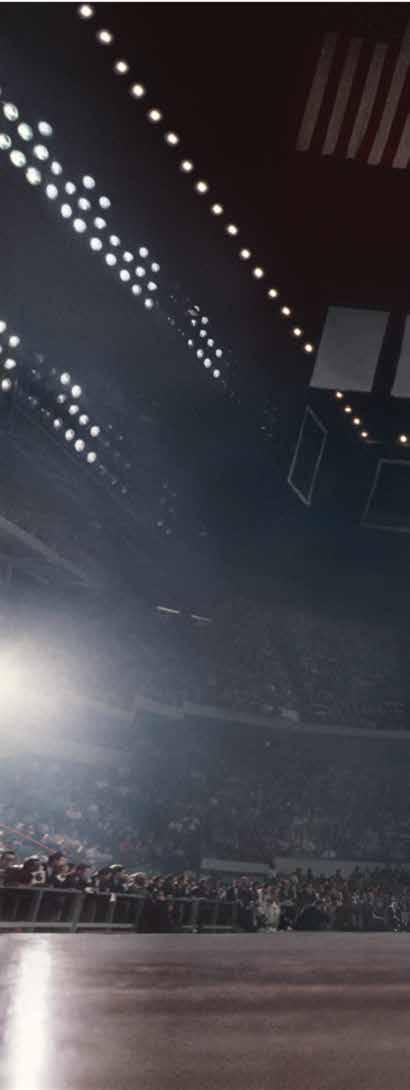
PALM
22 A ARTS Pfeiffer
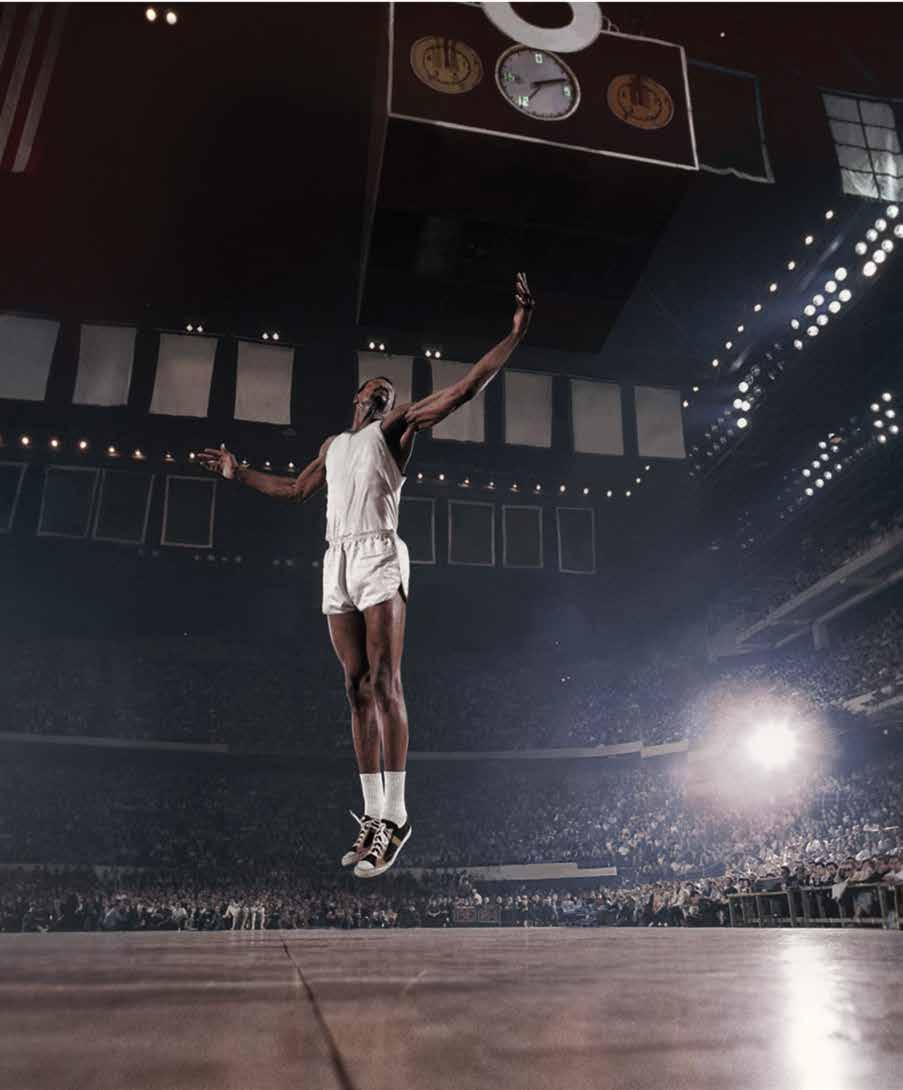
Video artist Paul Pfeiffer deconstructs viewers’ relationships to media and forms of entertainment that saturate the human experience.
ビデオアーティスト、ポール・ファイファーさんの作品は、メディアによる エンターテイメントが感覚と経験に及ぼす影響に光を当てています。
예술가 폴 파이퍼는 호놀룰루에서 태어난 선구적인 비디
오 아티스트이며, 최근 호놀룰루 비엔날레 2019년호를 위
한 사이트별 작품을 만들었다. 그의 사진과 조각은 컴퓨터
기술을 사용하여 대중 매체가 의식을 형성하는데 수행하는
역할을 해부합니다.
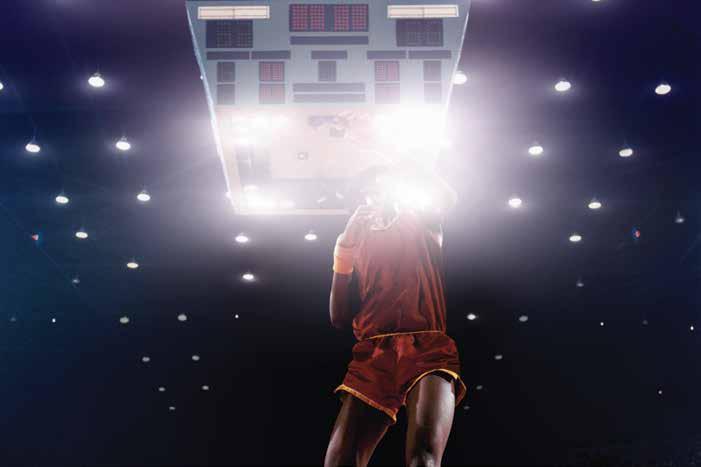
The cool interior of a large room doubling as an exhibition space at McCoy Pavilion offered welcome respite from the sun-soaked concrete pathways of Ala Moana Beach Park. My two sons and I took a seat in the womb-like space, ensorcelled by two large video screens positioned side by side but aimed off-kilter toward one another, both projecting artist Paul Pfeiffer’s video and audio installation Three Figures in a Room.
My eyes adjusted to the darkness. On the left screen, an elderly man, who spoke through subtitles, gleefully punched two red boxing gloves together. The man, who is a Foley artist, was reenacting the video on the right screen,
アラモアナ・ビーチ公園の日に灼けた舗道を歩いてきた後で、展示室を兼ね るマッコイ・パヴィリオンの客席は涼しく、快かった。どことなく子宮を思わせ る空間だ。2人の息子と共に客席につくと、互いに斜めの角度になるように設 置された大きな2つのビデオスクリーンに目を惹きつけられる。映像アーティ スト、ポール・ファイファーのインスタレーション作品『ThreeFiguresina Room(室内の3人の人物)』だ。暗がりに目が慣れてくる。左のスクリーンで は老人が何ごとかを語りながら、楽しそうに赤いボクシンググローブを叩いて いる。老人の言葉には字幕がついている。この老人はフォ-リー・アーティスト (効果音アーティスト)で、右のスクリーンに映し出されているボクシングの試
24 A ARTS Pfeiffer
PALM
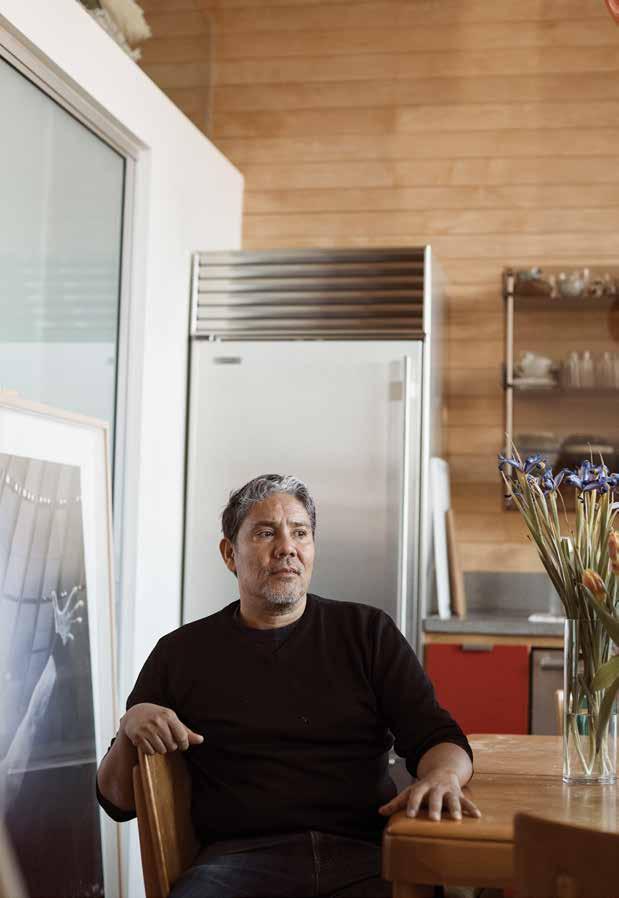 Paul Pfeiffer, at his New York City apartment. Opposite and opening spread, Four Horsemen of the Apocalypse , photographic Digital C-print on Fujiflex, by Pfeiffer.
Paul Pfeiffer, at his New York City apartment. Opposite and opening spread, Four Horsemen of the Apocalypse , photographic Digital C-print on Fujiflex, by Pfeiffer.
where Manny Pacquiao landed a terrific blow to the head of Floyd Mayweather in what was dubbed, in 2015, “the Fight of the Century.”
The silent screen on the right that showed the fight was visually striking. Together, the screens’ audio and visual nature bled into each other. To accomplish this confluence, Pfeiffer hired the two accomplished Thai Foley artists seen on the left screen, Chad “Lek” Mahapitchayakul and Thanasak “Nhae” Julaked, to re-record the sounds of the Pacquiao-Mayweather fight. The film of the men in their studio in Bangkok reveals the multi-layered relations inherent in the media production of delivering “reality” to a global audience. But I knew none of this yet.
Assembling my own meaning, I began making up a narrative: The old man was a former boxer reliving his glory days, I thought, and his family had settled him in front of the television, a screen as a pacifier. He was giving them a play-by-play of the fight. There was a microphone in front of him, and I tried to make out his language, his words, searching his surroundings for clues to where he was, what he was doing.
The process of being immersed in the unfolding action was curated by Pfeiffer: You are the third figure in the room. Each screen comprises separate realities. I had just superceded my surroundings, McCoy Pavilion, Ala Moana Beach Park, my family, giving all my attention to the old man, to Manny Pacquiao throwing the punch, to the opponent who just caught it in the side of the head, reeling. It happened without me thinking, without me giving permission. It happened without me knowing that I had momentarily displaced my identities.
And all of this happened without me sensing the architect of this abstraction, the thief of my time and life: video artist, photographer, and sculptor Paul Pfeiffer. Hawai‘i born, raised in transit between Hawai‘i and homes in the Phillipines, and later in Navajo territory, where he finished high school, Pfeiffer might be called “Pinoy-Haole.” Pfeiffer’s work for the 2019 Honolulu Biennial, which also included the 3D print and sculptural installation “Poltergeist” at Bernice Pauahi Bishop Museum, engaged audiences in considering the way in which modern, capitalist society manipulates our senses, affective and intuitive, without using words.
合を「再演」しているのだ。2015年、マニー・パッキャオがフロイド・メイウェザ ーの頭にパンチをお見舞いした「世紀の一戦」だ。
右のスクリーンは無音で、試合の強烈な映像を引き立ててている。2つの 画面の視覚と聴覚の効果が観客の前で一つに融合する。この効果を作り出す ため、ファイファーは2人のタイ人フォーリー・アーティスト、チャッド・「レック」 ・マハピチャヤカルとザナジャーク・「ナエ」・ジュラケドにパッキャオ対メイウェ ザー戦のサウンドを再録するよう依頼した。バンコクのスタジオで撮影された
2人のアーティストの姿は、世界中の観客に「リアリティ」を届けるメディア製作 の現場が持つ何層もの複雑な関係性をあらわしている。だが、私は最初、それ を知らずに、映像を見ながら自分の頭の中で物語を組み立てていた。
この老人はかつてボクサーで、昔の栄光の日々を思い返しているのだ、と私 は解釈した。そして家族が彼をテレビの前に座らせてやっているのだ、と。老 人は試合の実況中継をしているように見える。彼の前にはマイクが置かれてい る。私はタイ語で彼が語る内容を理解しようと努めながら、彼の周りにおかれ ているものからヒントを読み取ろうとした。何をしようとしているのだろう。
ファイファーはここで、画面の中で何が起きているのかを読み解いていく、 そのプロセスを作品に組み込んでいる。観客はこの部屋の3人目の人物なの だ。それぞれのスクリーンに、別々の現実が映し出されている。私はいつか、自 分を取り巻く環境(マッコイ・パヴィリオン、アラモアナ・ビーチ公園、自分の家 族…)を忘れて、注意のすべてを画面に注ぎ込んでいた。老人と、パッキャオの 繰り出すパンチ、それを頭に受けたメイウェザー。考えるでもなく、許可を与え るでもなく、いつの間にかそうしていたのだ。いわば、気づかないうちに、自分 自身のアイデンティティを入れ替えていたようなものだ。
そしてそのすべてが、抽象的なこのお膳立てに気づくことなく実現してい た。私の時間と注意力は盗まれていた。ビデオアーティスト、フォトグラフ ァー、そして彫刻家であるポール・ファイファーの企みによって。ハワイで生 まれ、ハワイとフィリピンで育ち、ナバホ居留地の高校を卒業したファイファ ーは、ハワイでは「ピノイ・ハオレ」(フィリピン系の白人)と呼ばれる存在だ。 2019年のホノルル・ビエンナーレでバーニス・パウアヒ・ビショップ博物館に 展示されたファイファーの作品『ポルターガイスト』は3Dプリントと彫刻を使 ったインスタレーションで、現代の資本主義社会がいかに私たちの感覚を、言 葉を介さずに情緒と直感を通して操っているかということを観客に考えさせる ものだった。
PALM 26 A ARTS Pfeiffer
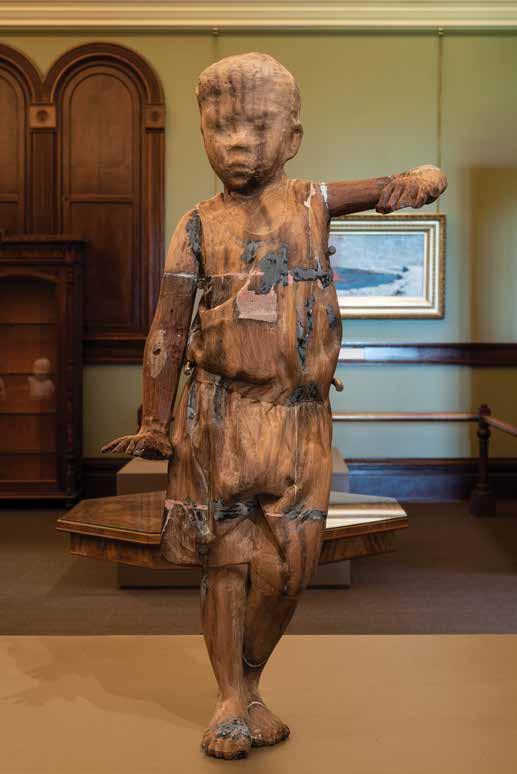
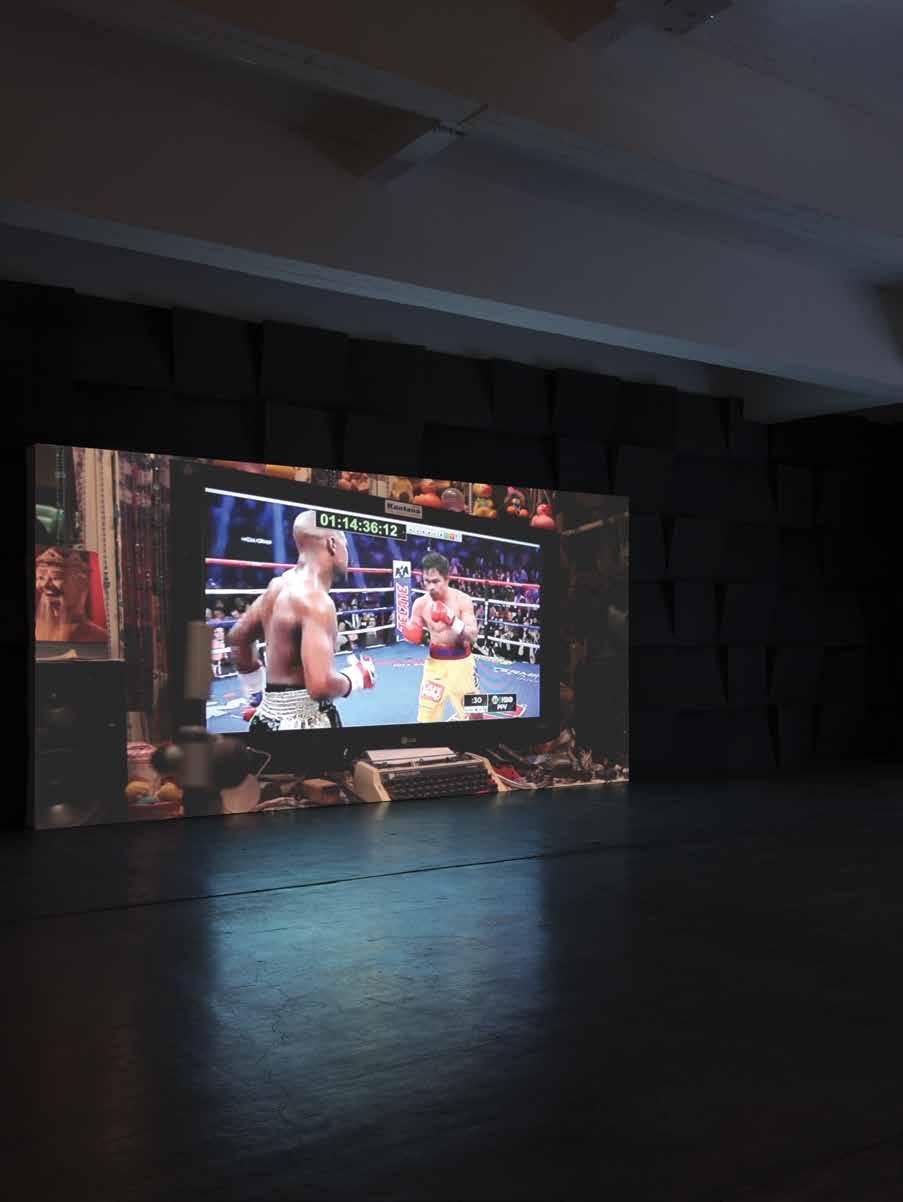
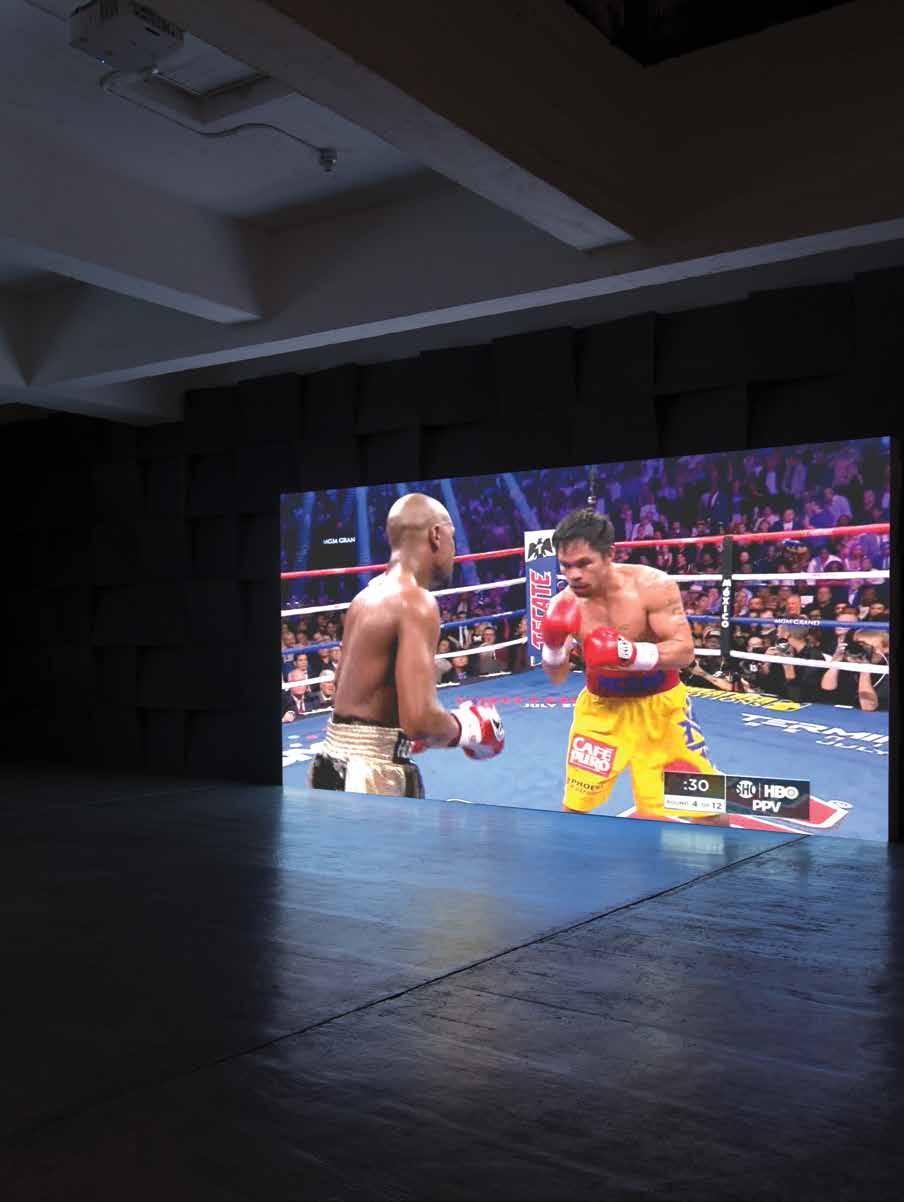
Mediating between the visual layers in his piece, I watched as the Thai Foley artists scrutinized the fight in order to supply the correct sounds for the haptic elements of dance the boxers artfully employed. I watched the audience in the MGM Grand relish each blow. I saw Pacquiao and Mayweather eyeing one another warily, each landed punch making me recoil in expectation, as if it were my body at risk. I looked to my children to see if the violence of flesh smiting flesh was affecting them in ways I could not yet see. I asked if they wanted to leave the room.
While watching Pfeiffer’s piece, seeing and hearing became elevated states of concentration. The artist influences viewers’ states from screen to screen. He is a maestro that changed me like channels on a radio dial. By supplying layers of participation, the artwork suggests that it is important to be attuned to the ways in which media manipulates our emotional states for its own purposes. Entertainment chips away at our tolerance for violence and consumption, numbing us to our own suffering, dulling or heightening our ability to empathize.
There are warnings to protect your eyes from being hurt by too much light on your cell phone, just as there are warnings about protecting your ears from music at a high volume. Yet there are no warnings to protect you from the way your emotions are played like an instrument, or attuned to resonate with invasive outside media stimulation. There are no warnings to protect you from the way split-second choices to engage in alternate realities twist or stunt our growth as individuals, as prospective lovers, as parents, as members of the community, routing our subjectivities away from lived relations in real time.
“I come from a printmaking background rather than a filmmaking background,” Pfeiffer commented when I described to him my experience of Three Figures in a Room. In printmaking, he explained, you divide an image into layers of color or layers of pattern or texture in order to produce the whole. “It’s a printmaker’s kind of subjectivity to think about how images or really reality exists in multiple channels or multiple layers.”
Pfeiffer noted that in Hollywood, everything in postproduction is synced so that “the viewer’s consciouness is guided seamlessly through the story.” By offering audience members the opportunity to engage with different, dissembled layers of media reality, Pfeiffer
この作品はいくつもの層をなしている。映像の中に、私はタイ人のフォー リー・アーティストがボクシングの試合を精密に解体して、ボクサーたちの華 麗な動き一つ一つの要素に合った音を作っていく様子を追った。MGMグラン ド・ガーデンに集った観客が試合に熱狂する表情を見た。パッキャオとメイウ ェザーが互いを用心深く観察するのを見、パンチが入るたびにまるで自分の身 体が攻撃されたかのように身をすくめた。私は息子たちを見やって、身体がぶ つかり合うこの暴力的な映像が彼らの上に何か予想できない影響を及ぼすの ではないだろうかと考え、部屋を出たいかどうか息子たちに尋ねてみた。
ファイファーの作品を見ている間、視ることと聴くことに普段よりもずっと 深く集中することになる。画面ごとに、アーティストの視点が観客の感じ方に 影響を及ぼすのだ。ラジオのチャンネルを替えるように、ファイファーは巧み に私たちの感覚を切り替える。いくつもの層で情報を受け取る仕掛けを通し て、この作品はメディアが特定の目的を持って私たちの感情を操作する、その 方法に目を向けることの重要性を示している。エンターテイメントは、暴力や 消費に対する私たちの許容範囲を広げていき、私たち自身の痛みを感じにくく させ、共感する力を鈍らせたり高めたりする。
目を痛めるので携帯電話の画面を見すぎないようにしよう、耳を痛めるの で大音量で音楽を聴き続けないようにしよう、という警告は目にするが、感情 を操作されることや、メディアによる刺激に簡単に共感しやすくなってしまうこ とから自分を守ろう、という警告を見ることはない。一瞬ごとに呈示されるたく さんの「現実」から、個人として、恋人として、親として、共同体のメンバーとして の成長を阻害されることから、自分の主観を実体験から切り離してしまうよう な流れから自分たちを守ろう、という警告はどこにも表示されていないのだ。
『室内の3人の人物』を見て感じたことをファイファーに話すと、彼は「私 は映像作家としてよりも版画作家としての背景に立って作品を作っているんで す」と語った。版画制作では、いくつもの色やパターン、テキスチャ別の層に分 けて作業をし、一枚の絵を作る。「イメージ、または現実が、複数のチャンネル やいくつもの層の中に本当に生きているのかどうか、それを考えるのが版画家 としての主観です」とファイファーは説明し、今や何もかもポストプロダクショ ンで処理されるハリウッド作品は「視る人の意識が常にストーリーに沿って導 かれる」ように映像が作られていると語る。
ファイファーの作品は、メディアが作る現実をバラバラに解体したいくつも の層を観客に意識させることで、私たちの視点をずらし、メディアの作り出す現 実をいかに私たちが受け入れやすくなっているかに気づかせる。彼の作品は、
PALM 30 A ARTS Pfeiffer
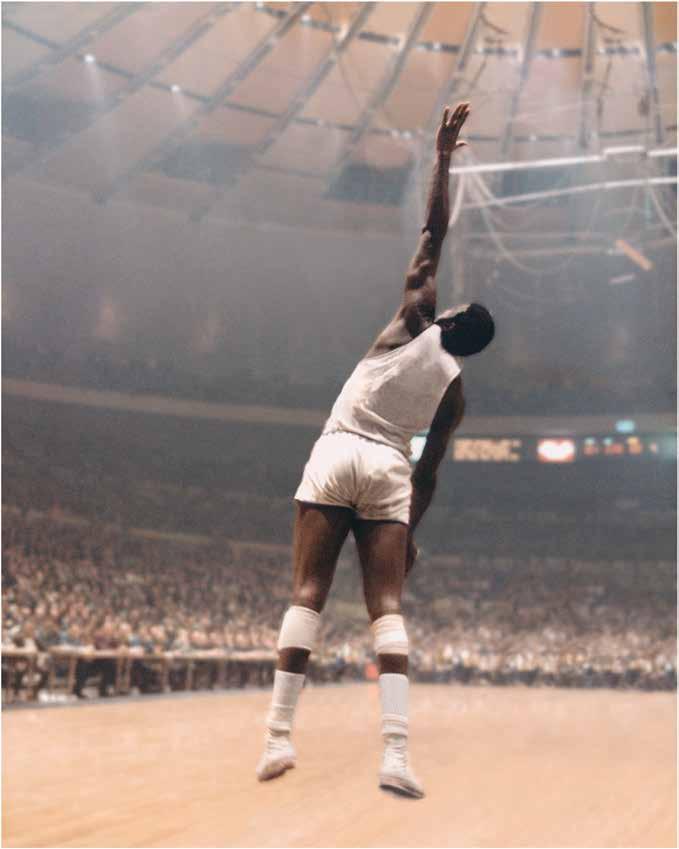 From Pfeiffer's photography series Four Horsemen of the Apocalypse
From Pfeiffer's photography series Four Horsemen of the Apocalypse
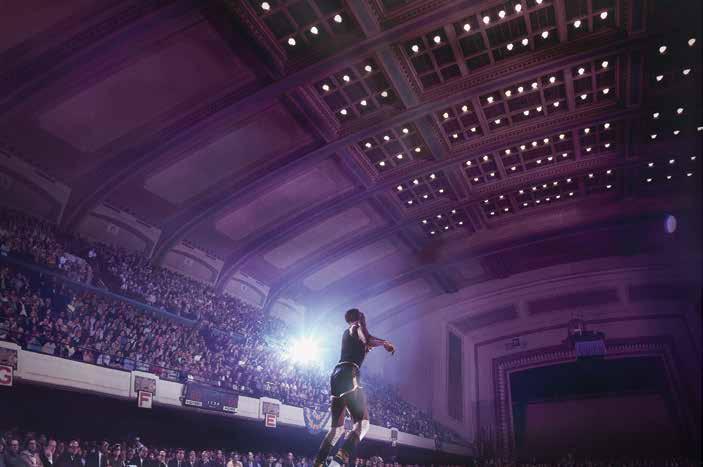
has opened up a disturbance in our perception, allowing us to see our susceptibility to synthetic media realities. His work reveals the effort it takes to displace one’s own relations and join the mediated reality of the TV screen, soundscape, and festival atmosphere of sports violence. Pfeiffer’s work shows that we have little agency as watchers, of onboarding portals of augmented, alternative, or virtual (un)reality via mobile applications, MP3s, music videos, gaming, television, and film. Each moment of engagement alters our inner state—like wind ruffling the feathers on a bird, we are changed. Pfeiffer’s work gives us a glimpse of our future, if we can pay attention long enough to the realities we inhabit.
視聴者が自分自身の感じ方を捨てて、テレビの画 面やサウンド、そして暴力性を含むスポーツと、そ れを取り巻く祝祭的な環境が提供する「現実」に置 き換えて行く様子を明らかにしているのだ。モバイ ルアプリ、MP3、ミュージックビデオ、ゲーム、テレ ビ、映画などが見せる仮想の現実、バーチャルな( 非)現実に対して、視聴者としての私たちには主体 を発揮する力はほとんどないということを、ファイフ ァーの作品は示している。一瞬ごとに「現実」を受 け止める方法によって、私たちの内部は変わってい く。風が鳥の羽毛をはためかせるように、私たちは 変化する。ファイファーの作品は、私たちの未来を 垣間見せてくれるのかもしれない。私たちが自分 の見ている現実に充分な注意を払い続けることが できるのなら、ではあるが。
PALM
32 A ARTS Pfeiffer
Pfeiffer was one of the participating artists at the Honolulu Biennial 2019.
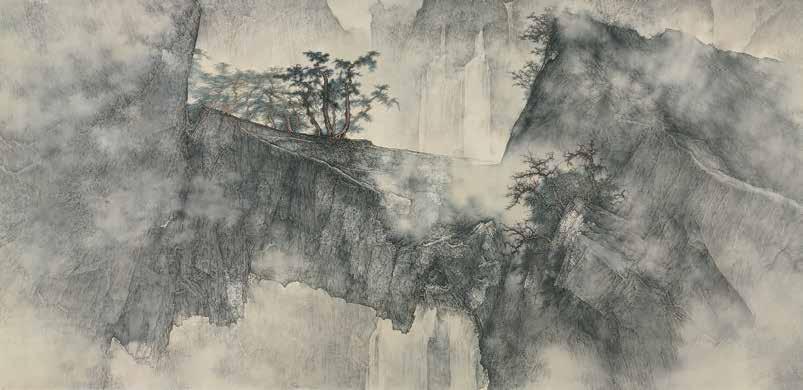
MUSEUMS • CAFÉS • THEATER • SHOPS 900 S Beretania St • 808.532.8700 honolulumuseum.org
ON VIEW AUG 24, 2019–JAN 5, 2020
THIS EXHIBITION IS MADE POSSIBLE WITH GENEROUS SUPPORT BY the E. Rhodes and Leona B. Carpenter Foundation, Maurice and Joanna Sullivan Family Foundation, Dr. Diane Chen Koch-Weser, Dr. Gene and Cecilia Doo, Donald and Laura Goo, Drs. Ernest and Letah Lee, Fred Sheng and Robert Oaks, Drs. William and Margaret Won and two anonymous donors.
MEDIA SPONSOR HOTEL SPONSOR
Li Huayi, Autumn Mountain/At the Edge of the Sky, 2007 Ink and color on paper. Yiqingzhai Collection (L2016-67.01)
Good Times
ラインの外へ
The comically unpinnable works of Kainoa Gruspe hide his serious grip on art history beneath a bravura of humor.
カイノア·グラスプさんの奔放でユーモアにあふれたアプローチは、従来のア ートの見方をくつがえします。
새로 등장한 호놀룰루 미술가 카이나로
아 그뤼스페의 독특한 캔버스는 손가락
그림의 전 영역을 대규모 아크릴로 운
영하고 있습니다. 예술작품에 대한 그
의 믿을 수 없을 정도로 재치있고 호기
심이 강한 접근법은 단번에 장난스럽고
파괴적입니다.
Text by Naz Kawakami Images by John Hook and Chris Rohrer and courtesy of Kainoa Gruspe 写真 = ジョン·フック、クリス·ローラー
文 = ナズ·カワカミ
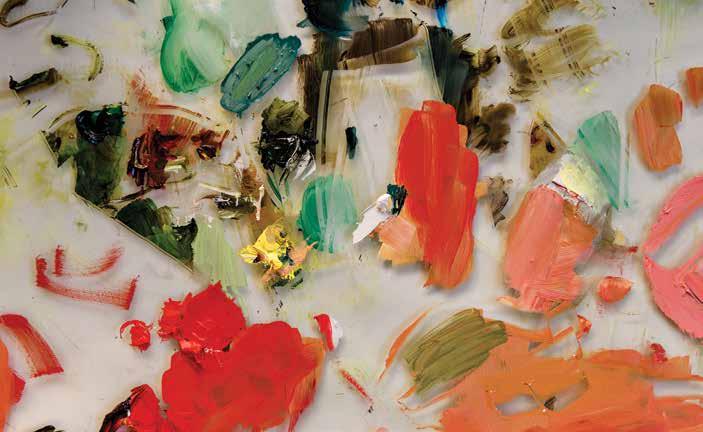
Imet Kainoa Gruspe skateboarding in a parking lot in Mānoa when we were teens. His hands were covered in black ink, the result of hours spent doodling in a notebook. His sweat, mixed with Mānoa’s misty atmosphere, caused the ink to bleed across his hands and onto his forearms. When we greeted each other with a high-five, his hand stained mine, which made an impression, as did his brash, unconventional skateboarding style.
私が初めてカイノア•グラスプに出会ったのは、私たちがまだお互いに10代 だった頃のこと。カイノアはマノアの駐車場でスケートボードをしていると ころだった。何時間もノートに絵を描いていたために彼の手はインクで真 っ黒で、汗とマノアの湿った空気のおかげで、そのインクが手から腕に流れ 出していた。ハイファイブの挨拶を交わすと私の手もインクで染まった。彼 の大胆で型にはまらないスケートボードのスタイルとともに、その出会いは 強い印象を残した。
PALM
34 A
ARTS Gruspe
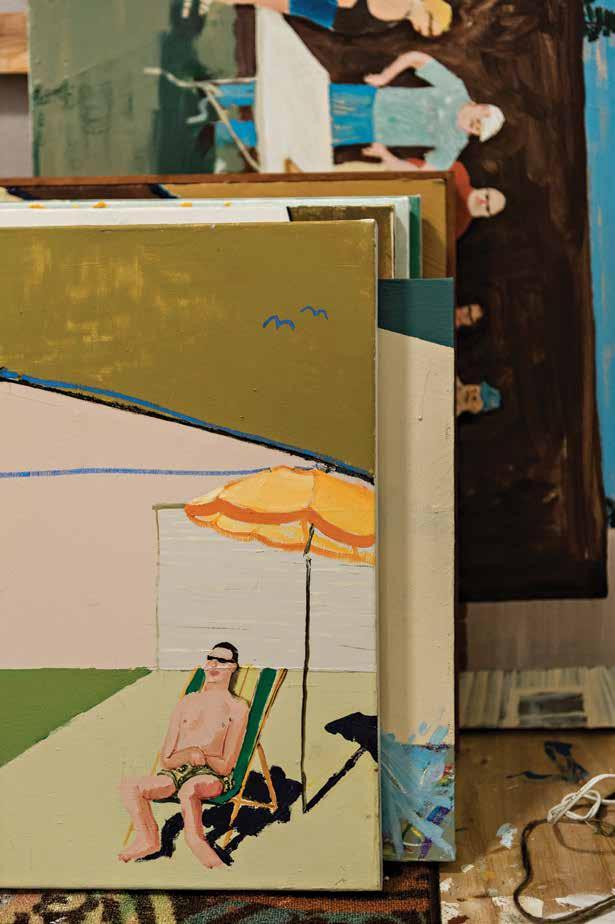
Gruspe was an avid doodler as a child. In his teenage years, his sketches mirrored his skateboarding, his pen lines beautifully unconstrained, complex, methodical. He drew the same subject—usually strangers and pedestrians in movement—over and over, layered on top of each other, not only capturing the subject’s likeness but also its motions and mannerisms.
While taking his first formal art course at the University of Hawai‘i at Mānoa, Gruspe added color to his ballpoint sketches. He used shades of house paint to fill out drawings on stacks of color swatches available to him at Home Depot, where he worked as a mixer for the paint department. On trips to the hardware store, I’d watch Gruspe sit with his head down, choosing art over good customer service, sketching on swatches while patrons waited impatiently.
Quickly, painting became Gruspe’s preferred medium. In 2016, at 20 years old, Gruspe had his first painting exhibit in the basement gallery of Hound and Quail in Honolulu’s Chinatown. Since then, Gruspe has been featured in more than a dozen solo and group shows, and he is regularly invited to show at places like Aupuni Space and the Hawai‘i State Art Museum.
The content of Gruspe’s work is versatile and ever-changing. His inspiration can shift from historical classics to family members to scenic views, often within the same collection. The focus of Gruspe’s work cannot be pinned down, even by him. When asked, “What do you paint?” his response is a pensive, “Umm.” When asked, “What am I supposed to do with it?” he answers, “I don’t know, think. Maybe laugh. I mean, sometimes you laugh.”
Gruspe isn’t a talker; he’s a laugher. His quiet disposition disguises a sharp sense of humor, which is infused in everything he creates. Gruspe is also a contemporary artist, leaning toward the abstract—his style is loose and playful, which he uses to comment on whatever he may view as being too fundamental, too
幼い頃のグラスプは常に夢中で絵を描いていたという。10代の頃の彼の スケッチは彼のスケートボードのスタイルに似て、ペンで描く線が自由でのび のびとしつつ複雑で、一定の秩序を持っていた。その頃彼がよく描いていたの は見知らぬ人々や道を歩く人たちで、同じ人物の動きを何度も重ねて描き、そ の人物の外見の特徴だけでなく彼らの動きや癖を捉えていた。
ハワイ大学マノア校で初めて正式な芸術の教育を受けた後、グラスプは自 分の描くボールペン画に色を加え始める。さまざまな色の家庭用ペンキで、色 見本の紙の束に描いた絵に色彩を加えたのだ。彼は色見本などの素材を、当 時アルバイトをしていたホームセンターのペンキ部門で手に入れていた。その 頃ホームセンターを訪れると、じれったそうに待つお客そっちのけで座り込み、 色見本の上にかがみこんでスケッチをしている彼の姿を見かけたものだった。 すぐに絵画はグラスプのお気に入りの表現手段となった。2016年、20歳のグ ラスプは、初の展覧会をホノルルのチャイナタウンにある「ハウンド&クエイル」 の地下ギャラリーで開催する。以来、個展とグループ展を合わせて10回以上 行い、「アウプニ・スペイス」やハワイ州立美術館などの会場で行われる美術展 に定期的に招待されるようになった。
グラスプの作品内容は幅広く、常に変化している。彼のインスピレーション の源は、時に同じコレクションの中でさえも、歴史的な古典作品、彼の家族、景 色というように変化し、作品の焦点は本人でさえも一つに絞ることができない。 もし「あなたは何を描くのですか?」と聞かれたら、彼は答えにつまることだろう。 「あなたの作品にどう反応するべきですか?」と聞かれたら、彼はこう答えるに 違いない。「わからないな…笑ったらいいんじゃないかな。誰だって、ときには 笑うことがあるでしょう」
グラスプは話し上手ではないが、よく笑う。もの静かな気質の下に隠され ているのは鋭いユーモアのセンスで、それは彼が創造するものすべてに染み込 んでいる。また彼は、抽象的な表現を好む現代アーティストでもある。彼から 見て基本的すぎたり、あまりに広く受け入れられすぎていたり、尊敬されすぎて いるものに対して、自由で遊び心に満ちた手法を使って意見を表明するのだ。
PALM 36 A ARTS Gruspe
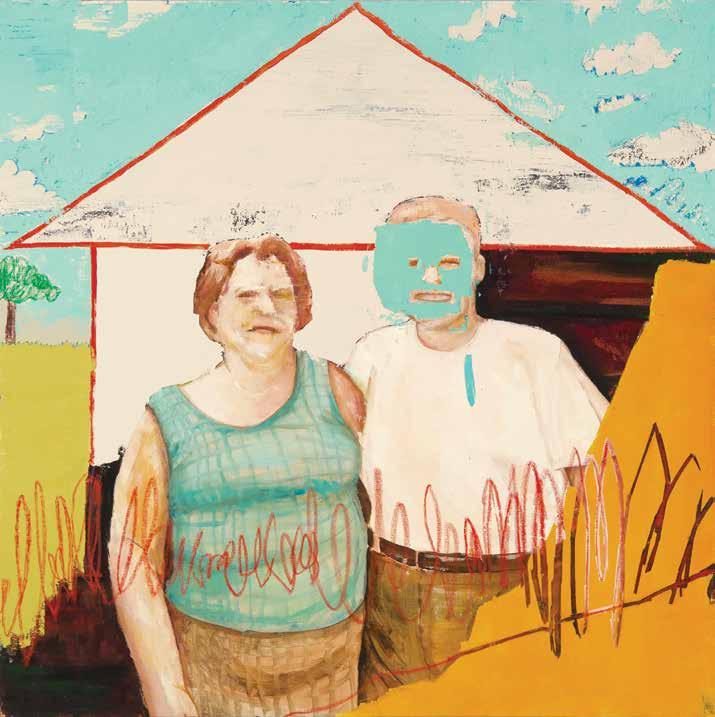 Two Figures with Carefully Planned Obstruction (2017) by Kainoa Gruspe
Two Figures with Carefully Planned Obstruction (2017) by Kainoa Gruspe
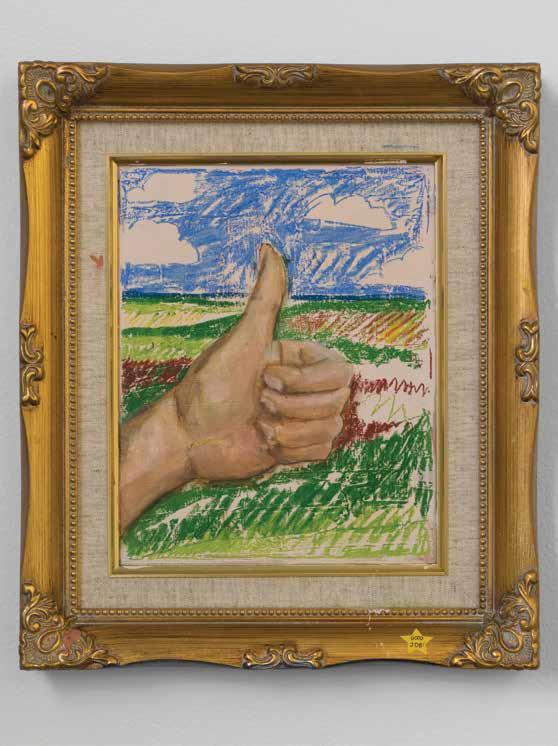
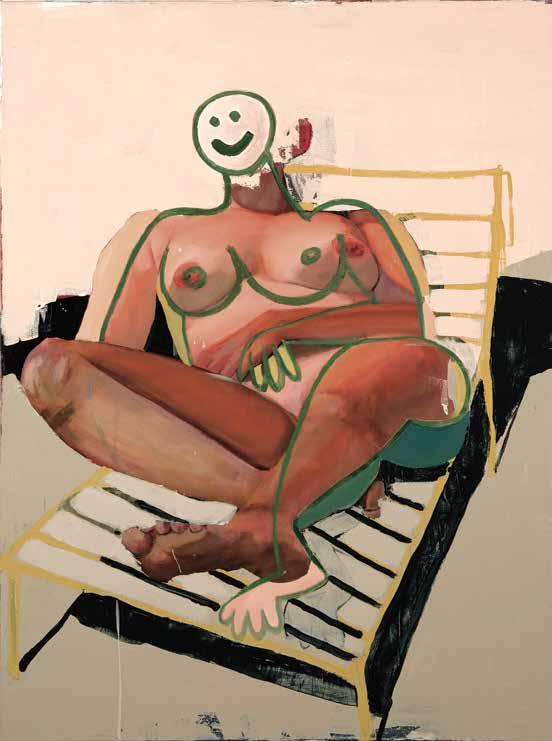
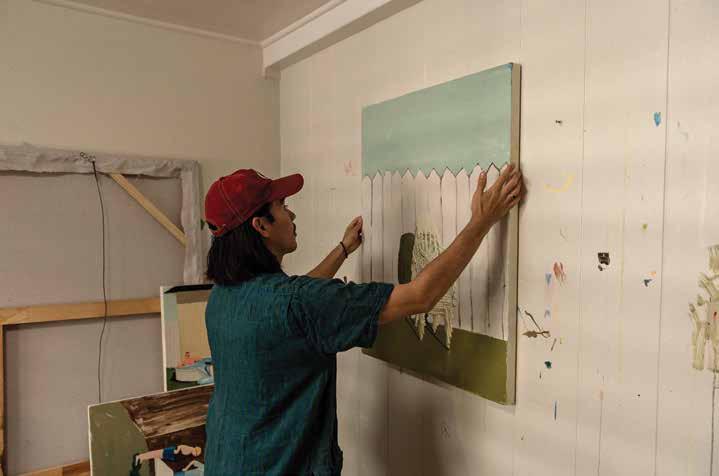
accepted, or too respected. He frequently employs irony and absurdity in his work, whether through alteration, like smearing faces on a reproduction of Grant Wood’s American Gothic, or taking the time to paint masterfully scenic paintings only to obstruct half of them with cement and thick strokes of grey paint.
In a more laborious and absurd case, he and his wife, Amber Khan-Gruspe, created a gigantic art work by drawing a continuous chalk line while walking from their home in Waikīkī to Hale‘iwa on O‘ahu’s North Shore. The piece, later titled Big Line Drawing (Chalk on Island, ½ inch by 2,090,880 inches) took two days and six boxes of chalk to create. Their journey was documented through photo, video, and a map diorama and was featured in the 2019 art event iBiennale in Honolulu. The meta-piece used its absurd size and scope to question what most would consider fundamental: What defines art? Or in this case, what defines a drawing?
Back when we were teenagers, whether it was skateboarding or drawing, Gruspe’s playful yet methodical style was distinctively his own. Now, as an adult, Gruspe has retained that originality while growing into an innovative and eclectic painter. His
彼の作品にはしばしば皮肉や不条理性が表現される。たとえばグラント・ ウッド作『アメリカン・ゴシック』を下敷きにした絵で人物の顔を塗りつぶ したり、時間をかけて見事な風景画を描いた後にその半分をセメントで覆 い、濃く太い灰色の線をつけたり。
より大がかりで極端な例として、彼が妻のアンバー・カーン・グラスプと 共に手がけた大規模な作品がある。2人がワイキキの自宅からオアフ島ノ ースショアのハレイワまで歩き、その過程でひとつながりのチョークの線を 描いた作品だ。後に『ビッグライン・ドローイング(チョーク・オン・アイラン ド、1.3センチ×53,108メートル)』と名づけられたこの作品の制作には2 日間と6箱分のチョークが費やされた。この超大作の制作過程は2019年 に開催されたアートイベント「iBiennale」で写真とビデオのほかにマップ ジオラマを使って展示され、その馬鹿馬鹿しいほどの規模で、多くの人にと って根本的な疑問を投げかけた。芸術を定義するものとは何か、もしくは この場合、絵画を定義するものとは何か、という問いである。 私たちがまだ10代だった頃から、対象がスケートボードでも絵でも、 グラスプは遊び心にあふれながらも秩序のある独自のスタイルを持ってい た。そして現在の彼は、そのオリジナリティーを保ちつつ、受けた教育を生 かしてさらに進化し、幼い日々に培ったスケッチのスタイルを基盤に、革新 Kainoa Gruspe in his studio.
PALM
40 A ARTS Gruspe
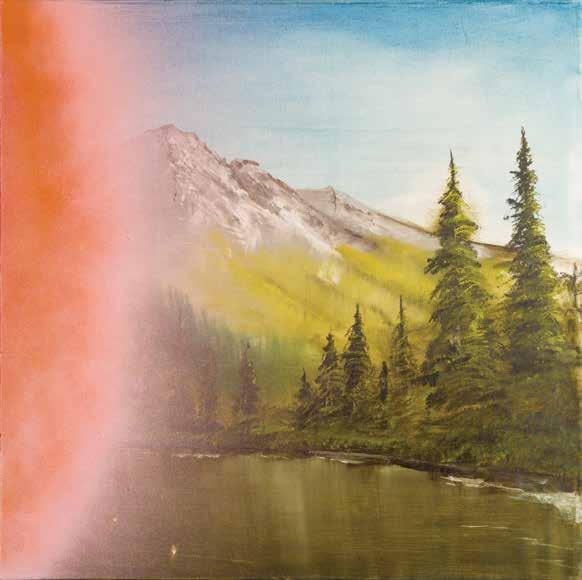
20% Obstructed (2018), from the series Finger Paintings
Landscape,
Landscape With Landscape (2017)
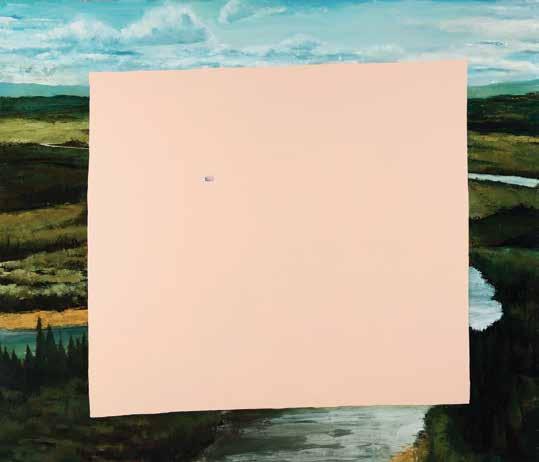
work is simple yet compelling. Whether it makes you giddy with laughter or shrug in confusion, his work is thought-provoking. Gruspe’s art, though sometimes mistaken for childish, displays the essence of representational painting with its color balance and composition; each component assesses and comments on what exactly makes a painting “good.”
“Art is taken so seriously. Too seriously,” Gruspe says. “At the end of the day, it’s just paint. Don’t take it so seriously. Have fun.”
的でさまざまな要素をあわせ持つ画家に成長し、 活動の幅を広げ続けている。彼の作品はシンプル だが、人の心を動かす。大笑いさせられるにして も、困惑させられて肩をすくめるにしても、思考を 刺激する作品であることは確かだ。グラスプのア ートはしばしば幼稚だと誤解されるが、実際には 色彩のバランスや構成といった面で具象絵画のエ ッセンスを表している。一つひとつの構成要素が、 「良い」絵とは何かを問いかけるのだ。 「アートは真面目に受け止められすぎてると思う。 あまりにも真面目すぎる」とグラスプは語る。「結 局のところ、ただの絵なんだから。そんなに真面目 に考えすぎずに、楽しんでほしいな」
PALM
42 A ARTS Gruspe


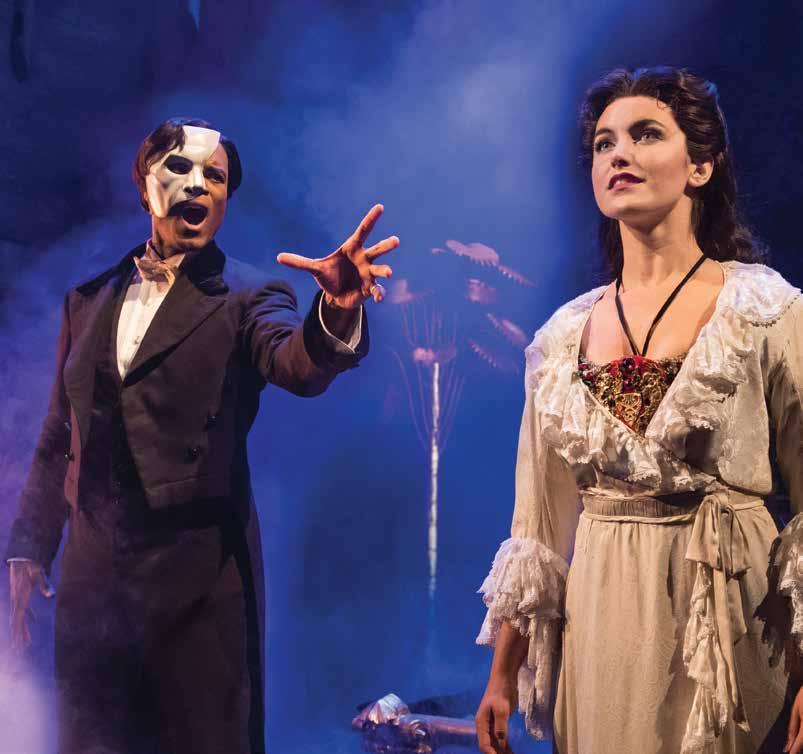
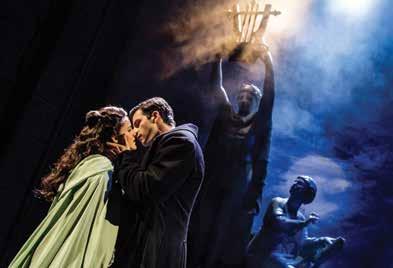
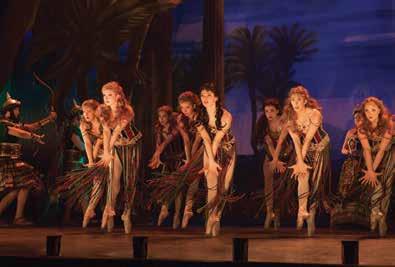
To place an order, or more information on season and group tickets, visit broadwayinhawaii.com
AUG 7–SEP 1 BLAISDELL CENTER
Top, Derrick Davis and Eva Tavares; Bottom Left, Eva Tavares and Jordan Craig; Bottom Right, The Corps de Ballet in Phantom, Choreography by Scott Ambler. Photos by Matthew Murphy.
Paint It Black
Text by Natalie Schack
文 = ナタリー・シャック
Images by Vincent Bercasio
写真 = ヴィンセント・バーカシオ
PALM 44 A ARTS Bassous
黒く塗る
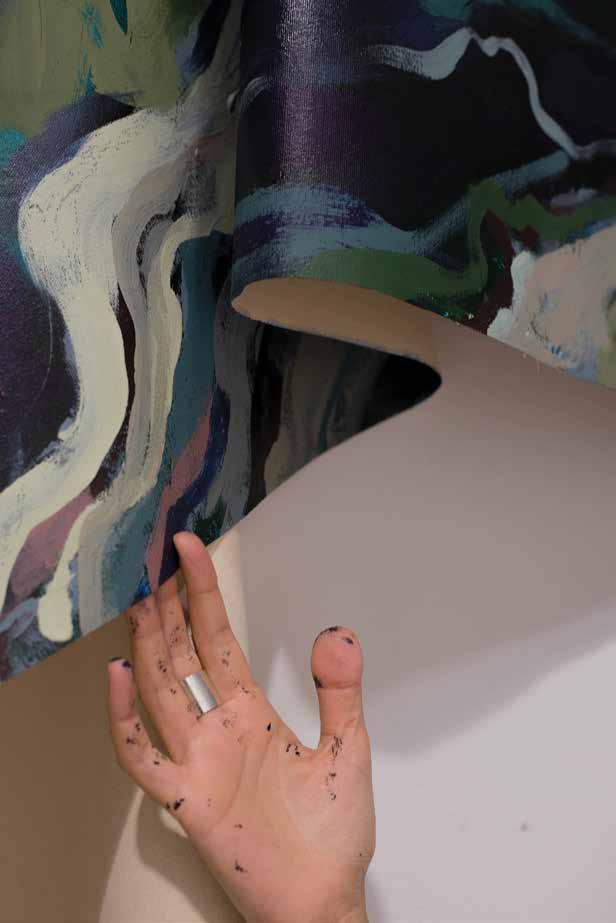
In memorializing landscapes and experience, artist
Reem Bassous isn’t afraid to settle into the shadows of memory and consciousness.
アーティスト、リーム・バスースさんは、記 憶と意識の底にある暗闇に恐れることな く向き合い、苦難に満ちた過去の風景を 形にしていきます。
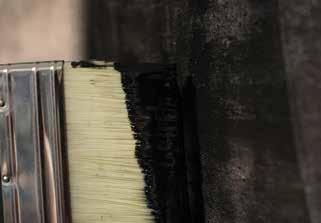
“ ‘
If you’ve had a normal childhood, then fireworks are enjoyable,” says artist Reem Bassous. “But for the rest of us, they’re not.” Bassous is remembering a poem. She’s paraphrasing “No Explosions” by Naomi Shihab Nye, as she sits among stacks of canvases and paint-splashed walls in her Kaka‘ako studio at Lana Lane Studios. She is thoughtful, warm and subdued, with a gentle grace, welcoming me into her space with a spread of pastries and coffee. She exudes a sense of peace, even as she sits among her work: walls of undulating black, grotesquely pained and distorted portraits, abstractions of suffering, war, death, sorrow— things that haunt her past, and why she identifies so much, personally, with Nye’s poem. “I have a hard time with fireworks,” Bassous explains. From 1982 to 1990, when she was in her early teens, Bassous lived in Lebanon during the country’s civil war, a violent, tumultuous time punctuated by bombing, chaos, and death. “I remember, they would have to close school because there would be heavy shelling for a couple of weeks. And then we’d come back and we’d have a student in our class who passed away. And we never really talked about these things. It was so normalized because it happened so frequently.” Memories and events from those early years are still pervasive in her mind, coloring her entire life and, of course, her work.
「ごく普通の子ども時代を送った人には、花火 は楽しいものでしょう」と、リーム・バスースさん は語る。 「でも、私たちのような者にとっては そうではないんです」
バスースさんのこの言葉は、ナオミ・シー ハブ・ナイの詩「NoExplosions」の内容を言 い換えたものだ。彼女が座っているのはカカア コの「ラナ・レーン・スタジオズ」にある仕事場。 まわりには何枚ものキャンバスがうず高く積ま れ、壁には絵の具が飛び散っている。バスース さんは思慮深く、温かく控えめな人柄で、優し い物腰で私をスタジオへ迎え入れ、ペストリー とコーヒーをすすめてくれた。バスースさんは 穏やかな空気をまとっているが、彼女の周囲に 置かれている作品には、のたうつような黒、グロ テスクに歪んだ人物の肖像、抽象的に表現され た苦しみ、戦争、死、嘆きが満ち、彼女が乗り越 えてきた過去を語っている。彼女がナイの詩を とても身近に感じるゆえんだ。「私は花火が苦 手なんです」とバスースさんは言う。
それも当然のことだ。1982年から1990 年まで、12歳になるまでの8年間、バスースさん は内戦中のレバノンで暴力と動乱の時代を生 き、爆撃と混乱と死を目にしてきた。「砲撃が激 しくなるというので、学校が2週間ほど閉鎖さ れたのを覚えています。学校が再開されて戻っ てみると同級生の一人が亡くなっていました。 そういうことについて私たちが話し合うことは 決してありませんでした。…あまり頻繁に起こる ので、ごく普通のことになってしまっていたんで す」。当時の記憶や出来事は今でもバスースさ
Reem Bassous at her studio in Kaka‘ako.
풍경과 경험을 기념하는 데 있어서, 예술가 렘 바수스는 기억과 의식의 그림자에 안주하는 것을 두려워하지 않습니다.
46 A
ARTS Bassous
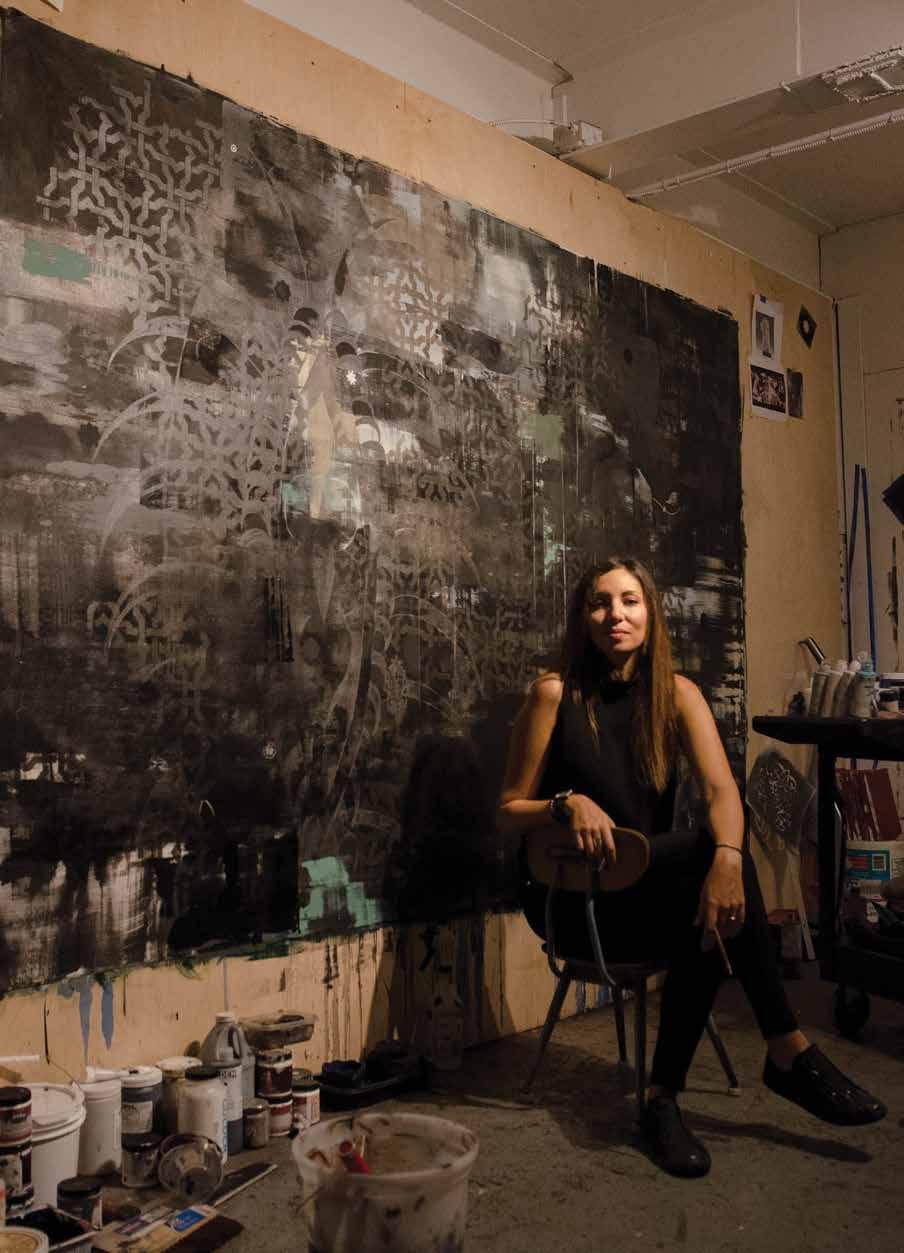
Lately, that means paintings that make heavy use of the color black. So much black, in deep swaths over canvases the sizes of walls, exposing gradations of shades as if challenging themselves to get blacker. And, also, red. Dripping and sweating down the sides of portraits like open arteries. Shocks of red slashed over mournful, imploring faces like so many lacerations.
Her series of portraits titled Moribund Outlivers is years in the making. We page through them: canvases of melting faces, one after another, in a nightmarish assembly line. Some of the faces are mournful, some vicious, some resigned, all distorted. “You just start to think that these survivors were not these fully intact human beings,” she says. “Almost one step removed from humanity. It has to do with a lot of things: Survivor’s guilt. Just the fact that war alters you. Some people were participants in combat, who just are completely changed after that. There’s the victim, there’s the aggressor— there’s all these different roles that these survivors play. Moribund means you’re nearing death and outlivers, [meaning that] basically, you’ve lived past your expiration date.”
Bassous’ painting is explorative, always rich with such contemplative metaphors. Often, she uses her paintings as a way for her to work through her own demons, unresolved ghosts that haunt her from the past, anxieties about the suffering of others in the present, or even questions of death and the future. She has painted and worked her way to resolutions, regaining a sense of agency, even letting go of recurring nightmares after creating a piece related to that nightmare.
“When I was working on warscapes, I would feel like I was in control of the construction of the cities and the deconstruction of the cities,” she says. “And that would make you feel very powerful.”
彼女の最近の作品には黒が多く使われている。壁と同じ大きさのキ ャンバスに大胆な筆致で塗りつけられた黒色は、まるでその黒さを競うか のように多彩なグラデーションをなす。そして赤色が、まるで切り開かれ た動脈から噴き出るように、人物の肖像に滴り落ちている。その強烈な 赤は、悲しげに何かを懇願するような人物の顔の上にいくつもの裂傷の ように刻まれている。
「MoribundOutlivers(瀕死の生存者たち)」と題されたこの肖像 シリーズに、バスースさんはもう何年にもわたって取り組んでいる。一つ 一つ見ていくと、溶けかかったような顔が次々に現れ、まるで悪夢の製造 過程のよう。ある顔は悲痛に沈み、ある顔は悪意に満ち、また別の顔は諦 めを帯び、そのすべてが歪んでいる。「見るうちに、この生存者たちが完全 な人間ではないことに気づきはじめるでしょう。人間であることから一歩 遠くへと引き剥がされてしまったように。その理由はたくさんあるのです。 自分が生き残ったことに対する罪悪感。戦争が人を変えてしまうという、 単純な事実。戦闘に加わった後、すっかり変わってしまう人もいます。被 害を受けた人、攻撃した人…生き残った人びとにもさまざまな立場があ ります。『瀕死の』とは、死を目前にして生命を永らえていること。いわば 自分の『有効期限』を越えて生きているということです」とバスースさん。
その作品はどれも深いメタファーに彩られ、探求する精神に富み、常 に豊かだ。バスースさんは、自らの中の鬼神ともいうべき、過去から亡霊 のようにつきまとう思い、今この時に苦難の中に生きている人びとについ ての不安、そして死や未来についての疑問と向き合う手段として絵画を 制作することが多いという。絵画制作により心の落ち着きどころと力が 得られ、悪夢の絵を描くことによって繰り返し襲ってくる悪夢から解放さ れたこともあるそうだ。
「戦場の場面を描いているとき、私はその街の建設と解体をコント ロールしているように感じます。それはとても力強い感覚なのです」。
The central fixture in her studio is a massive piece the color of heavy smog featuring religious iconography, with bare canvas peeking through the んの心に覆いかぶさり、人生のすべてをその色に染めている。もちろん、 作品も例外ではない。
PALM 48 A ARTS Bassous
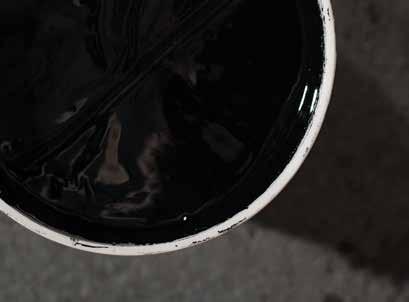
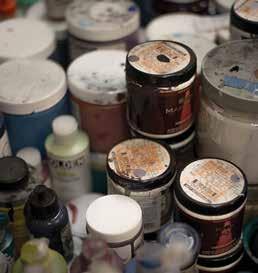
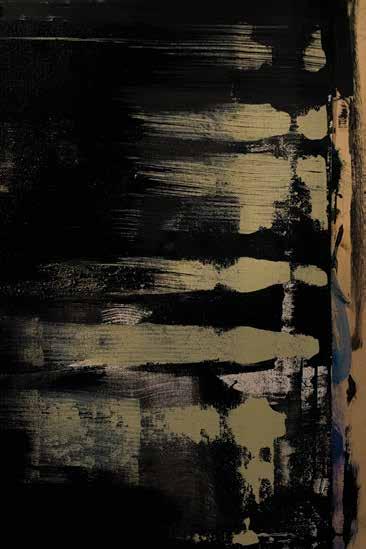 Details of Bassous' mural-scale piece Courting the Infinite
Details of Bassous' mural-scale piece Courting the Infinite
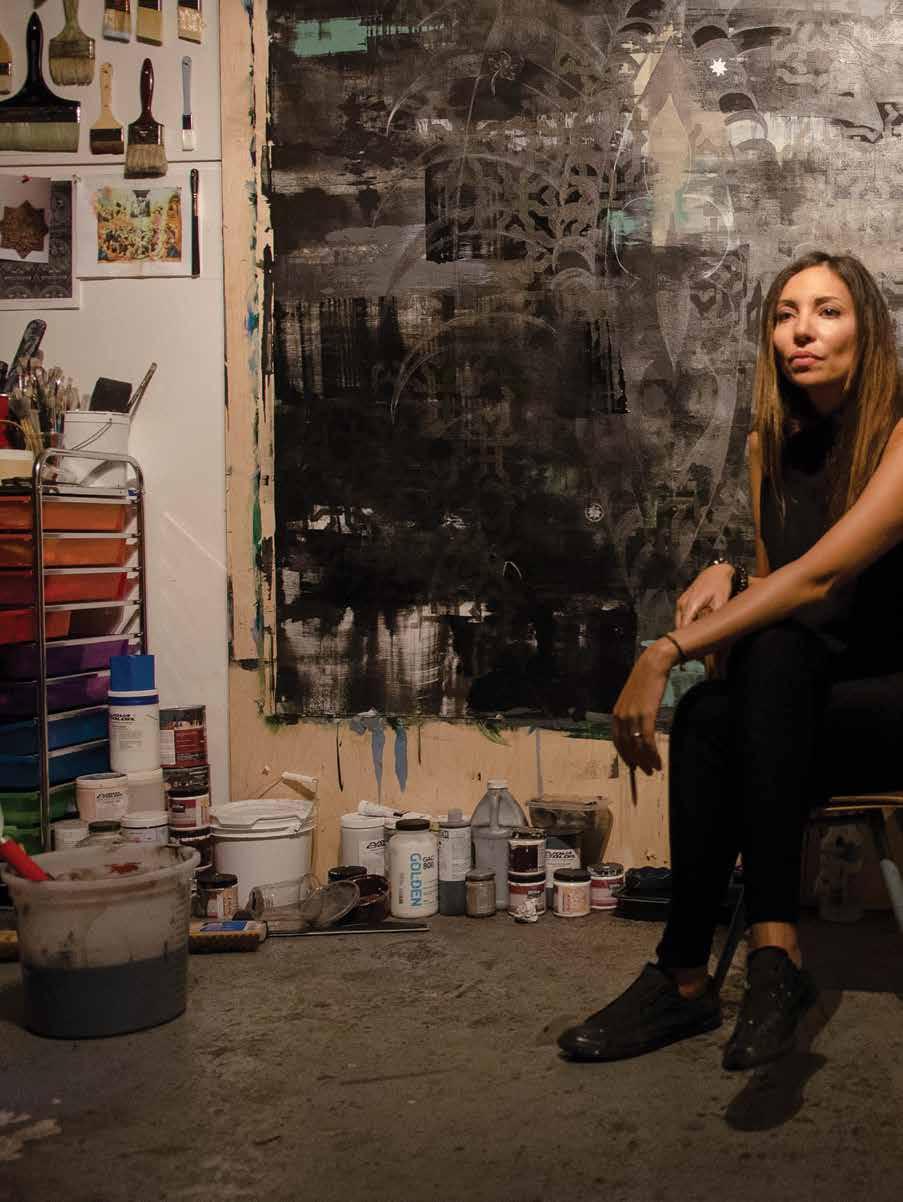
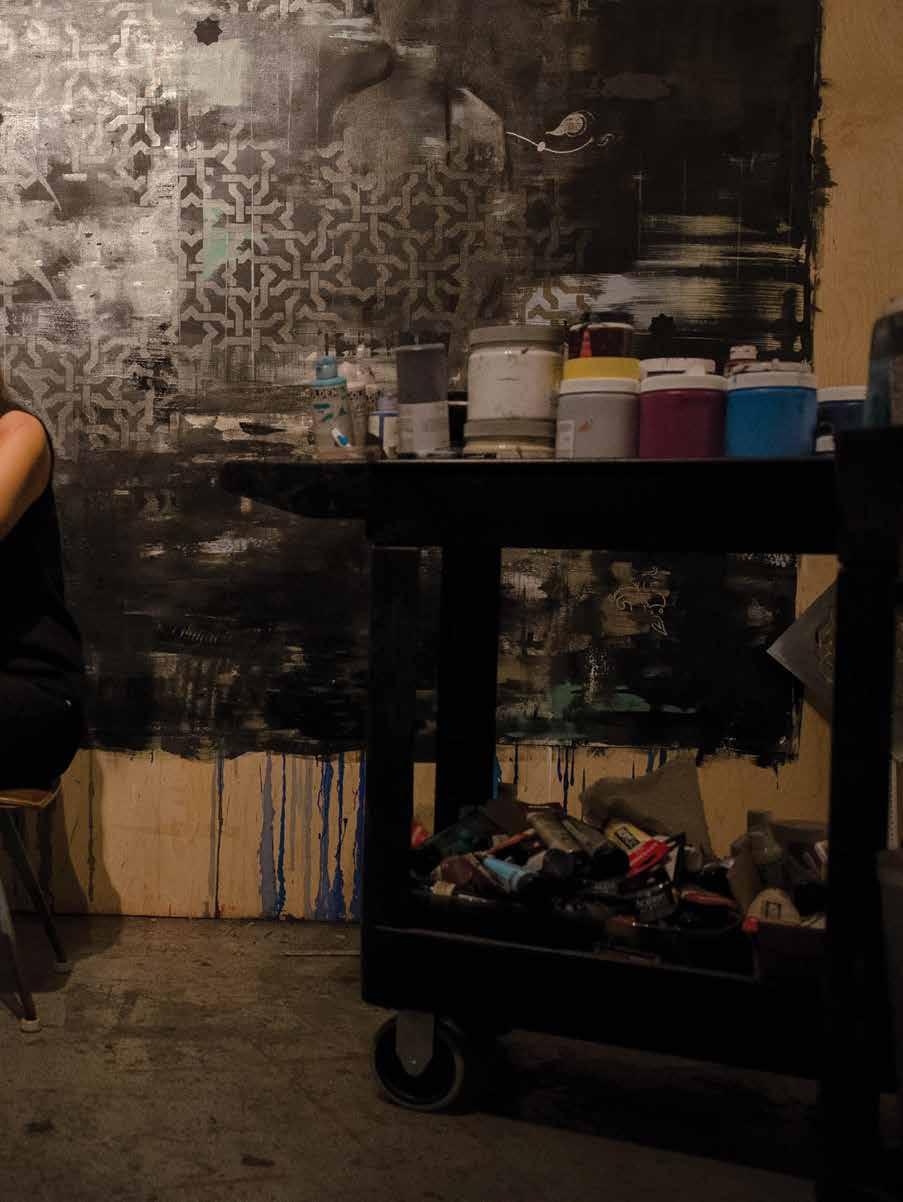
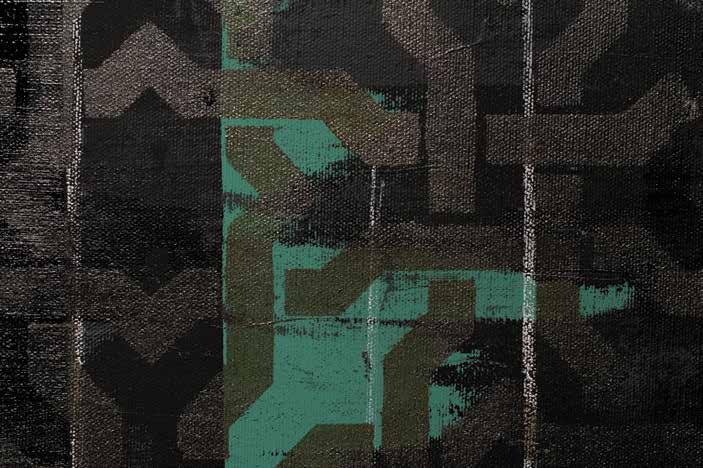
Undulating black, distorted portraits, and haunting abstractions are common themes of Bassous’ work.
sooty shadowing. In it, Bassous is exploring more of the macabre abstractions that characterize her practice: the finite, the infinite, death, the afterlife. “My coming to terms with death is ... nonexistent,” she says with a wry laugh. “I have a very hard time believing that it is the end of the road.” This latest painting, in part, is a reflection of this conflict within Bassous, and of her resistance to various interpretations of the afterlife.
On one hand, unable to believe in the finality and nothingness espoused by atheists, on the other, critical of the paradise promised in religions, and the prices paid to access that paradise. There are more questions than answers. Will the afterlife be
スタジオの中央に置かれているのは、重苦し いスモッグの色をした巨大な作品。宗教のシンボ ルがいくつも描かれ、煤の色の下にむき出しのキャ ンバスが覗いている。この作品でバスースさんは、 有限性、無限性、死、死後の世界、といった自分の 仕事を特徴づける抽象的なテーマをより掘り下げ て扱っている。「死について私が納得している結論 は……ないのですよ」と、皮肉っぽく笑ってバスース さんは言う。「それでおしまいだとは、どうしても思 えなくて」。この最新作は、その内心の葛藤と、死 後の世界についてのさまざまな概念に対する抵抗 心を描いたものでもある。一方では無神論者が信 奉する完全なる終局と虚無を信じることもできず、 また一方では宗教が約束する天国像や、そこへ至 るための代償という考えには批判的になる。答え
PALM
52 A ARTS Bassous
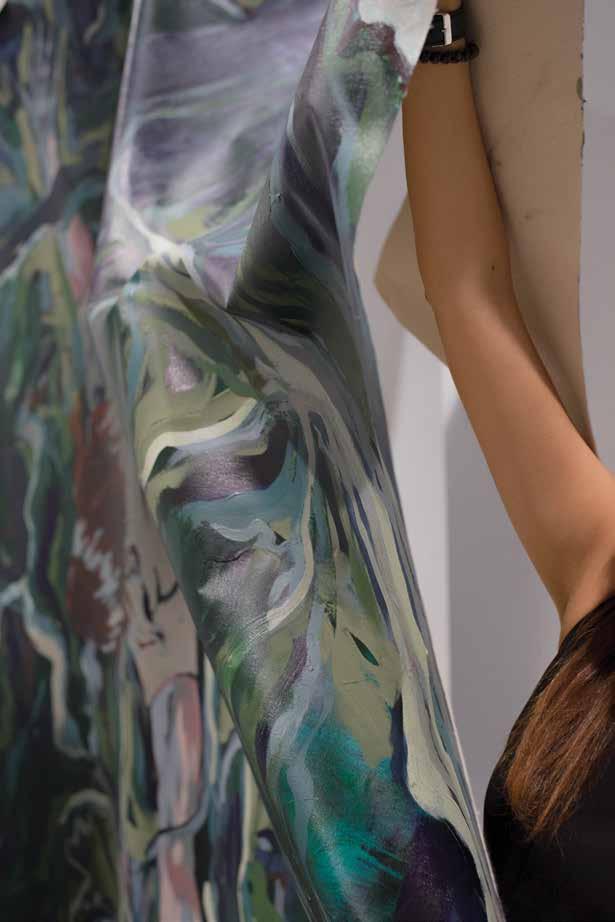
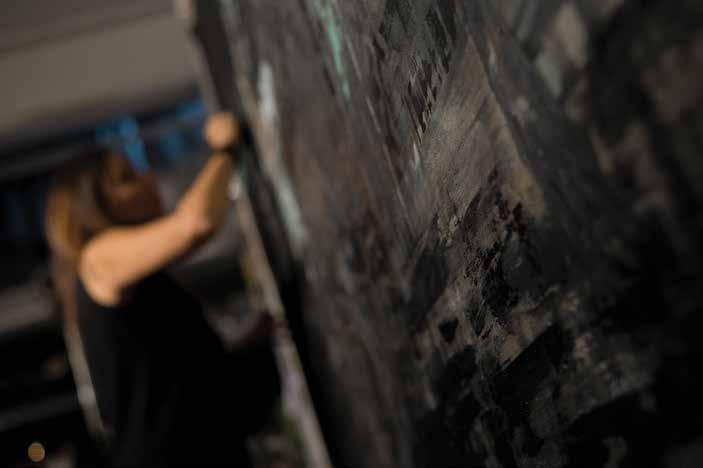
Bassous has painted and worked her way to resolutions.
a merging of all consciousness into one superphysical entity, something out of a Russian sci-fi? Or will it be an oasis of babbling waterways and white marble? Where did they go, the ones that have been loved and lost? But perhaps, later, there will be some peace.
“When you lose someone in such a shocking way, you just can’t bring yourself to believe that you’re never going to see them again,” Bassous says. “I loved what the artist Anton Kiefer says about the cosmos, that there’s definitely something out there that will be beyond our understanding. I love that idea. I love the potential of that idea. Which is why I have a very hard time believing that this is the end of the road here.”
の数より疑問の数のほうが多いのだ。ロシアのSF 小説に描かれているように、死後、人の意識は一つ の超物質的な存在に融合されるのだろうか?また は、清らかな水が流れ、白い大理石が敷きつめられ たオアシスに行くのか?愛されていた人びとは、亡 くなった後どこへ行ったのだろう?おそらくは、平 安があるのに違いない。
「誰かをひどくショッキングな方法で亡くした ときには、その人ともう二度と会えないのだと信じ ることができないものです。私はアンゼルム・キー ファーが宇宙について語った言葉が好きです。宇 宙にはきっと私たちの理解を超えた何かがいるに 違いない、と彼は言っています。その考え方が気に 入っているんです。その考え方の持つ潜在的な力 がね。だから、死がすべての終わりだとは、どうして も思えないのですよ」
PALM
54 A ARTS Bassous
mark blackburn
Buying and Selling Hawaiian and Polynesian artifacts, paintings and photographs.
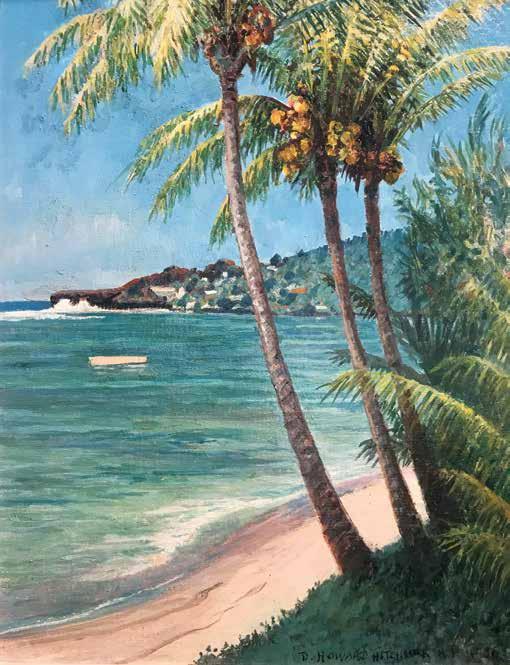
Paying especially strong prices for all Native American artifacts, especially old pawn turquoise jewelry, pottery, rugs and Kachina dolls.
Over forty years of business buying and selling works of art. Contact me with photos and prices. All inquiries will be cheerfully answered.
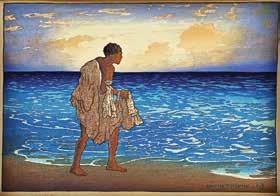
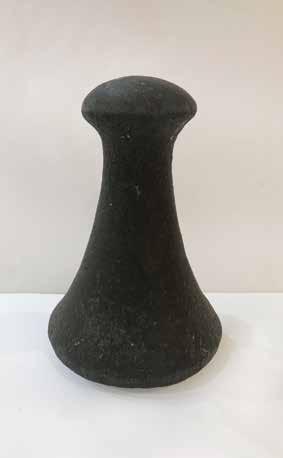
1003 bishop street, suite 120 honolulu, hi 96813
808.228.3019 or 808.227.2931
mblackburn@aol.com
Trends that drive
BU SIN ESS
B PALM ビジネス
the economy
PALM PALM B 57
Cracking the Code
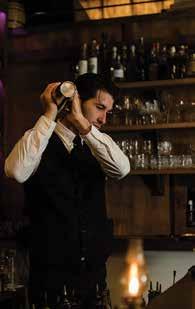
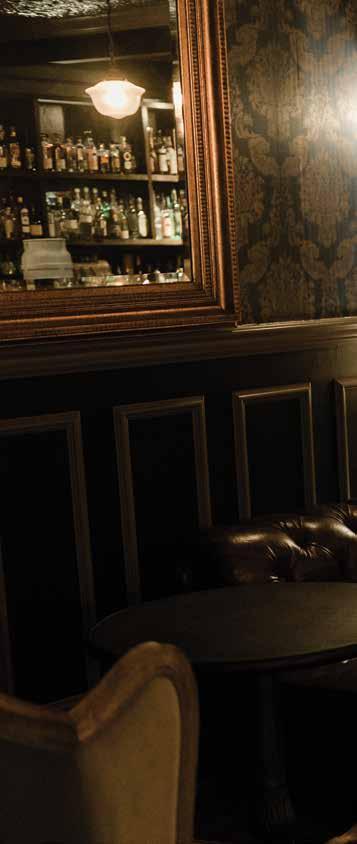
58 B BUSINESS Speakeasies PALM
秘密の酒場
Text by Eunica Escalante
文 = ユニカ・エスカランテ 写真 = ジョン・フック
Images by John Hook
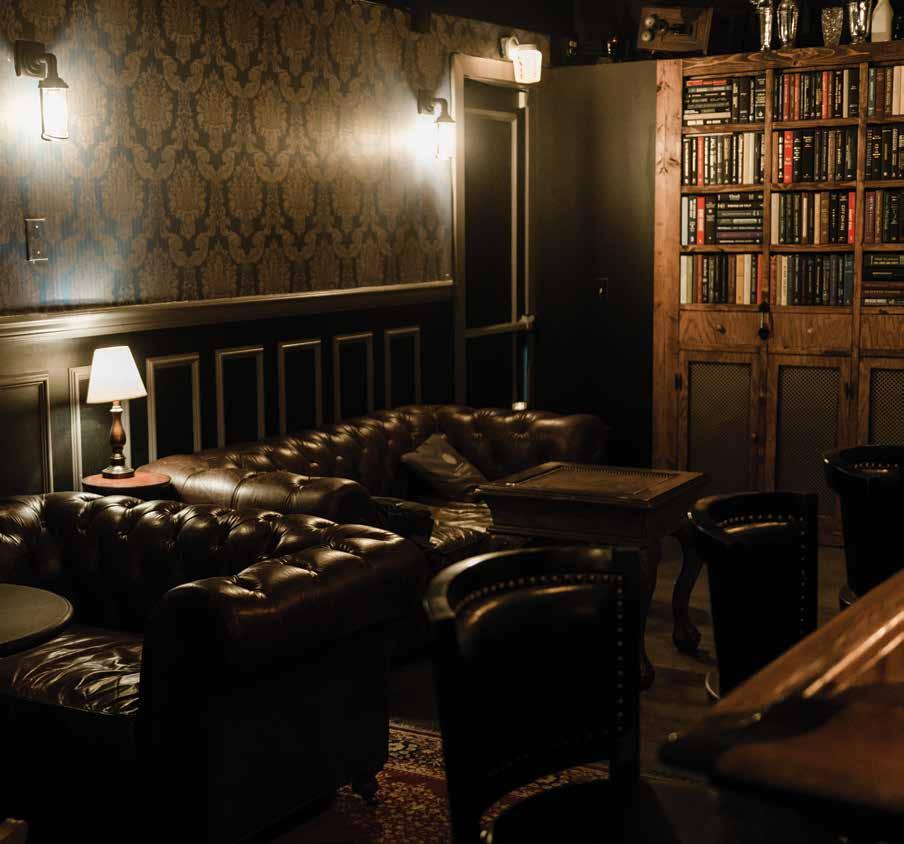
With crafty cocktails and savvy business acumens, speakeasies find success by mixing innovation and fun.
クラフトカクテルと鋭敏なビジネスセンス を武器に、21世紀のナイトシーンに秘密 酒場が復活しています。
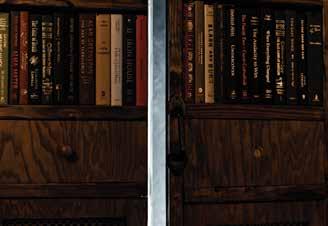
The cryptic response came mere minutes after my inquiry. Received via text message, it confirmed our reservation for the night and then rattled off a series of instructions: Dress smart. Arrive on time. Meet your host at the entrance. Your codeword (do not forget!) is “Bahama Hurricane.” Our group arrived promptly a few hours later, spilling out of an Uber ride in an overexcited mass. We were at Pint and Jigger, a Honolulu gastropub opened in 2012 by Dave Newman known for its highend drink menu.
Except we were not here for the bar’s selection of draught beers and pub fare. We were here to find out if the rumors of a speakeasy hidden behind a bookcase were true.
Our host waited at the door. I stepped forward, and she regarded me expectantly. I whispered the codeword: “Bahama Hurricane.” She nodded and herded us through the bar. We had naturally fallen into a single file line behind her, like the Pevensie children being led into Narnia.
She stopped at a plain wooden door on the opposite side of the bar, innocuous amid the flurry of a Friday night. A sign nailed to it read, “Harry’s Hardware Emporium, closed for renovations, please come again.” My spirit deflated; they must have mixed up our reservation. But our host, paying the warning no mind, slipped through the door and motioned for us to follow. We huddled in a space as narrow as a utility closet. Old paint cans lined its shelves and jazz-era posters decorated its walls.
問い合わせをすると、数分もおかずにテキストメッ セージで少々謎めいた返答が来た。その晩の予約 の確認のあとに、いくつもの指示が続く。《スマート な服装でおいでください。予約時間を厳守のこと。 係の者が入り口でお待ちします。合言葉は(どうぞ お忘れなく!)「バハマ・ハリケーン」です。》数時間 後、私と友人たちは期待で胸をふくらませ、「パイン ト・アンド・ジガー」の前でUberの車から降り立っ た。2012年にオープンして以来、ハイエンドなドリ ンクメニューで広く知られるようになったデイヴ・ ニューマンさんのガストロパブだ。
でも今日の目的は地ビールセレクションやパ ブ料理ではない。ここの本棚の後ろにスピークイ ージー(秘密酒場)が隠されているという噂が本当 なのかどうか、確かめに来たのだ。
ドアの前で女性が私たちを待っている。一歩 近づくと、彼女は待ちかまえていたように私を見つ める。私は声をひそめて合言葉をささやいた。「バ ハマ・ハリケーン」。女性はうなずき、私たちを先導 してバーの中を通り抜けていく。私たちは自然に 一列縦隊になって彼女のあとを追った。まるで、洋 服だんすの中を通って不思議な国の冒険に乗り出 す『ナルニア国物語』の子どもたちのように。
女性はバーの反対側にある、なんの飾りもな い木製の扉の前で立ち止まった。金曜日の夜の陽 気な喧騒の中にあって、まったく酒場らしさのかけ らもない扉だ。扉の上には「ハリーズ・ハードウェ ア・エンポリアム(ハリーの金物店):只今改装のた め休業中」という札がかけてある。私の心は沈ん だ。何か間違った予約をしてしまったに違いない。 だが、案内人の女性は札にはまったく注意を払わ ずに、扉を開けて中に入り、後に続くように合図を した。そこはまるで小さな物置のような狭い空間 で、棚には古いペンキの缶が並び、ジャズエイジの ポスターが壁を飾っている。
숨겨진 계단, 희미한 불이 켜진 복도, 잠긴 문 앞에
비밀번호까지 있습니다. 스피어스는 호놀룰루의 야간
작업 현장을 강타한 최신 트렌드입니다. 지난 몇 년
동안 새로운 "비밀" 바 조인트가 등장했는데, 대개
이미 존재하는 시설에 있습니다.
A bookcase doubles as the entrance to Harry’s Hardware Emporium.
60 B BUSINESS Speakeasies
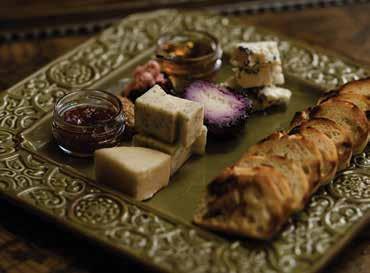
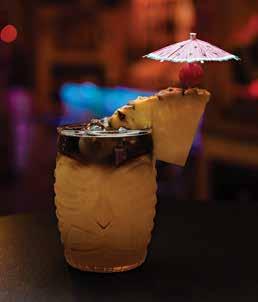
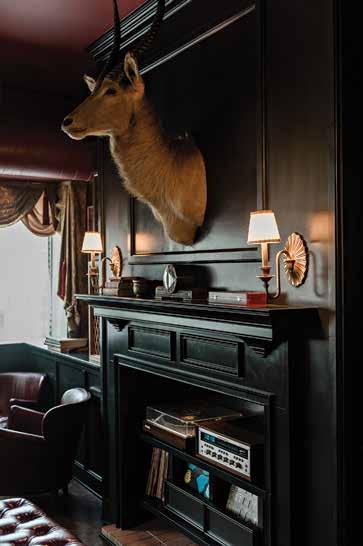 Handcrafted cocktails and charming interiors enhance the experiences of guests.
Handcrafted cocktails and charming interiors enhance the experiences of guests.
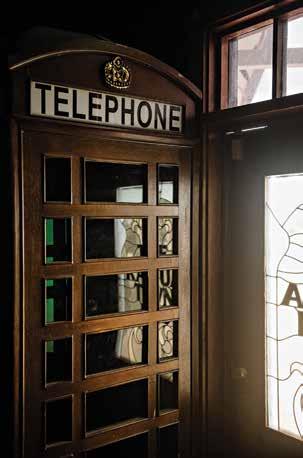
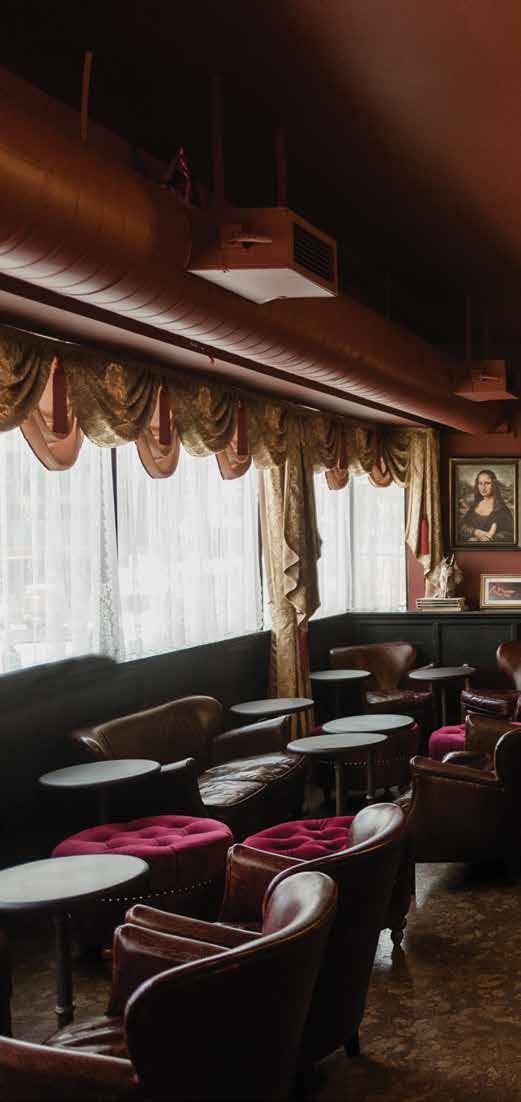
B PALM
Above, the telephone booth entrance for Gaslamp in Kailua. Right, HI Brau is furnished with vintage finds.
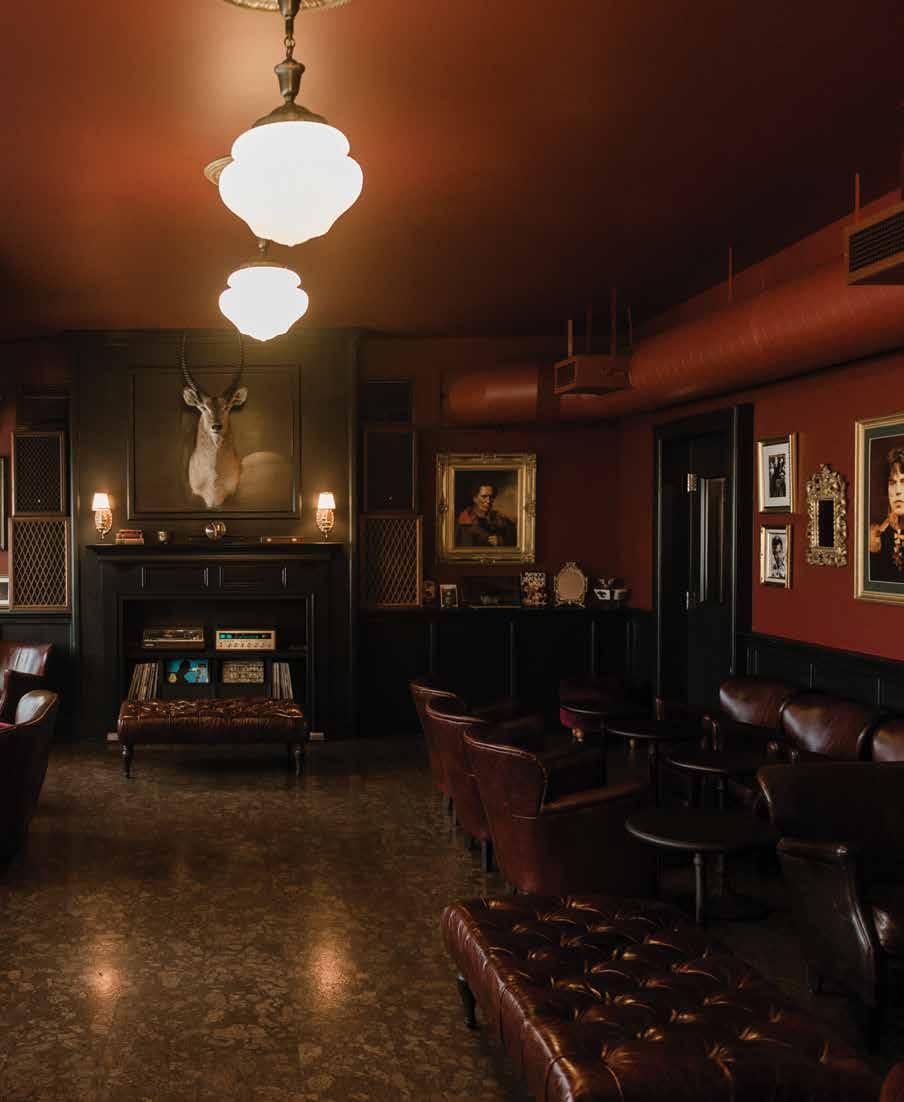
“Welcome to Harry’s Hardware Emporium,” our host said, grasping the trimming along the wall. Was this it? Had we come to see a wall cavity? Then, with a slight push, the wall swung outward, spilling soft light into the dark, musty space where we stood. On the other side, smooth jazz played over the sound of polite laughter and the clinking of glasses.
The concept of hidden bars is nothing new. In the 1920s, they were born out of necessity. The U.S. government’s brief prohibition of alcohol pushed bars underground, concealed behind false walls and in hidden basements. In the subsequent decades, the concept was romanticized, a poster child for the spirit of the jazz age. On New Year’s Eve in 1999, Sasha Petraske’s Milk and Honey debuted in New York City, transforming that nostalgia into the new millennium’s hottest nightlife trend.
Although East Coast cities like New York and Chicago have seen speakeasies come and go, the trend hit Hawai‘i in the last decade. Newman, also a co-owner of Harry’s Hardware Emporium, attributes the concept’s popularity to today’s experience-chasing consumer. “What we’re providing is more than a drink or a bite to eat,” Newman said. “It’s an entire experience.” With speakeasies, he said, that experience starts even before the customer enters through the door.
Exclusivity makes speakeasies alluring. Harry’s, which opened in late 2017 with little fanfare, does little advertising, letting publicity grow through word of mouth. The HI Brau Room in Kaka‘ako has a similar approach, alerting curious customers of its existence only through a simple glass door at street level bearing its name, plus a handful of signs sprinkled like crumbs throughout the premises of its adjoining bar, Aloha Beer Co. Visitors are encouraged to discover it of their own volition. Dave Campbell, owner of HI Brau Room and Aloha Beer Co., pointed out that discovering the speakeasy this way is what makes it magical.
The fantasy is sustained by HI Brau’s bordelloinspired décor and vintage finds furnished by Campbell. Guests sink into plush velvet armchairs and leather sofas arranged in groupings to stimulate conversation, a stark contrast from Aloha Beer Co.’s beer-hall atmosphere downstairs. A record player spins selects from Campbell’s vinyl collection. His affinity for blues and rock is further evident in the neoclassical portraits of Keith Richards and Mick Jagger hanging on the walls.
「ハリーの金物店へようこそ」。案内の女性はそう言って、壁の縁の飾り 部分をつかんだ。これが、秘密の通路なのだろうか?女性が軽くひと押しする と壁が外に向かって大きく開き、私たちが立っていた薄暗くてじめついた空間 に柔らかな光がこぼれた。壁の向こうには、ジャズが流れ、グラスが触れ合う 音と控えめな談笑に満ちた場所があった。
秘密酒場は、もちろん最近の発明ではない。1920年代に必要に迫られ て生まれたものだ。米国政府の禁酒政策により、酒場は壁の後ろや地下室に 隠れて営業せざるを得なくなった。後の時代には、秘密酒場はジャズエイジの 精神を体現するロマンチックな存在と捉えられるようになる。サーシャ・ペトラ スクが1999年の大晦日にニューヨークに開いた酒場「ミルク・アンド・ハニー」 は、ノスタルジックな秘密酒場を新世紀のナイトシーンの注目トレンドとして生 まれ変わらせた。
ニューヨークやシカゴではそうした新しい秘密酒場がいくつも生まれて は消えていったが、そのトレンドがハワイに上陸したのはここ10年ほどのこと だ。「パイント・アンド・ジガー」とこの秘密酒場「ハリーズ・ハードウェア・エンポ リアム」の共同オーナーを兼ねるニューマンさんは、常に新しい体験を求める 昨今の消費者たちが秘密酒場の人気を後押ししていると語る。「こういう酒場 が提供するのは、お酒と食べものだけではありません。すべて包括したエクス ペリエンスなんです」。ニューマンさんによれば、秘密酒場のエクスペリエンス は、酒場に到着する前からすでに始まっているという。
秘密酒場を魅力的にしているのは、アクセスが限られていることだ。
2017年に開店した「ハリーズ」は当初からほとんど広告を打たず、おもに口コ ミで広まってきた。カカアコにある「ザ・ハイブラウ・ルーム」も同様のアプロー チを取っている。店の名前を記したごくシンプルなガラスのドアと、隣接するバ ー「アロハ・ビア・カンパニー」の店内に散りばめられたいくつかのヒントで店の 存在をそっとアピールし、好奇心をそそる。興味を持った人が隠された店を自 分で探し出せるような工夫がされているのだ。そのようにして秘密酒場を自力 で見つけてこそ、酒場が魔法のような魅力を放つのだ、とハイブラウ・ルームと アロハ・ビア・カンパニーのオーナー、デイヴ・キャンベルさんは力説する。
往年の売春宿を真似たインテリアや、キャンベルさんが探して集めてきた ヴィンテージの家具も、ハイブラウ・ルームの物語性を高めるのに一役かって いる。ふかふかしたベルベットの椅子やレザーのソファが気軽に会話を始めや すいように配置されているこの酒場は、賑やかな活気溢れる階下のビヤホー ル、アロハ・ビア・カンパニーとは対照的な雰囲気だ。キャンベルさんのLPコレ クションのレコードがターンテーブルの上で回転し、壁にはキース・リチャーズ とミック・ジャガーを描いた新古典派風の肖像画が飾られ、ブルースとロックに 捧げる店主の愛を物語っている。
PALM 64 B BUSINESS Speakeasies
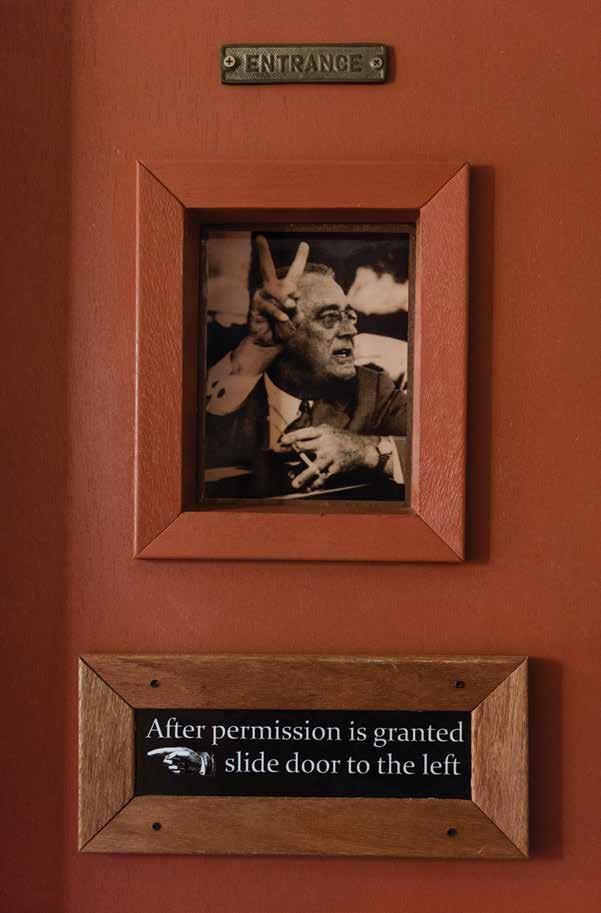
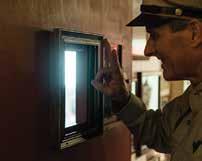 Exclusivity makes speakeasies alluring. At Wiki Waki Woo, entry requires a secret knock and a hand signal.
Exclusivity makes speakeasies alluring. At Wiki Waki Woo, entry requires a secret knock and a hand signal.
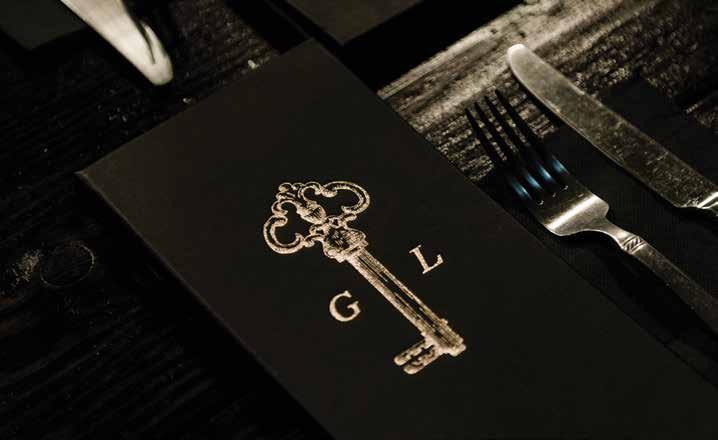
Gaslamp’s aesthetic was inspired by the historic San Diego neighborhood that bears the same name.
“I wanted to create something like escapism— you walk in through the door and you’re transported somewhere else,” Campbell said. “You’re here with friends, you have a nice drink, and you forget about everything that’s happening outside.” For Campbell, establishments such as HI Brau offer a respite from today’s fast-paced lifestyles.
“When they’re here, they’re really here,” Newman said, describing how Harry’s patrons often keep off their phones, choosing instead to engage with other guests or explore the space. “It takes me back to what bartending was like 20 years ago, when going out was more about the experience than what was happening on social media.”
At Gaslamp in Kailua, an etiquette section in the menu reminds guests not to “scream into your cellphones” and to “enjoy your present company.” While these instructions may seem strict, the bar’s intimate ambience make them effortless to follow. Accessed via a telephone booth in the back of Kailua Town Pub, the speakeasy’s high ceilings and brick interior lend an air of wistfulness. On certain nights,
「エスケープできる場所を作りたかったんです。扉を開けて一歩中に 入ると、一瞬でどこか別の世界へ連れていってくれるような。ここは、友人 たちと美味しいお酒を飲んで、外の世界のことはすべて忘れてしまえるよう な場所なんです」とキャンベルさん。
彼にとってこうした酒場は、現代の目まぐるしいライフスタイルをつか の間忘れられる憩いの場なのだという。ハリーズにやってくるお客も、スマ ートフォンをいじる代わりに他の客と話したり、店の雰囲気を楽しむ人が多 いとニューマンさんは語る。「この店に来たら、皆リアルにその場を楽しん でいます。20年前のバーを彷彿とさせますね。あの頃の夜遊びっていうの は、その場で起こることを楽しむものでした。ソーシャルメディアで何が起 きているかには関係なくね」
カイルアにあるバー「ガスランプ」では、店内エチケットについてメニュ ーにこんな注意書きがある。「携帯電話に向かって大声で話したりせず、そ の場に同席している人たちとの時間を楽しんでください」。厳しい注文のよ うに見えるが、落ち着いて親しみやすい雰囲気のこの店では、ごく自然にそ れに従うことができる。ガスランプは「カイルア・タウン・パブ」の店内にあ る電話ボックスの奥に隠れた酒場。高い天井と煉瓦の壁がいわくありげ
66 B
PALM
BUSINESS Speakeasies
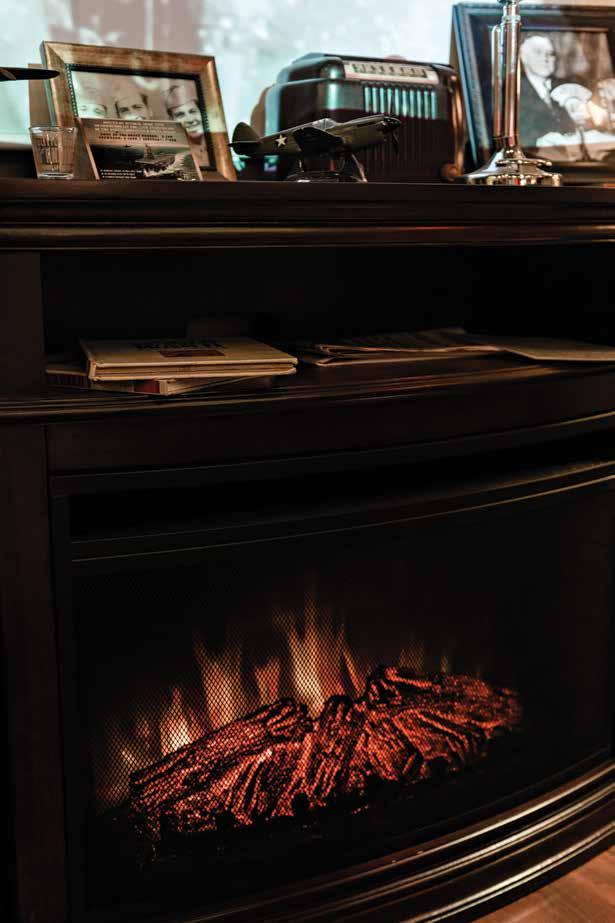
a jazz band plays from the stage, silky notes flowing over the bevy of patrons. The bar’s aesthetic was inspired by San Diego’s historic Gaslamp Quarter, where owner Josh VanEmmerik spent time while attending school. “This elevated ambiance was created to be a contributor of value and creativity,” reads a page in the menu, describing a philosophy that “real conversation and connection are the lungs of any decent society.”
However, other speakeasies embrace social media. Being Instagram-friendly is crucial to the Home of the Brave Museum and its upstairs speakeasy, Wiki Waki Woo. The largest World War II museum in the Pacific features collectibles that guests are encouraged to take photos with, like a WLA 1942 Army-issue HarleyDavidson motorcycle used in the taping of Pearl Harbor which was donated by a veteran. Meanwhile, Wiki Waki Woo is fashioned after a 1940s officer’s lounge. Its walls are decorated with old photographs of soldiers on deployment, medals for service, and keepsakes from battle.
We ascended a narrow staircase in the corner of the museum to its entrance and then relayed the password by knocking on the door in Morse code. Behind a slot in the door, owner Glen Tomlinson, outfitted in a vintage Army uniform, waited for the remainder of the code, a brief flash of a hand signal, then let us in. Then he hand-mixed our craft cocktails. The décor is period-specific, drawing civilians and crowds of military servicepeople who often rent the space for gatherings.
The speakeasy opened in 2017, after Tomlinson’s children observed the trend in other states. Eight years earlier, they helped expand the Home of the Brave with the Home of the Brave Brewing Company and the Brewseum, the brewpub next door. These efforts were intended to attract a younger crowd. Across the country, museums like Home of the Brave have been shutting down because “for a younger demographic, I hate to say it, World War II museums are not exciting,” Tomlinson said. The speakeasy and brewpub were an effort to bring in the younger generation. “We’ve had to reinvent and adapt if we wanted to stay open,” Tomlinson said.
After grabbing a mai tai upstairs, I wandered through the museum, cocktail in hand, studying the history that surrounded me. Speakeasies transcend trends, according to Tomlinson. They are safeguards of the past. Much like the museum, which opened in 1991, Wiki Waki Woo has become a home for the memories of World War II soldiers.
“It’s not just stuff on the wall,” Tomlinson said. “It’s treasured memories. We’re the keeper of the flame for these veterans and their stories.”
な風情をかもしだしている。ときにはジャズバンドがステージに立ち、なめら かな音楽を奏でる。店の内装は、オーナーのジョシュ・ヴァンエメリックさんが 大学院時代を過ごしたサンディエゴのガスランプ・クォーターに着想を得たも の。メニューには「この場所は、価値と創造性を生み出すべく作られました。良 き社会には常にほんものの会話とつながりが不可欠です」という哲学が謳わ れている。
一方で、ソーシャルメディアを活用している秘密酒場もある。太平洋一帯 で随一の第二次大戦に関する私設博物館「ホーム・オブ・ザ・ブレイブ」ミュー ジアムと、その上階にある秘密酒場「ウィキ・ワキ・ウー」にとっては、ゲストによ るインスタグラムへの投稿が重要な広報手段だ。ゲストが一緒に写真を撮影 できる収蔵品の中には、たとえば映画『パール・ハーバー』の撮影にも使われ、 その後ある退役軍人によってこのミュージアムに寄付されたハーレーダビッド ソンWLA1942などがある。一方で「ウィキ・ワキ・ウー」は1940年代の将校 ラウンジを模した内装の酒場。壁には一面に、戦地での兵士たちの写真やメ ダル、戦地から持ち帰った記念品などが飾られている。
ミュージアムの隅にある狭い階段を上り、モールス信号でパスワードをノ ックすると扉が開く。扉の反対側では陸軍の古い制服に身を固めたオーナー のグレン・トムリンソンさんが待ちかまえていて、残りの暗号と手信号を確認す ると中に入れてくれ、それから私たちのためにクラフトカクテルを作ってくれた。 1940年代風の酒場には軍関係者や軍人たちが集まり、ときには貸し切りでパ ーティーや会合を開いている。
オープンは2017年。米国本土で秘密酒場の流行を見聞してきたトムリ ンソンさんの子どもたちの提案だった。その8年前には子どもたちの助けを得 て、ミュージアムと「ホーム・オブ・ザ・ブレイブ・ブルーイングカンパニー」、そし て隣りのブリューパブ「ブリュージアム」を拡張して、より若い世代の客層にア ピールした。米国各地で、このホーム・オブ・ザ・ブレイブのような私設ミュージ アムは次々に閉鎖に追い込まれている。「残念なことだけど、若い人たちにとっ ては第二次大戦の博物館なんてエキサイティングじゃないからね」とトムリン ソンさんは言う。秘密酒場やブリューパブは、若い世代を呼び寄せるための努 力の一環だ。「店じまいしたくないなら、新しい考え方を見つけて適応していか なければならないんですよ」とトムリンソンさん。
上の階で作ってもらったマイタイを片手に、私は階下のミュージアムをぶ らついて、この地に刻まれた歴史について見て歩いた。トムリンソンさんによれ ば、秘密酒場は流行を超え、過去の記憶を守る存在だという。1991年にオー プンしたミュージアム同様、ウィキ・ワキ・ウーもまた、第二次大戦で戦った兵 士たちの記念品を集める場所となった。
「これらは単なる壁の飾りじゃなく、大切な思い出なんです。私たちはこ こで、戦った人々の情熱とその物語を語り続けているのですよ」
68 B PALM
BUSINESS Speakeasies

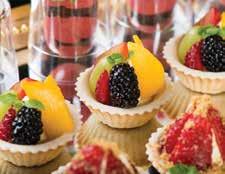
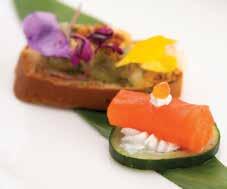
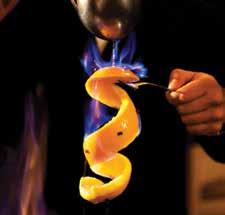
CATERING BY HY’S
A black tie experience, bringing our iconic table side preparation of salads and flambe desserts and our attention to detail to your next special gathering.
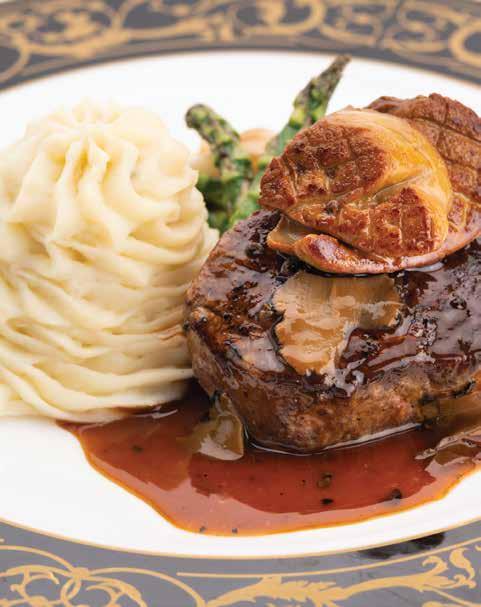
A “USDA PRIME BEEF” SPECIALTY HOUSE
A fine-dining tradition in Hawaii for 43 years. Experience the flavorful difference as the only steakhouse in Waikiki to broil over fragrant Hawaiian kiawe wood.
For catering inquiries, email catering@hyshawaii.com.
OPEN DAILY 5PM–10PM 808 922 5555 HYSWAIKIKI.COM 2440 KUHIO AVENUE HONOLULU, HI COMPLIMENTARY FOUR HOUR VALET PARKING
SI GN
D デザイン flourishing The of DE
creative
facilities
D
PALM
PALM
71
Bending Light
光の誘惑
Text by Spencer Kealamakia
文 = スペンサー・ケアラマキア
Images by Chris Rohrer
写真 = クリス・ローラー
72 D DESIGN Neon PALM
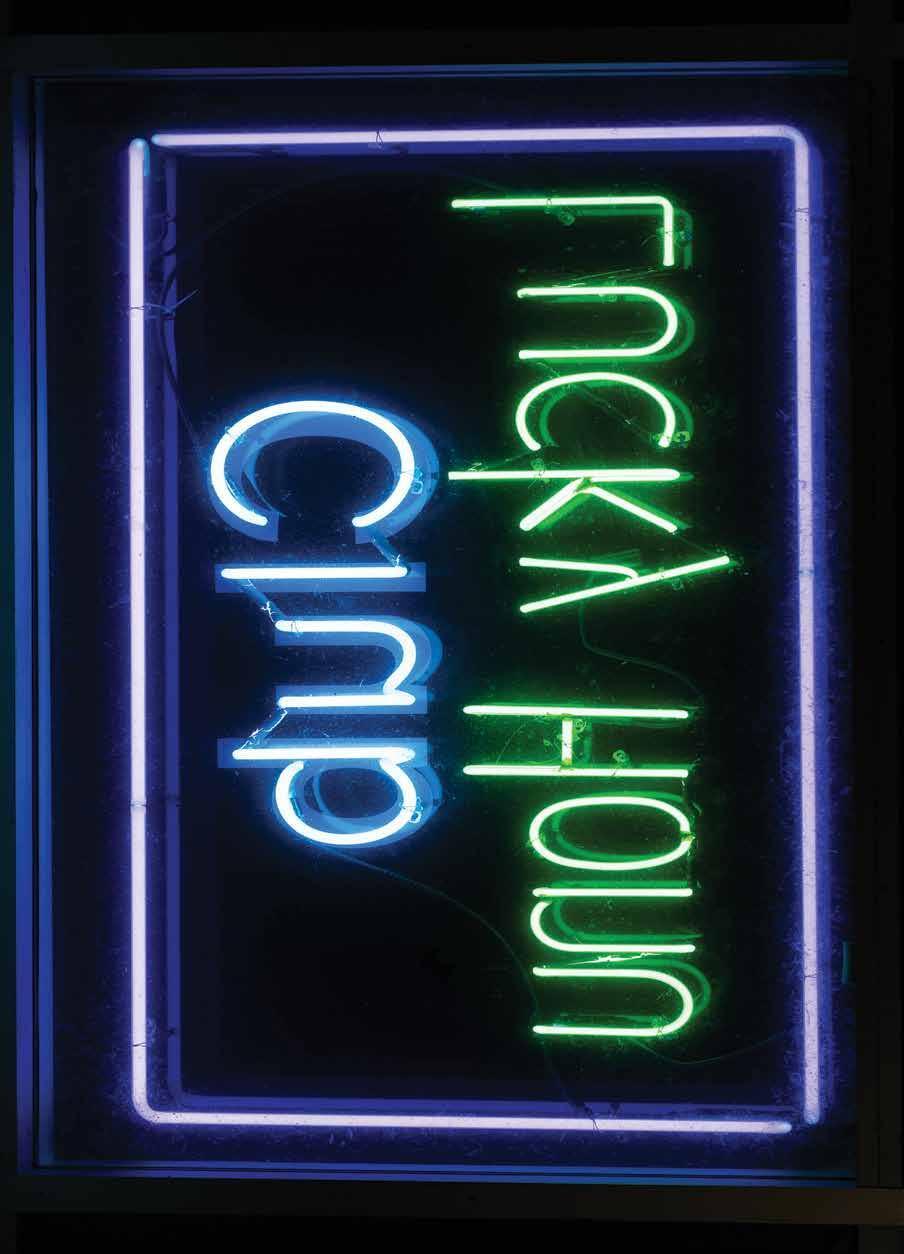
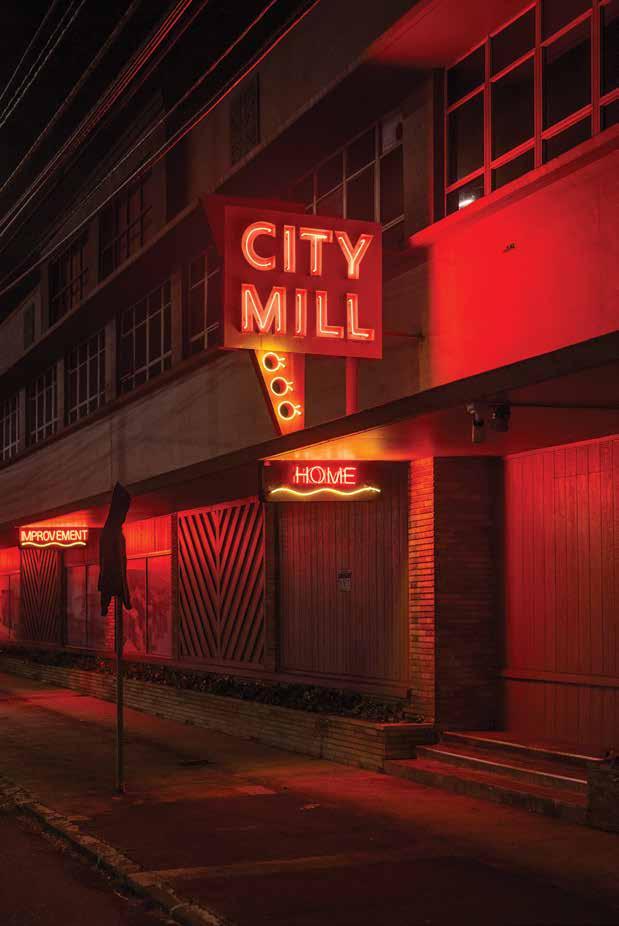
Like moths to a flame, neon signs lure us in from the dark streets with their electric colors and vibrant construction.
夜の街角に輝くネオンサインはその刺激的な色と華やかな形で、炎が虫 たちを引き寄せるように私たちを誘います。
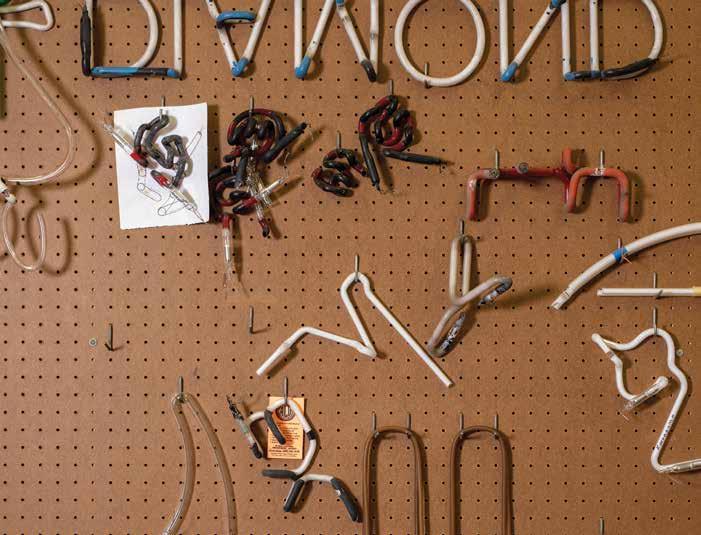
At night in Honolulu, neon signs invite us to satisfy our appetites. It’s the azure glow of “Leonard’s” that captures our senses before the scent of malasadas do. What ends with a late-night loco moco in a diner booth began under the spell of a Jetsonian sign and its electric green and red letters: Like Like Drive Inn. Oftentimes, a simple red and blue “Open” sign is more than enough to guide us in from the dark.
ホノルルの夜、街角ではいくつものネオンサインが私たちに誘いかける。「レナ ーズ」の青いネオンはマラサダの香りが漂ってくるよりも先に視界に飛び込ん でくるし、夜更けにダイナーのブースでロコモコをお腹に詰め込むことになる のは、「リケリケ・ドライブイン」のレトロフューチャー的な形の看板と、その緑と 赤の文字が持つ魅力のなせる技だ。時には赤と青のシンプルな「OPEN」のサ インでさえ、私たちを暗闇から誘い出し、惹きつける力を持っている。
PALM
74 D DESIGN Neon
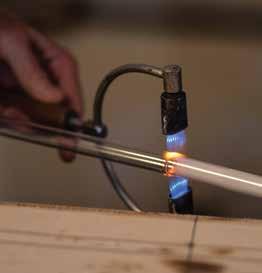
매일 저녁 킹과 베레타니아 거리의 작은
상점들은 네온으로 불이 켜집니다. 네온을
구성하는 실제적이고 교활한 사업에 대해 더
잘 이해할 수 있도록 이 기이한 표지판들과 그 제조회사들을 그래픽으로 보세요.
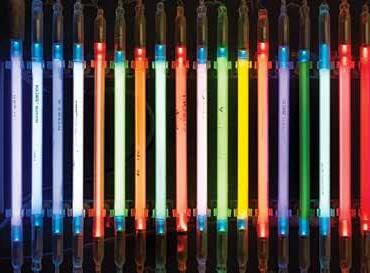
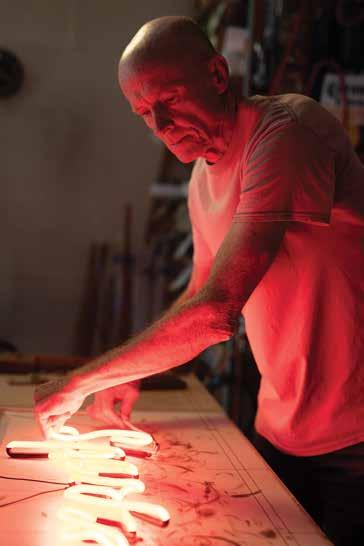 Honolulu sign maker Von Monroe has been in the business since 1980.
Honolulu sign maker Von Monroe has been in the business since 1980.
“Neon isn’t going anywhere,” says Von Monroe, a Honolulu sign maker. “Nothing can live up to that classic look.” He’s sitting at the work table in the center of Strictly Neon, his 500-square-foot shop, the last door in a Kalihi concrete walk-up that also houses a tattoo parlor, a jiu-jitsu studio, and a church.
Monroe has been in the Honolulu sign business since 1980, after the neon boom of earlier decades when neon lighting hung all over Waikīkī. When he began apprenticing in a sign shop, he learned everything there was to know about signs, except for neon. After failing to find someone in Hawai‘i with the know-how, he went to the continent to learn the craft. Then, he spent his afterwork hours practicing making neon signs in his carport. Eventually it became intuitive, he says, “manipulating an instrument, eye-hand coordination.”
Neon-lighting technology and tools have remained largely unchanged since their creation and quick rise to popularity in France at the turn of the 20th century. Torches are still used to bend and shape the glass, and the neon light is still underpinned by the physics of an electric current running through pressurized noble gases.
“You got your fires,” Monroe says, pointing to a ribbon and a cross fire burner, each threaded onto a waist-high pipe stand. The ribbon burner puts out a thin, blade-like flame used to shape sweeping curves, especially for script typefaces. The crossfire consists of a pair of torches aimed at each other, and it is used to make more acute bends and to splice pieces together. The neon colors are produced by adding different gases or using colored, phosphor-coated glass. A dash of mercury bumps the luminosity.
Over the years, Monroe has watched signs go up and come down. Some have rusted away, and others have been resurrected. He knows the city by its show windows and marquees, a local history written in channel letters, depicted on fluorescent light boxes, and shaped in neon—a cacophony of silent pitches and come-ons.
「ネオンが廃れることはないでしょう」と語るのは、ホノルルのネオンサイン 職人、ヴォン・モンローさん。「クラシックなネオンサインにかなうものはありま せん」。46平方メートルほどの広さの工房中央に置かれた作業テーブルの前 に座って、モンローさんはそう断言する。彼の工房があるのはカリヒの雑居ビ ル。タトゥーの店、柔術スタジオ、教会が入居する建物の一番奥だ。
モンローさんがホノルルで看板製作のビジネスを始めたのは1980年。ワ イキキ中にネオンサインが飾られていた時代はとうに去った後だった。ある看 板製作店で見習いを始めたモンローさんは、そこで看板に関するあらゆること を学んだが、ネオンサインについては何も習得できなかった。ハワイでネオン 管加工のノウハウを持つ人物を見つけられなかったモンローさんは、米国本土 に渡って技術を学んだ。その後、毎日仕事の後に自宅の車寄せでネオンサイン 加工の練習を繰り返し、いつしかネオン製作が直感的に身につくまでになった という。「道具をあやつって、目と手の動きを連動させるんです」。
ネオンライトは20世紀に入ったばかりのフランスで発明され、急速に人気 を博したが、当時の技術と製作用器具の大部分は現在もほぼ変わらずに使わ れている。ガラスを曲げ、形を作るのには今もトーチバーナーが用いられ、加圧 された希ガスの中に電流を流すとネオンの灯りが輝く。
「あれがネオンを作る炎です」モンローさんはそう言って、それぞれ腰の高 さのパイプスタンドに通された直線状のリボンバーナーと対面式のクロスファ イアバーナーを指さした。リボンバーナーから吹き出される薄い刃のような火 炎は、筆記体などのカーブを形作るのに使われる。一方、2つのバーナーが互 いに向き合うような形状のクロスファイアバーナーは、管に鋭い角度をつけた りパーツを重ね継ぎする際に使う。ネオンの色は、異なる種類のガスを加えた り、色つきの蛍光体ガラスを使用したりすることで変えられ、少量の水銀を加 えることで光度が高まる。
長年の間に、街のあちこちにネオンサインが現れては消えていくのをモンロ ーさんは目にしてきた。ネオンの中には放置され錆びついていくものもあれ ば、修理されて復活するものもある。彼はショーウィンドウや看板の上に街の 個性を読み取る。土地の歴史は、チャンネル文字(看板に使われる厚みのある 文字)で記され、蛍光灯の入ったボックス型看板の中に描かれ、ネオンサイン の形の中に刻まれる。それらが一体となって、道行く人を呼び込む、音のない 雑多な合唱を響かせている。
PALM 76 D DESIGN Neon
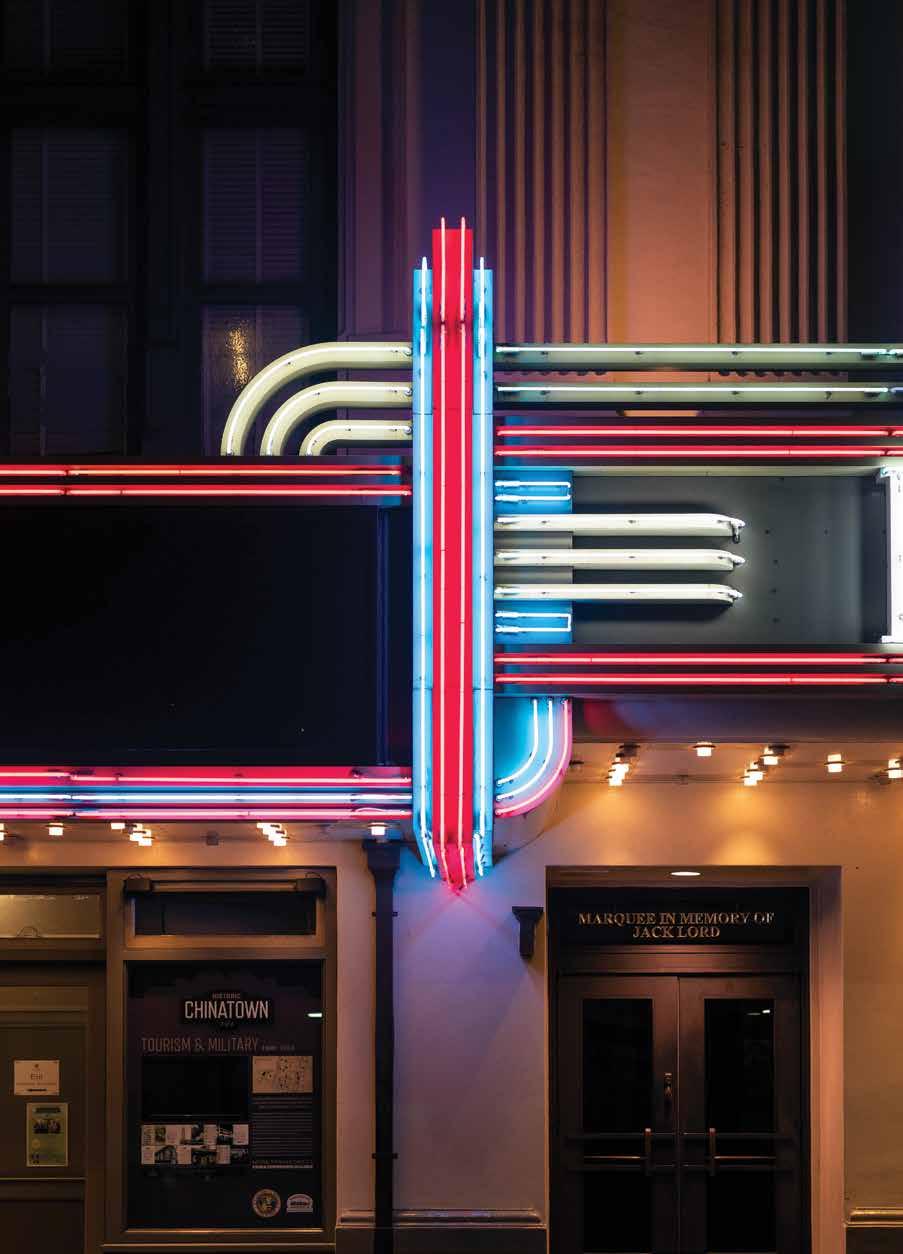
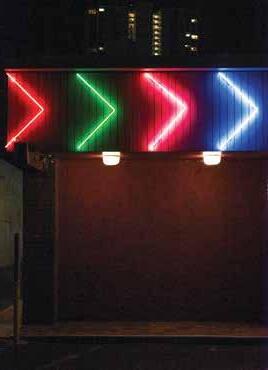
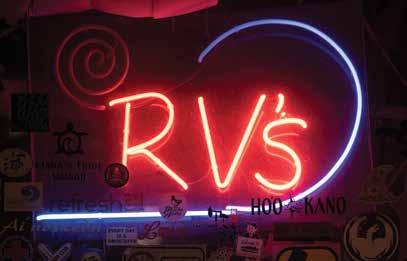
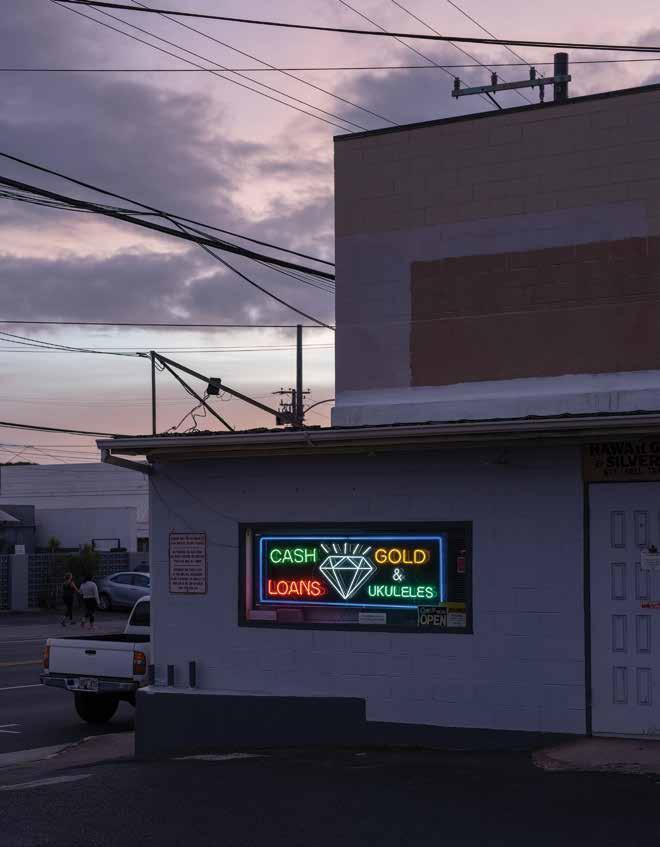
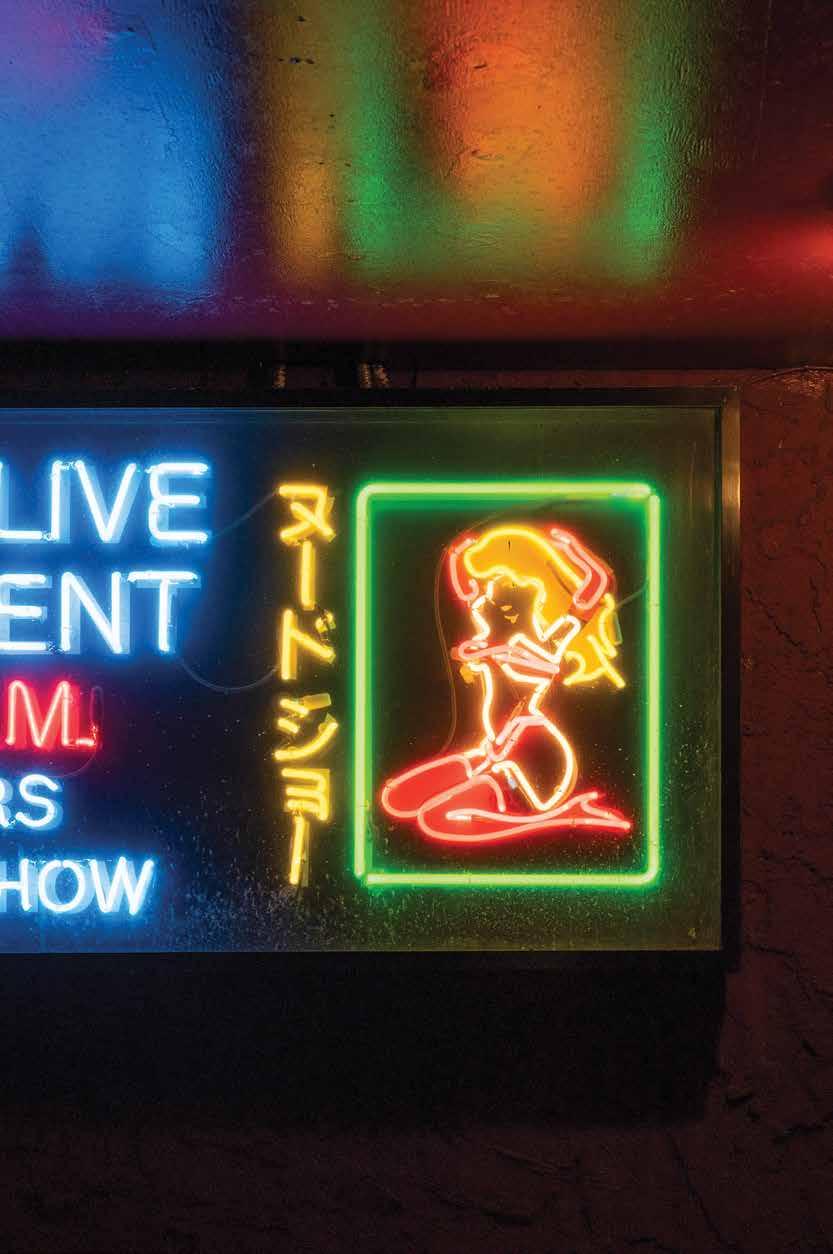
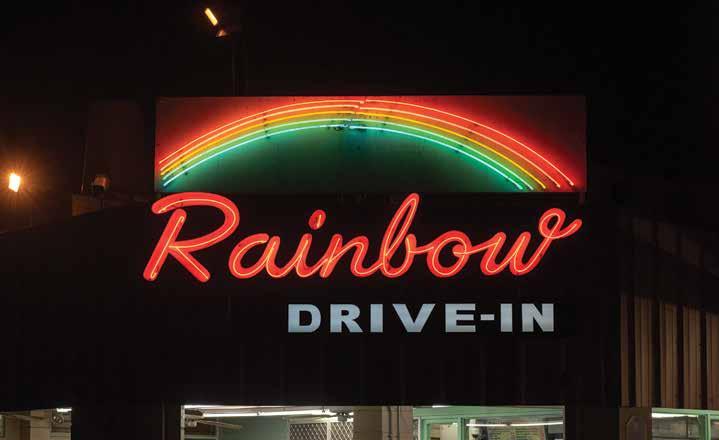
Neon signage have become iconic fixtures at local establishments.
He has his beloved neon signs around town, many of which he’s worked on. His favorites include the Hawaii Theatre sign and marquee, the nonfuctioning McCully Chop Suey sign, and the pink Pig and the Lady sign. He grieves the demolition of the Fisherman’s Wharf restaurant but finds relief in knowing the free-standing fish sign was saved. The iconic, complex Club Hubba Hubba sign on Hotel Street in Chinatown is another favorite of Monroe’s which took him eight months to restore.
But the one Monroe gets most excited about is the white neon star that goes up on the First Hawaiian Bank building each holiday season. “They have to crank it up by hand,” he says. He pulls out his phone and swipes to a photo showing a pair of men leaning into a winch crank, then to a photo showing the glass and stainless-steel star almost upright 20 feet from the rooftop. “I had the whole thing sitting right here,” Monroe says, his eyes darting around the studio as he recalls the space it took up. Though only lit up for a month at the end of each year, the sign rises above all others. It cuts into the night and seduces us the way all neon does, even if it’s only to stop and look.
ホノルルの街にはモンローさんのお気に入りのネオンサインがいくつもあ る。その多くは彼自身の手で作ったものだ。お気に入りはたとえば、ハワイ・ シアターの文字とマーキー(入り口上のひさし部分の看板)、閉店した「マッ カリー・チョプスイ」のネオン、そして「ザ・ピッグ・アンド・ザ・レディー」のピン ク色のネオンサインなど。アラモアナ通りとワード通りの角にあったフィッシ ャーマンズ・ワーフ・レストラン」が解体されたのは残念だが、魚の形の看板 が保存されたことに胸をなでおろしたという。チャイナタウンのホテル通り にあった「クラブ・ハバ・ハバ」のアイコニックで複雑な作りのネオンサインも モンローさんの大のお気に入り。このサインの復元には8ヶ月もかかったの だそうだ。
数あるネオンの中でモンローさんを最も魅了するのは、ホリデーシーズン にファースト・ハワイアン・バンクのビルに掲げられる白いネオンの星だとい う。「この星は機械ではなく人の手で吊り上げなければならないんです」。モ ンローさんはそう言うとスマートフォンを取り出し、2人の男性がウインチク ランクに向かって身を乗り出している写真を見せてくれた。次の写真ではガ ラスとステンレススチールで作られた星が屋上からおよそ6メートルほどの 高さの位置に掲げられている。「この星はここに置いてあったんですよ」モン ローさんはそう言って、星が占めていたスペースを思い出すかのように工房 内を見回した。点灯されるのは毎年末のたった1か月間だけだが、モンロー さんにとってはほかのあらゆるネオンを上回る存在だという。夜の闇の中に 輝くその星は、他のあらゆるネオンと同じように私たちを引きつける。それが ほんの一瞬の出会いだとしても。
PALM
80 D DESIGN Neon
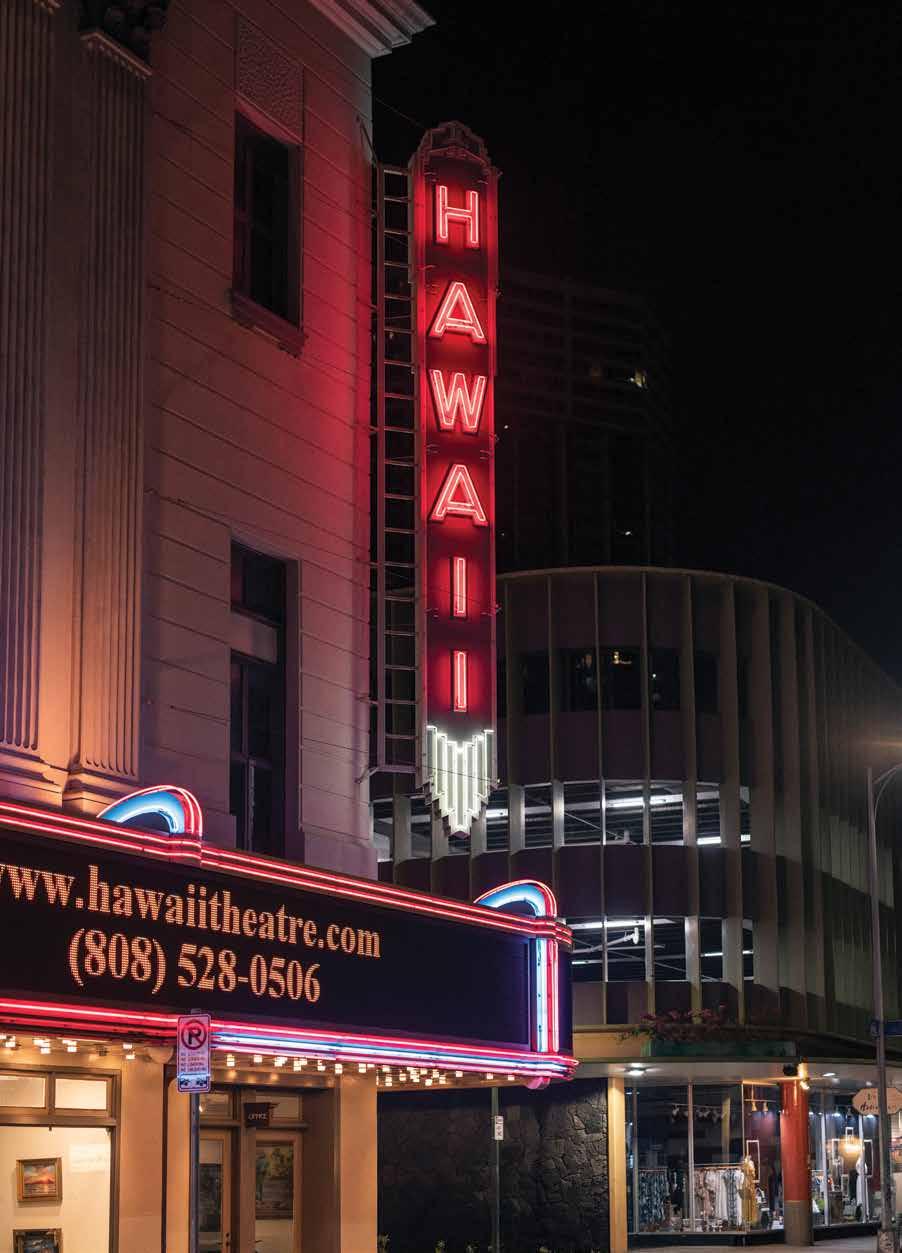
Stringed Revival
弦が奏でる音楽
In the charming studio of a Kailua luthier, vintage instruments awaiting restoration hold charming songs and hidden stories.
ビンテージ楽器の修復を手がけるカイルアの小さ な工房。ここにはハワイアン音楽の知られざる壮大 な物語が待っていました。
하와이에서 빈티지 현악기의 멋진 세계를
비추고 있습니다. 설립자 겸 제작자 Kilin
Rece는 우쿨렐레, 기타, 만돌린의 복원,
文 = ダイアン・エイコ
Text by Diane Ako Images by John Hook 写真 = ジョン・フック
수리, 설계 및 제작을 전문으로 합니다.
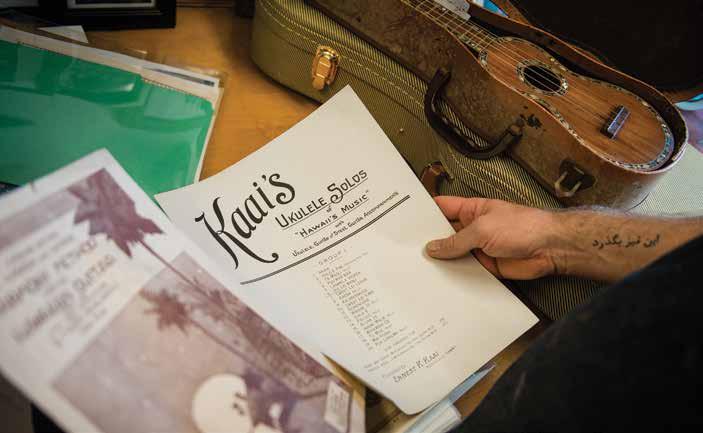
In a bright, cramped workspace in Kailua, Kilin Reece takes me time traveling. The 44-yearold luthier is surrounded by wood and string instruments of all types—flattop acoustic guitars, ‘ukulele, archtop guitars, and mandolins. Many of them are vintage. Some hang from the walls or rest on counters. Others sit in their cases on the floor. All of them await Reece’s attention.
所狭しとものが置かれているカイルアの明るい工房で、キリン・リースさん は私を時間旅行に連れ出してくれた。弦楽器製作者のリースさんは44歳。 彼の工房は多様な木材やフラットトップギター、ウクレレ、アーチトップギタ ー、マンドリンなど、いろいろな弦楽器でいっぱいで、その多くはビンテージ 楽器だ。壁にかけられているものもあれば、カウンターの上に置かれている もの、ケースに入って床の上に置かれているものもあり、どれもリースさんが 手を触れるのを待っている。
PALM
82 D DESIGN Luthier
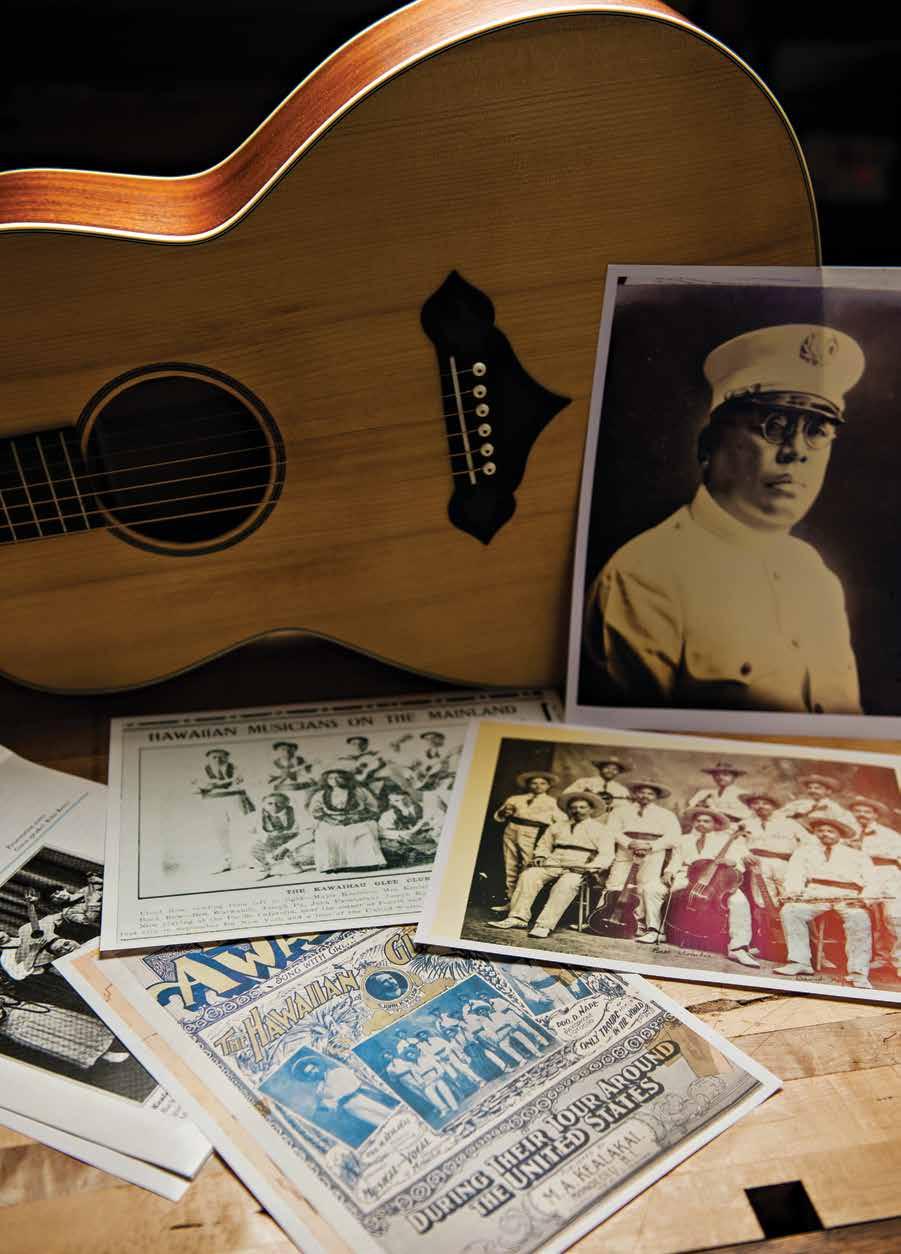
“Think of all the history here,” he says. “These old instruments were loyal partners in music-making for years, to people who were farmers, plumbers, maybe even kings and queens. They are a witness to history.”
Now, those instruments, which he calls “kūpuna of wood and wire,” have arrived at his shop for tune-ups. Reece owns KR Strings, a stringed-instrument restoration shop. He knows how to build new instruments, but over the years, he found his calling to preserve older pieces.
Reece thinks of them less as musical instruments and more as living entities. “I’m lucky to have spent hours peering into old instruments,” he says. “I’ve found love letters, set lists, locks of hair, lyrics, in either the instrument itself or the case. I like to think about who made the instrument, and where in the world it went with its owner. People say, ‘If this old guitar could talk.’ But they do! We just need to listen with our ears and our hands.”
I pick up the instrument nearest to me, an ‘ukulele, and ask what it says to Reece. He caresses it with his rough hands, then answers, “It’s from the 1890s. It’s got elaborate mother-of-pearl inlay, so it’s not cheap. It was handmade.” He fingers a small crack on the face and explains that it’s here to get the fracture fixed.
“What it really tells, though, is a story of humanity,” he continues. “Music is the common ground that transcends race, culture, and class.”
An avid researcher of the instruments that arrive at his shop, Reece, who is also a professional bluegrass musician, has developed an ear for the history of his craft. While researching one of his instruments, he realized that Hawai‘i has had a huge, and thus far uncredited, influence on modern music. To explain what he means, he grabs a blonde-colored guitar and strums a few soft, soulful bars.
“Do you recognize that?” he asks with anticipation.
It’s “Blackbird” by the Beatles, whose rock tunes permeate geography and time. Paul McCartney crafted it on a Martin dreadnought guitar; John Lennon owned one of those guitars, too.
Reece then points out that the influential English band’s music had an unexpected Hawaiian influence. “This is a dreadnought guitar that I played it on, which is the most popular acoustic guitar in the world,” he says, drawing out the suspense. “Even if people don’t know guitar types, everyone’s probably heard music produced on a dreadnought.” The dreadnought’s ancestor, he shares, was a model called the Kealakai, made for a Hawaiian musician about 100 years ago.
「ここにはたくさんの歴史があるんだよ。この楽器たちはみんな、かつて の持ち主の忠実なパートナーとして長年一緒に音楽を奏でたに違いない。持 ち主はお百姓さんや配管工だったかもしれないし、もしかしたら王族だったか もしれない。歴史の証人なんだよ」とリースさんは語る。
リースさんが「木と弦のクプナ(長老)」と呼ぶこれらの楽器は、調整のた めに彼の工房に送られて来る。「KRストリングス」という名のこの工房は弦楽 器の修復を専門としている。リースさんは新しい楽器を製作する技術も持つ が、いつしか古い楽器の修復を天職と考えるようになったそうだ。
リースさんは楽器たちを単なるモノではなく生命を持つ存在だと考えて いる。「古い楽器の中を何時間もかけて覗いてみる仕事ができて、私は幸運だ と思うよ。楽器の中やケースに、ラブレターや髪の毛の束や詩を見つけたこと もある。どんな人がこの楽器を作ったのか、そして楽器が持ち主と共に世界の どこを旅したのか、想像してみるのは楽しいね。『もし、この古いギターが口を きくことができたら』ってよく言うけど、楽器は語るんだよ!耳と手を使って聴 く必要があるんだ」とリースさんは言う。
私は手近にあったウクレレを取り上げて、その楽器が何を語っているのか リースさんに尋ねた。硬い手のひらで楽器を優しくなでると、リースさんは答え た。「1890年代に作られたものだね。真珠母貝の精巧な細工があるから、安 いものじゃない。人の手で作られたものだよ」。楽器の表面にある小さな傷に 指をすべらせ、このヒビはこの工房で修理したのだと説明してくれる。 「でも本当のところ、楽器が語ってくれるのは人間の歴史なんだ。音楽は、人 種や文化や階級を超えた共通の基盤だからね」とリースさんは続ける。
リースさんは工房に届く楽器について常に熱心に調査する。彼自身ブル ーグラスの演奏家でもあり、ギターの音の中に隠された歴史を聴き分ける力を 身につけてきた。楽器の一つについて調べるうち、リースさんはハワイが現代 の音楽界に、ほとんど一般には知られていない大きな影響を与えていることを 発見したという。それを説明するために、リースさんはブロンド色のギターを 手にとって、ソウルフルで柔らかなフレーズを奏でてみせた。
「これ、何て曲だか分かるかい?」
世界的なヒット曲となったビートルズの『ブラックバード』だった。ポー ル・マッカートニーがこの曲を作るのに使ったのはマーティン社のギター「ドレ ッドノート」。ジョン・レノンも所有していたギターだ。
リースさんは、ビートルズの音楽には意外にもハワイの影響があると指摘 する。「このドレッドノートは、世界で一番人気のあるアコースティックギター なんだ。ギターの種類を知らない人でも、このギターで作られた曲は聴いたこ とがあるはずだ」と、リースさんは続ける。ドレッドノートの前身は「ケアラカイ」 という名のモデルで、100年ほど前にとあるハワイアン・ミュージシャンのため に作られたものだったという。
84 D PALM
DESIGN Luthier
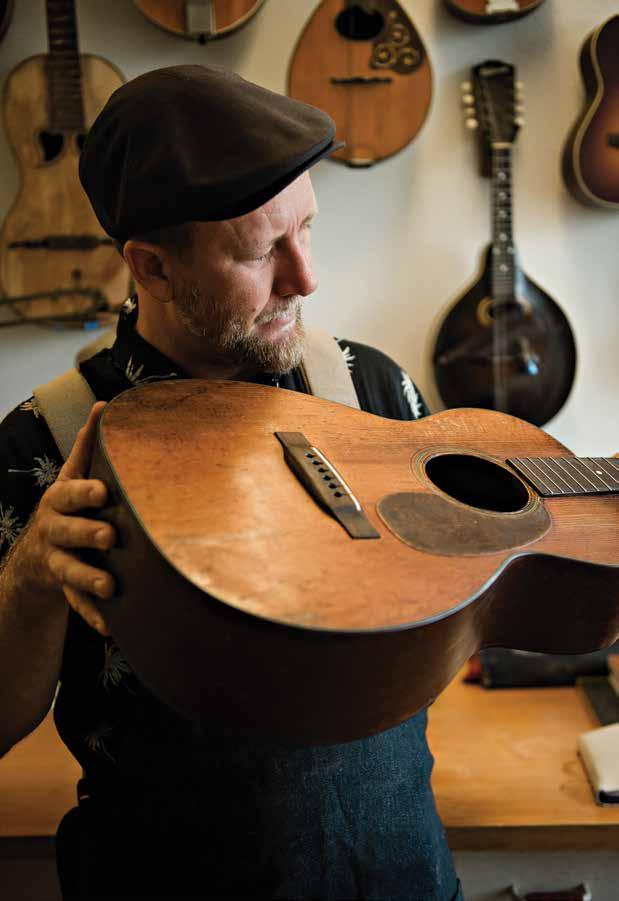 Kilin Reece, owner of KR Strings, is a luthier based in Kailua.
Kilin Reece, owner of KR Strings, is a luthier based in Kailua.
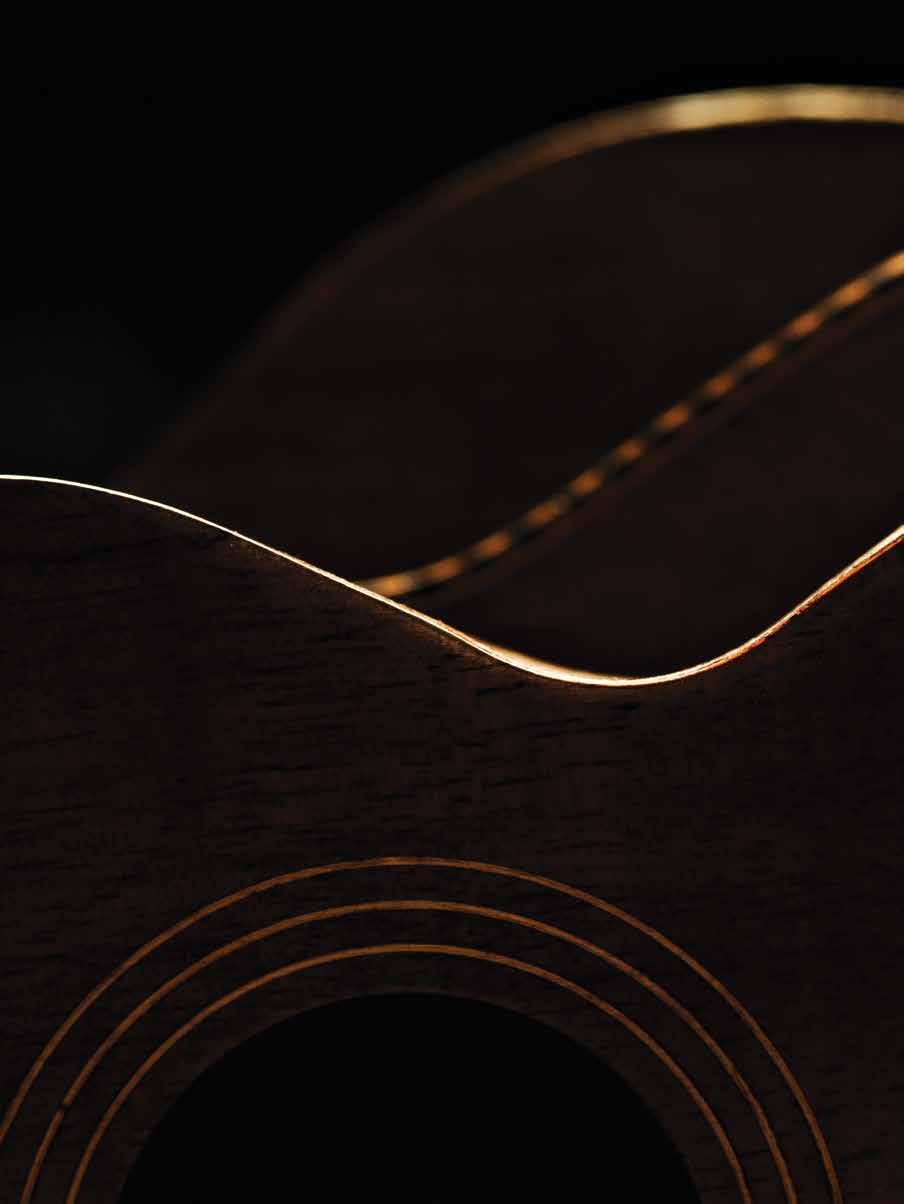
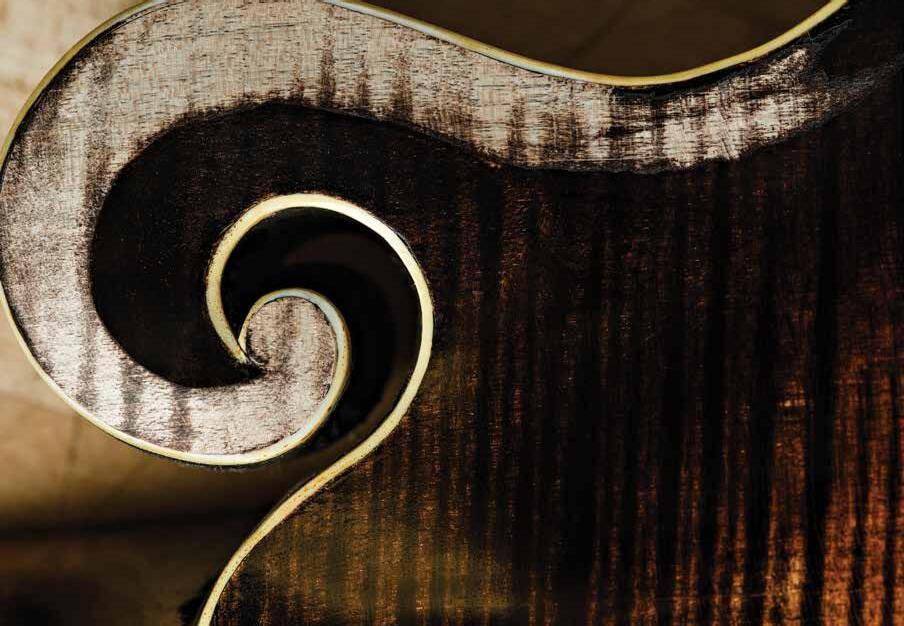
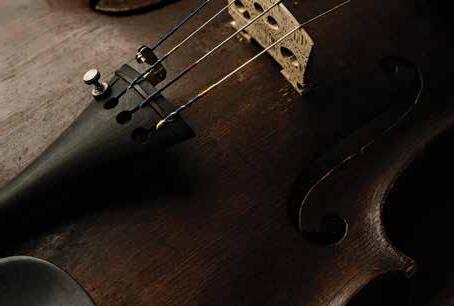
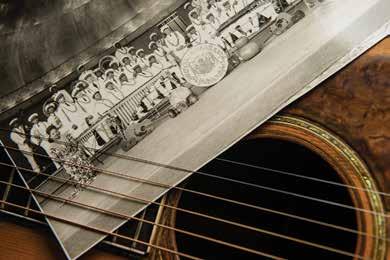

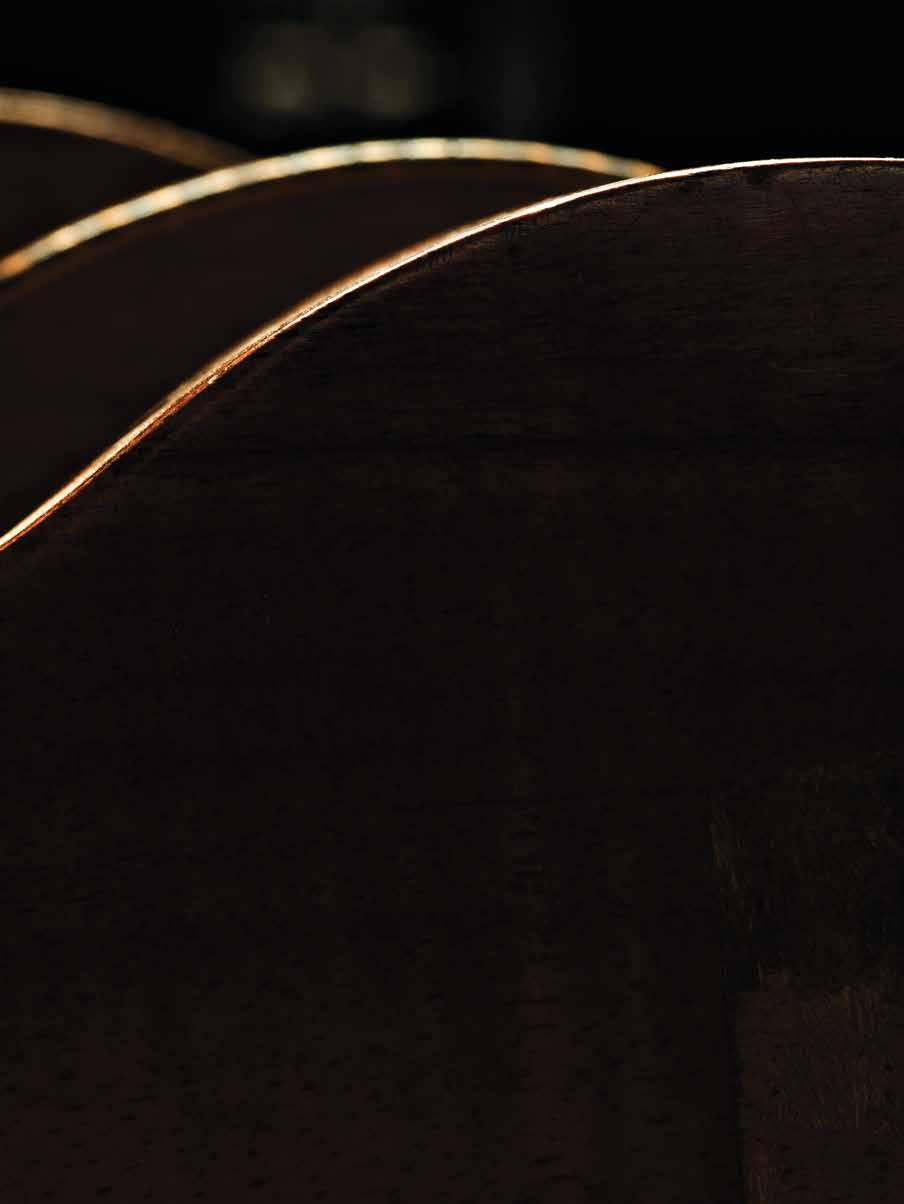
He had this epiphany after delving into the origins of his own beloved dreadnought guitar. Its origins, Reece found, start in 1867 in the Kingdom of Hawai‘i with the birth of Mekia Kealakai, a boy who became a worldclass musician. According to biographers, Kealakai skipped school so often that his parents sent him to the Reformatory School of Honolulu when he was 12 years old. That school had a band led by Henry Berger, more famously remembered as the Royal Hawaiian Band conductor.
In 1883, Berger took the reform school band to San Francisco to compete—the first trip abroad for the Royal Hawaiian Band. Kealakai was there as a 15-year-old reform school graduate. They introduced the world to a completely new sound: glee club songs of the Hawaiian Kingdom on ‘ukulele, mandolin, banjo, and guitar. It was a musical style developed in Hawai‘i in the 1870s, and Reece cites newspapers of the time, like the San Francisco Chronicle, raving about the concert using words like “new, novel, unprecedented, and exciting.”
For the following 10 years, Kealakai worked as a professional Royal Hawaiian Band musician. Then he toured the United States and Europe for the better part of the next 15 years, “spreading his music and pushing expectations of stringed instruments,” Reece says. In 1916, Kealakai asked Martin Guitar Co. to make him a new instrument: an extra-large jumbo steel-string guitar. He was the first person after which the company named a guitar model. “The templates for the Kealakai were used to create the very popular dreadnought guitar,” Reece says, “which is the most popular acoustic guitar in the world.”
Reece’s growing fascination with turn-of-the-century Hawaiian string music took him to the American Folklife Center at the Library of Congress in Washington, D.C. There, he stumbled across a musical recording circa 1904 of a Hawaiian string band known as The Royal Hawaiian Troubadours and The Honolulu Students. “This is probably the earliest recorded string band music in the world,” Reece claims.
ドレッドノートの起源を調べるうちに、リースさんはこの発見をしたそう だ。話は1867年にさかのぼる。その年、ハワイ王国で、後に世界的なミュー ジシャンとなるメキア・ケアラカイが生まれた。伝記によれば、ケアラカイがあ まりにも学校をさぼるので、両親は彼が12歳の時にホノルルの更生施設に入 れたという。この施設には楽団があり、ロイヤル・ハワイアン・バンドの指揮者 として知られるヘンリー・バーガーが指導していた。
1883年、バーガーはこの学生たちの楽団を率いてサンフランシスコで行 われたコンペティションに参加した。ロイヤル・ハワイアン・バンドとしても初の 海外遠征であり、更生施設の学校を卒業したばかりの15歳のケアラカイも遠 征に参加していた。このコンペティションで、楽団は聴衆が聴いたことのない まったく新しい音楽を披露した。ウクレレやバンジョー、マンドリン、ギターが 伴奏するハワイ王国の合唱曲だ。1870年代にハワイで発展した音楽形式に 聴衆は沸き、『サンフランシスコ・クロニクル』紙をはじめとする当時の新聞はこ の演奏を「新しく、これまでにない、エキサイティングな」音楽だと激賞した。
それから10年間、ケアラカイはロイヤル・ハワイアン・バンドでプロの演 奏家として活躍し、その後に続く15年は大半を米国各地やヨーロッパの演奏 旅行に費やした。「自分の音楽を世界に広め、ギター音楽に対する皆の考え方 を変えていったんだ」とリースさんは説明する。1916年、ケアラカイはマーテ ィン社に、スチール弦の特大ギターを発注した。マーティン社のギターのモデ ルに人の名前が冠されたのは「ケアラカイ」が初めてだった。「ケアラカイのテ ンプレートを使って、ドレッドノートのギターが作られた。そしてドレッドノート は世界で最も人気のあるギターになったんだよ」とリースさんは語る。
20世紀初頭のハワイ音楽に惹きつけられたリースさんは、ワシントンDC の議会図書館にあるフォークライフ・センターを訪ね、そこで「ザ・ロイヤル・ハ ワイアン・トルバドゥールズとホノルルの学生たち」というハワイの楽団による 1904年頃の録音に出逢った。「これはおそらく、世界で一番古い弦楽バンドの 録音じゃないかと思う」とリースさんは言う。
88 D PALM
DESIGN Luthier
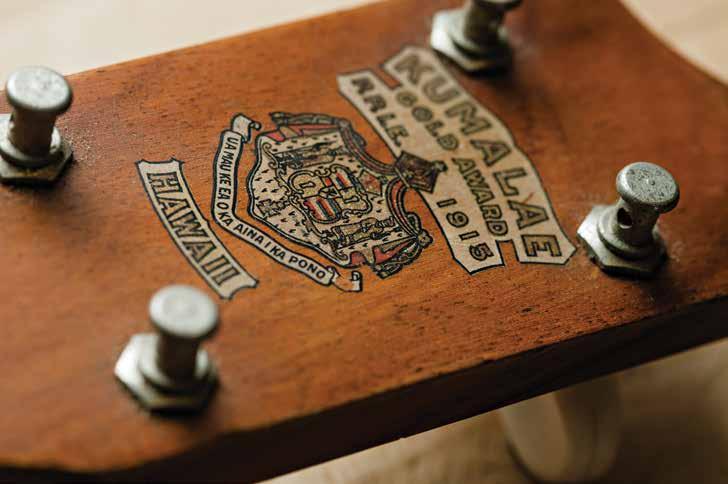
In his research, Reece realized Hawai‘i’s huge, and thus far uncredited, influence on modern music.
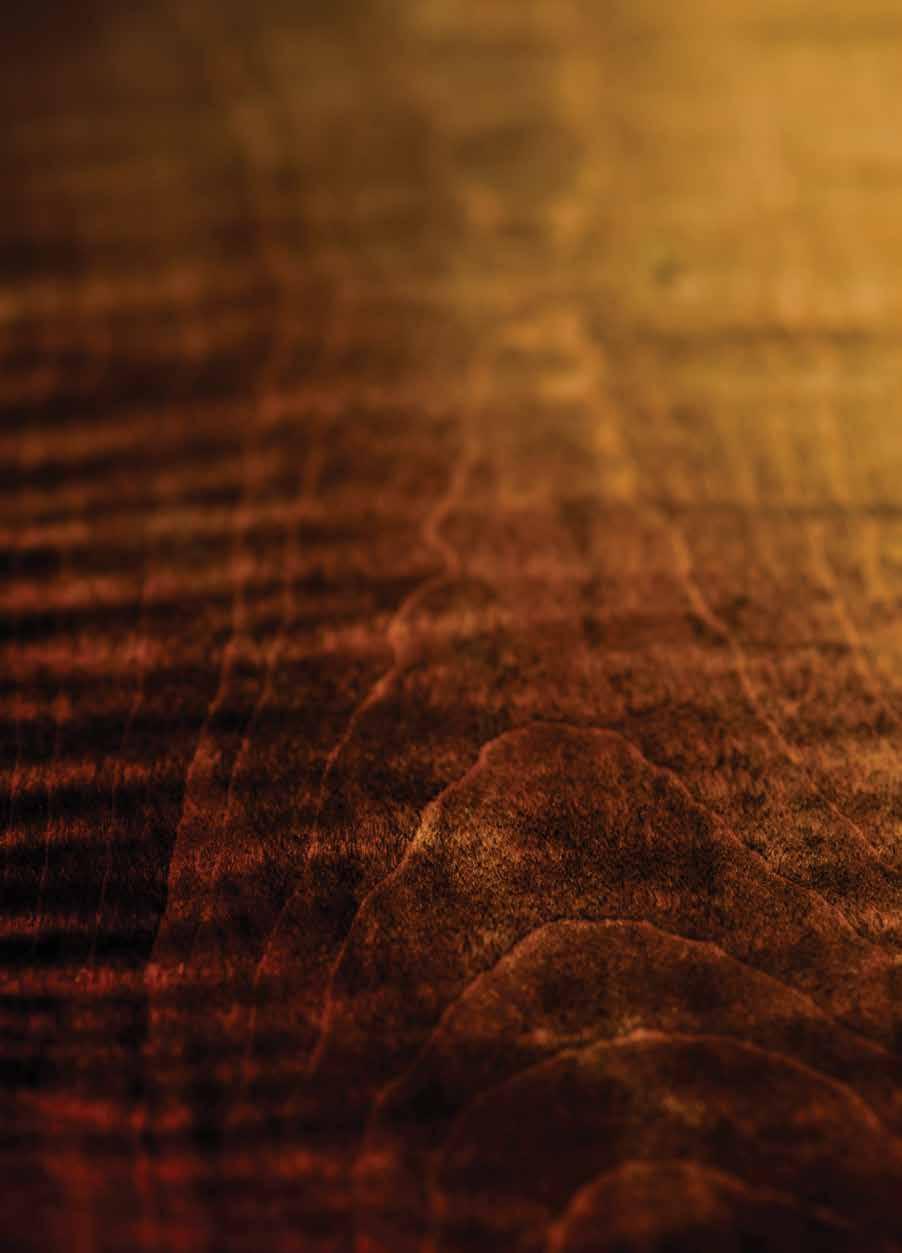
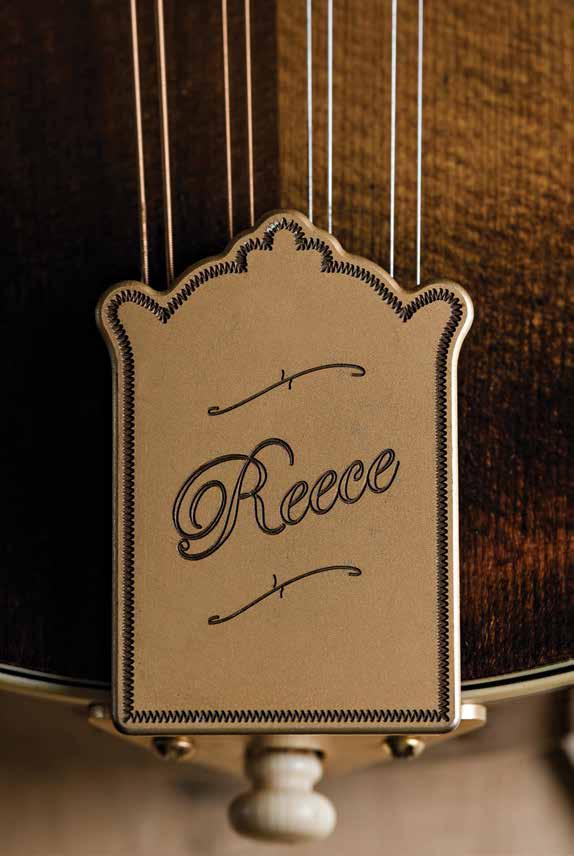
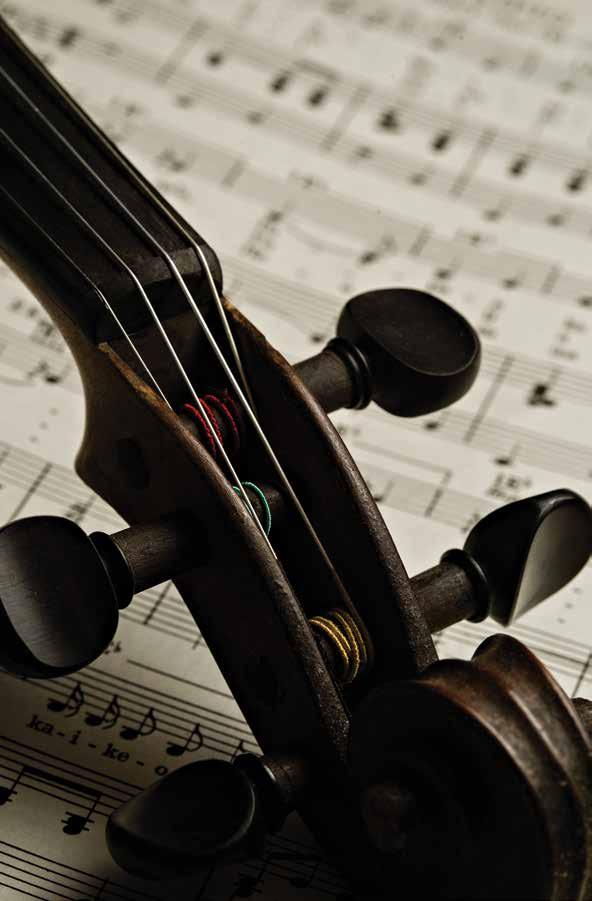
Reminiscent of American folk music, the recording was made before the first popular wave of early country music, which began around the mid to late 1920s with the Carter Family and Jimmie Rogers’ earliest recording for Victor Records. “Hawai‘i was not some isolated place that only received information,” Reece says. “It formed the soundscape, even in rural Kentucky, such that everyone was dreaming in Hawaiian music at that time.” Reece ticks off a list of the most iconic creators of popular Americana song tradition, like Jimmie Rogers, Bill Monroe, and “Mother” Maybelle Carter, all of whom he said grew up with Hawaiian string band repertoire.
Tunes many of us know and love, such as “Aloha ‘Oe” by Queen Lili‘uokalani, “Hawai‘i Pono‘ī” by King David Kalākaua, and “Hi‘ilawe” by Sam Li‘a Kalainaina, were written a century and a half ago. “Modern music owes much of its origin to Hawai‘i and these Hawaiian musicians,” Reece says. “It’s an incredibly vibrant and untold story, and the people who shaped that history are fascinating.” And it’s a piece of overlooked history he’s determined to bring to light.
In January 2019, Reece formed the nonprofit Kealakai Center for Pacific Strings, with the goal to “bring the backstory to the public.” He also co-organized a concert at St. Andrew’s Cathedral in Honolulu featuring an array of music from late 19th-century Hawai‘i. Local luminaries like Aaron Mahi, Puka Asing, Raiatea Helm, Starr Kalahiki, and Jeff Peterson enthralled a packed house. Reece took the stage as lead vocalist and guitarist to perform “Kentucky Waltz” accompanied by the Sovereign Strings Band.
The silky, earnest quality of his voice fell into place with the resonant sounds of the Hawaiian string band. “Kentucky Waltz” is a dead ringer for an earlier Hawaiian song “Pua Lilia,” and even in the first bars, I can hear both cultures beautifully synthesized in the ditty: the lonesome sound of bluegrass melding with the heartfelt strains of Hawaiian steel guitar. The full weight of his pronouncements hit me as I sat in the audience listening to him. I fixated on each stringed instrument that sounded from the stage and remembered something Reece said about their inner voices: “We build a box, stretch strings across it, and invite magic to live inside.”
この録音はカントリー音楽が広まる前のもので、アメリカのフォーク音楽 によく似ている。カントリー音楽は1920年代なかばから後半にかけて興隆 し、その最も古い録音はカーター・ファミリーやジミー・ロジャーズがビクター から出したものだ。 「ハワイは情報を受け取る一方の孤立した場所ではなく、 新しい音の世界を作り出していたんだ。当時はケンタッキーの田舎でも、みん ながハワイアン音楽に憧れていたんだよ」とリースさんは力説する。ジミー・ロ ジャーズ、ビル・モンロー、「ギターの母」と異名を取るメイベル・カーターなど、 アメリカの有名なソングライターは皆、ハワイの弦楽バンドのレパートリーを聴 いて育ったのだという。
リリウオカラニ女王の作った名曲『アロハ・オエ』や、カラカウア王が作詞 した『ハワイ・ポノイ』など、今でもハワイで愛されている曲の多くは150年ほど 前に作られたものだ。「現在の音楽は、その起源の多くをハワイとハワイアンの ミュージシャンたちに負っている。とても力強い、知られざる話だし、その歴史 を形作ってきた人たちの話は本当に興味深いよ」とリースさんは目を輝かせる。 この埋もれた歴史に光を当てようとリースさんは奮闘している。
2019年1月、リースさんは「知られざる歴史を広める」目的で、非営利団 体ケアラカイ・センター・フォー・パシフィック・ストリングスを設立した。また、 ホノルルのセント・アンドリューズ大聖堂で行われた19世紀のハワイ音楽を紹 介するコンサートの共同開催も手がけた。コンサートは満員の盛況で、アーロ ン・マヒ、プカ・アシン、ライアテア・ヘルム、スター・カラヒキ、ジェフ・ピーターソ ンなど、そうそうたる地元ミュージシャンたちが観客を夢中にさせた。リースさ んも舞台に立ち、ソブリン・ストリングス・バンドのボーカルとギターを担当して 『ケンタッキー・ワルツ』を演奏した。
ギターが奏でる音楽に、リースさんのなめらかで心のこもった声がよく調 和する。『ケンタッキー・ワルツ』は、それよりも古いハワイの曲『プア・リリア』に 酷似しており、最初の数フレーズを聴いただけでも、双方の文化が見事に融合 しているのがわかる。ブルーグラスの寂しげな響きと、ハワイアン・スティール ギターの温かな音。客席で耳を傾けていると、音楽の重みに打たれる思いが した。ステージから響く弦楽器の響きに圧倒されながら、私は楽器たちが持つ 内なる声についての、リースさんの言葉を反芻していた。「箱を作って弦を張り わたして、それからその中に魔法を呼び込むんだ」
92 D PALM
Luthier
DESIGN

Ala Moana Center, the world’s largest open-air shopping center is home to over 350 stores, including more than 160 dining options.
Ala Moana Center features one of the best collections of luxury brands in the world including Cartier, Chanel, Dior, Gucci, Harry Winston, Hermès, LOUIS VUITTON, Prada, TIFFANY & CO. & many more.
Mon–Sat
• Sun 10am
7pm 808.955.9517 • FREE WI-FI • AlaMoanaCenter.com 1450 Ala Moana Blvd., Honolulu, HI 96814 Download the Ala Moana Center App from the App Store for iPhone
9:30am to 9pm
to
Country Solitude
Handsome suits in rustic colors infuse a beguiling sense of warmth to a brilliantly outfitted home in Waimea.
Images by Mark Kushimi
Styled by Ara Laylo
Hair & makeup by Jonah Dela Cruz, HMB Studios
田園のソリチュード
Modeled by Lance Walters
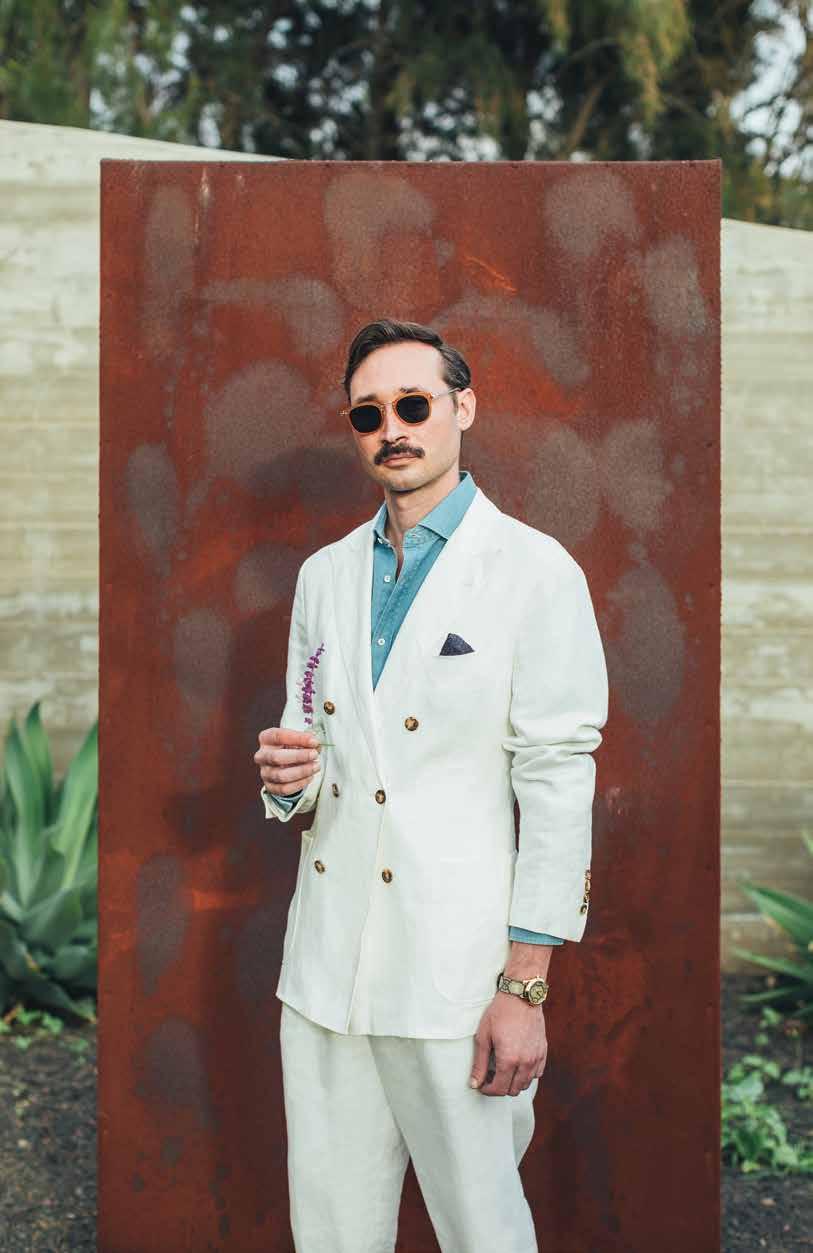
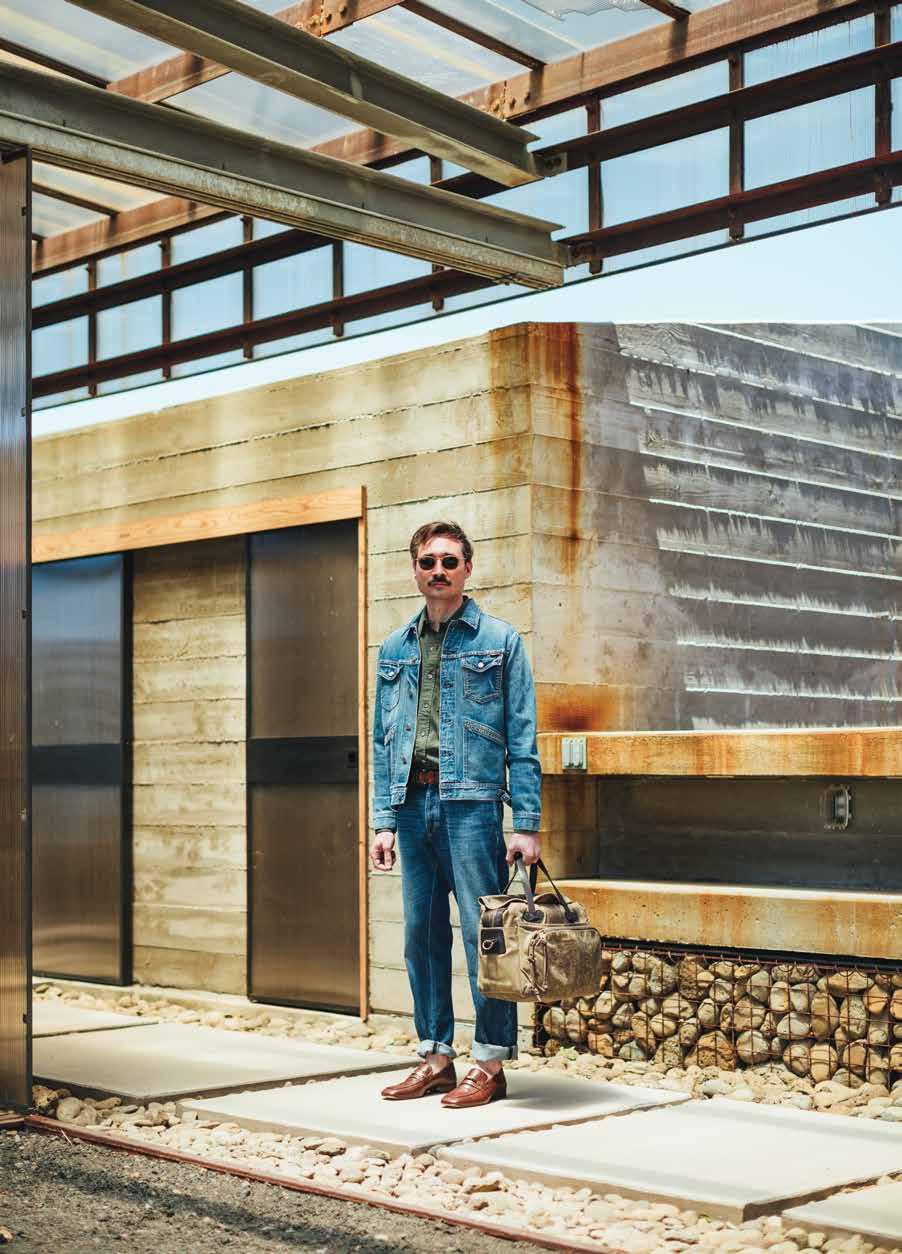
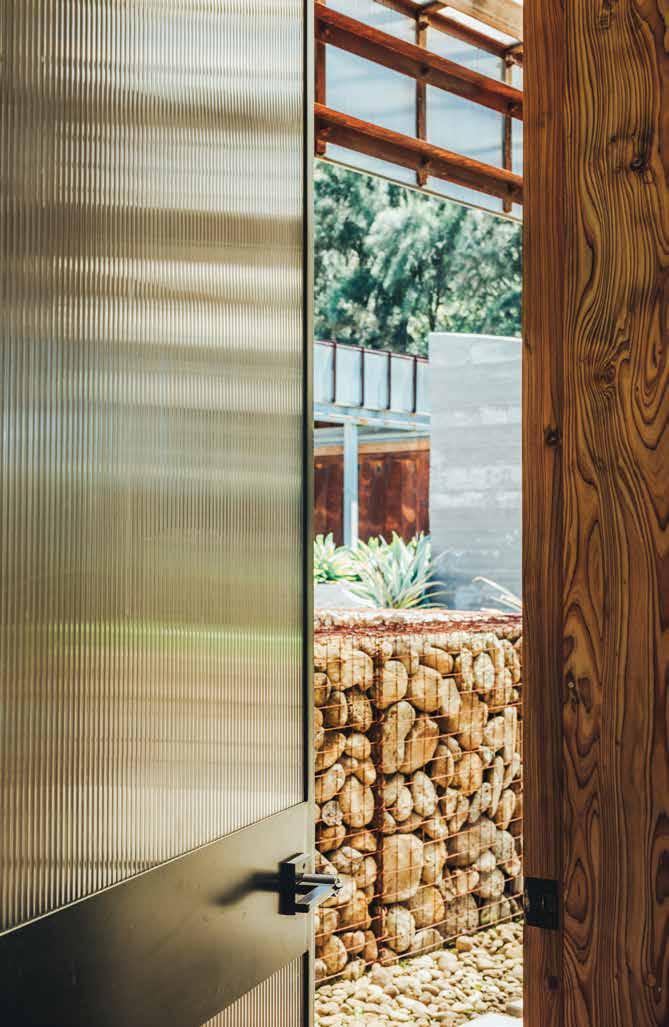 Shirt and jacket by Tom Ford , pants by Brunello Cucinelli, glasses by Oliver Peoples; all from Neiman Marcus. Shoes by Gucci.
Shirt and jacket by Tom Ford , pants by Brunello Cucinelli, glasses by Oliver Peoples; all from Neiman Marcus. Shoes by Gucci.
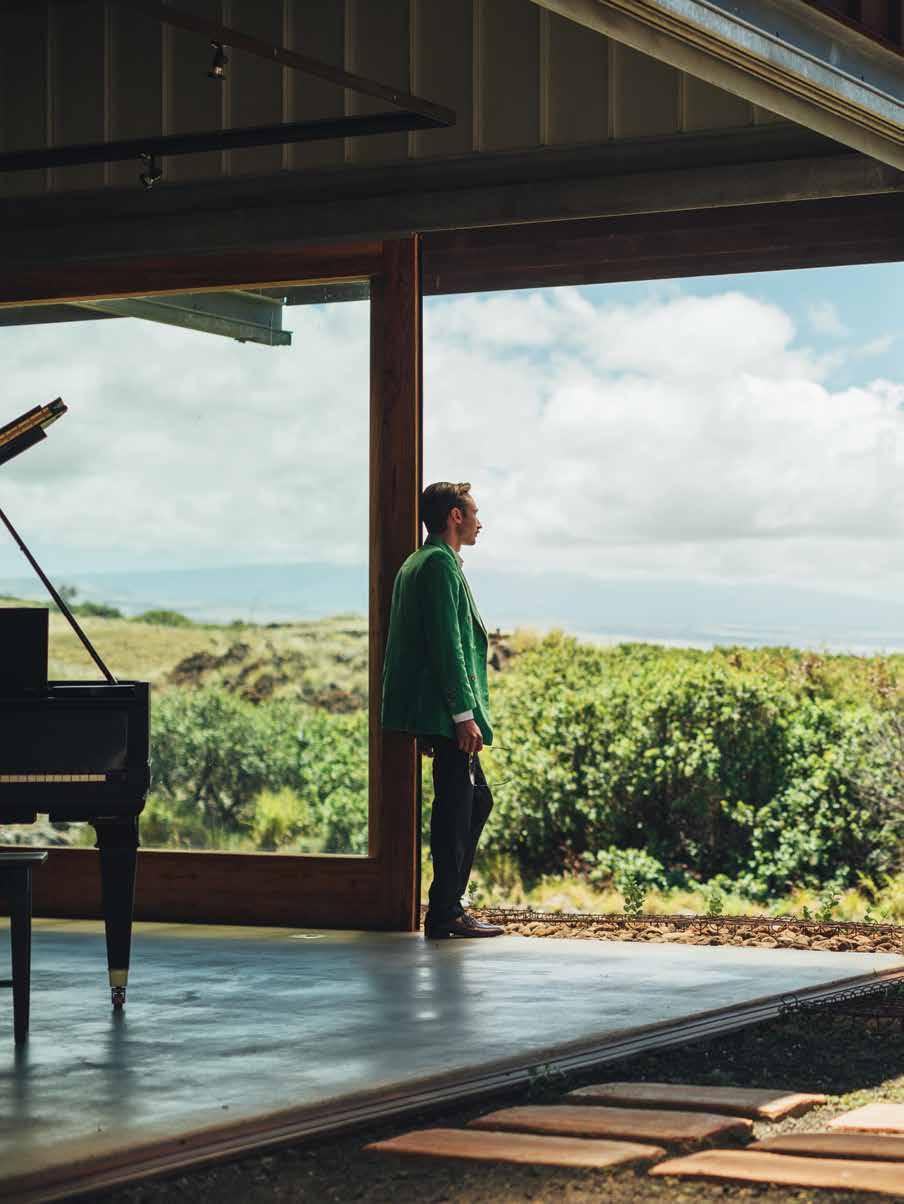
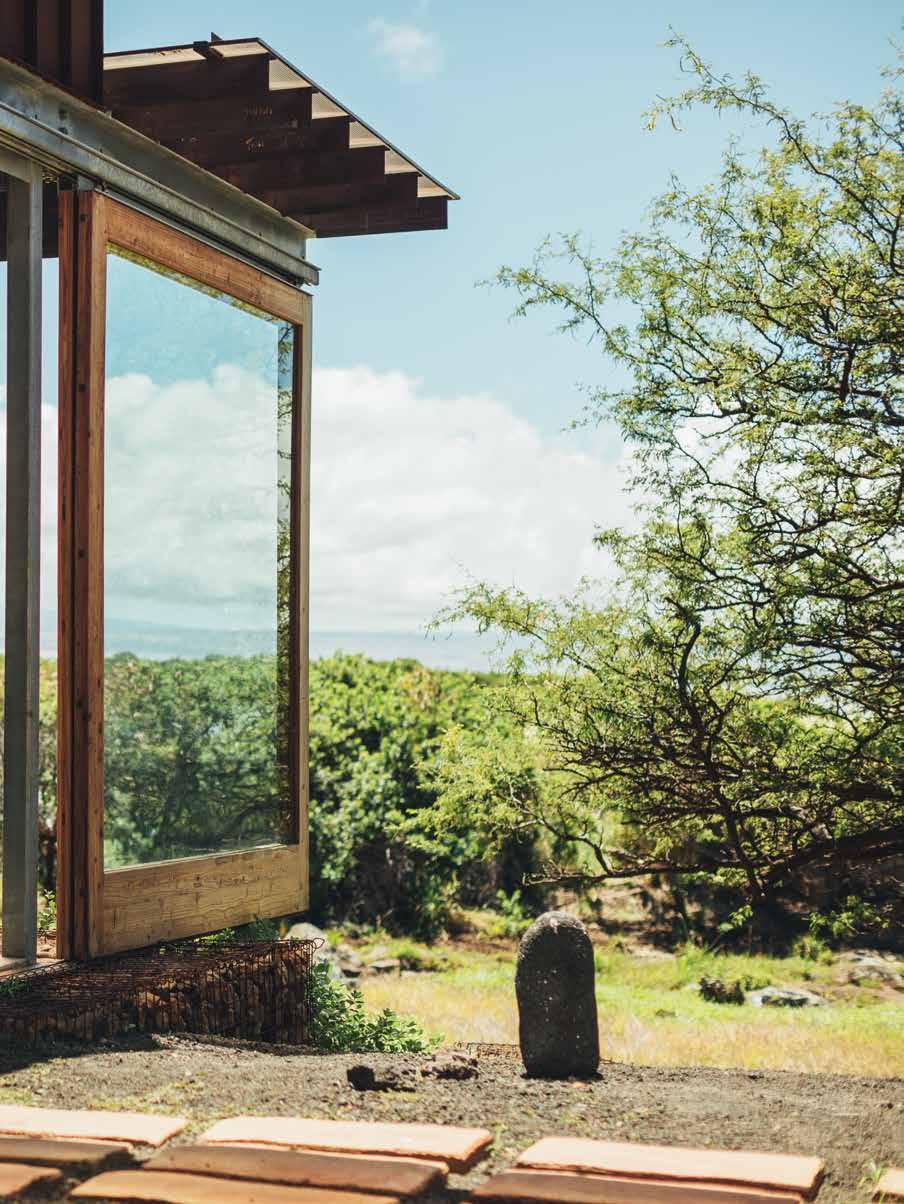
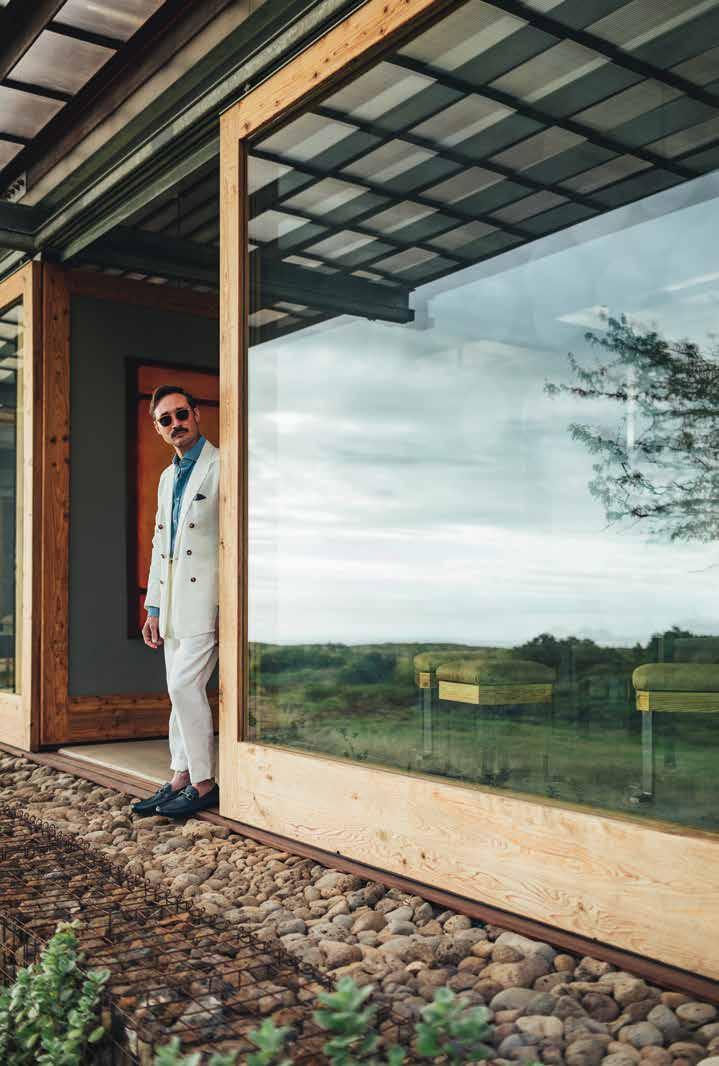
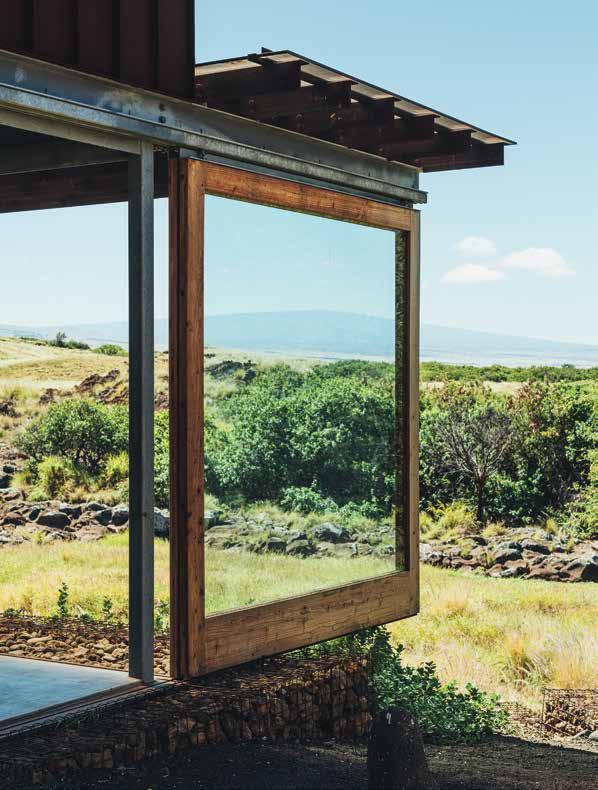 Suit and shirt by Brunello Cucinelli , sunglasses by Oliver Peoples, shoes by Salvatore Ferragamo; all from Neiman Marcus
Suit and shirt by Brunello Cucinelli , sunglasses by Oliver Peoples, shoes by Salvatore Ferragamo; all from Neiman Marcus
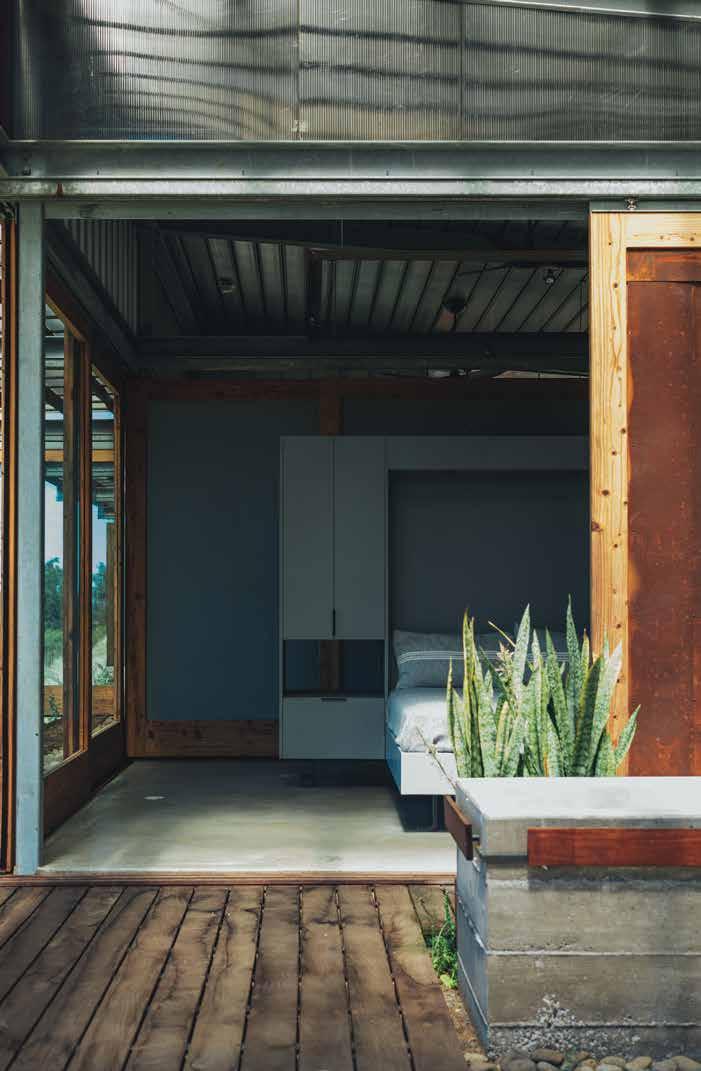
Jacket and shoes by Gucci. Sunglasses by Gucci; from Neiman Marcus. Shirt and pants model's own.
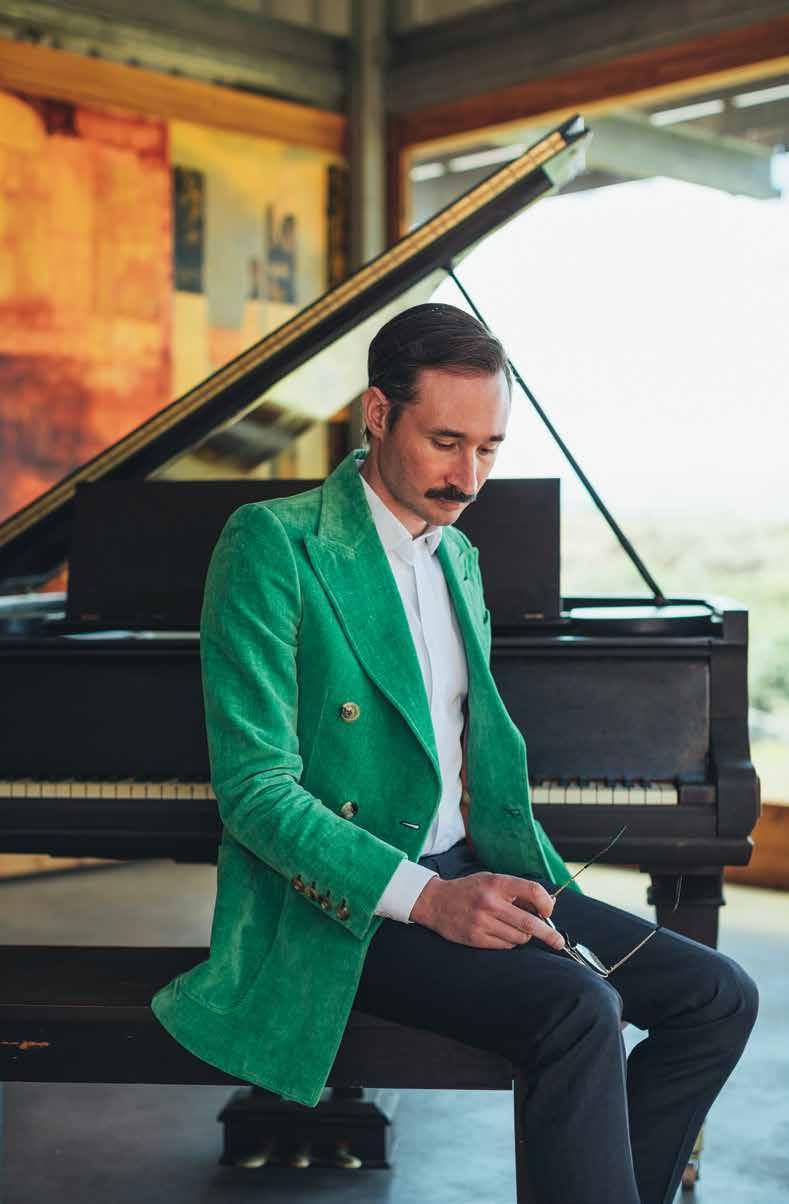
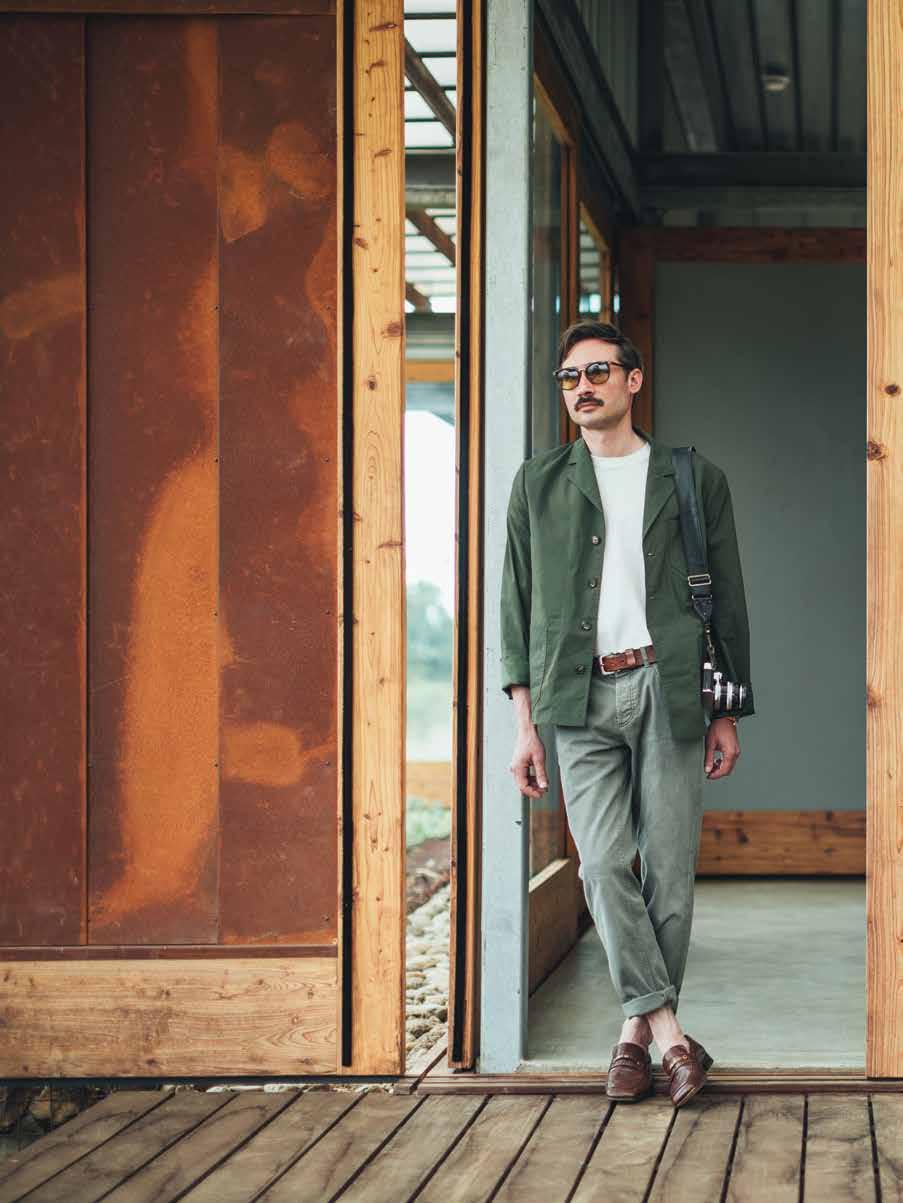 Shoes & sunglasses by Gucci
Jacket & shirt by Bottega Veneta
Pants by Brunello Cucinelli from Neiman Marcus
Shoes & sunglasses by Gucci
Jacket & shirt by Bottega Veneta
Pants by Brunello Cucinelli from Neiman Marcus
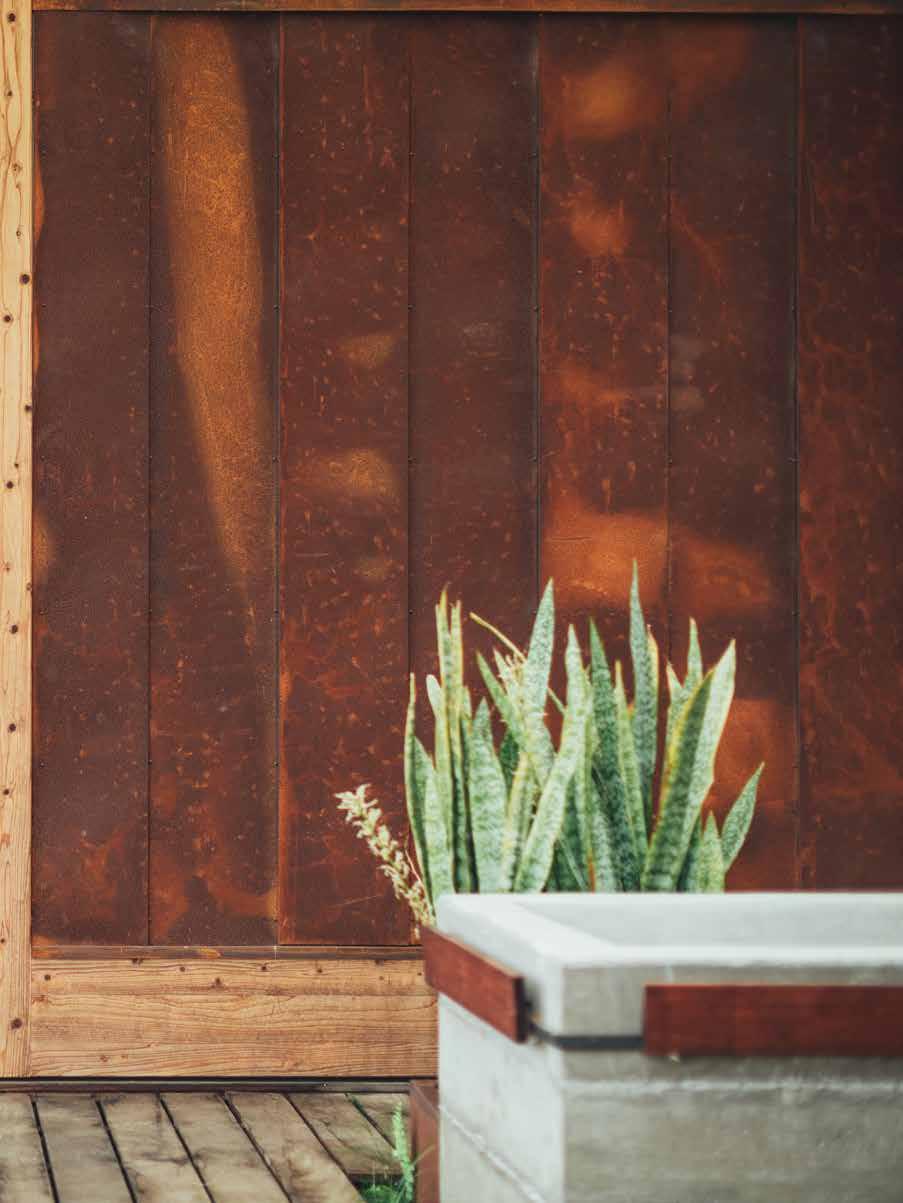
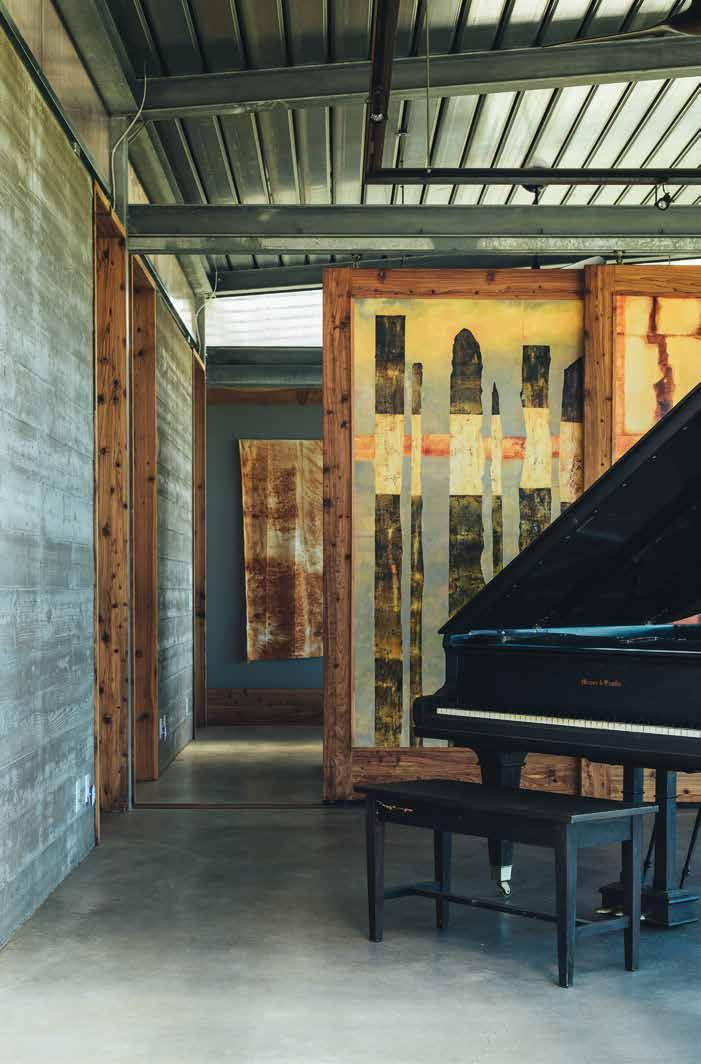 Suit and shirt by Brunello Cucinelli. Glasses by Barton Perreira; all from Neiman Marcus.
Suit and shirt by Brunello Cucinelli. Glasses by Barton Perreira; all from Neiman Marcus.
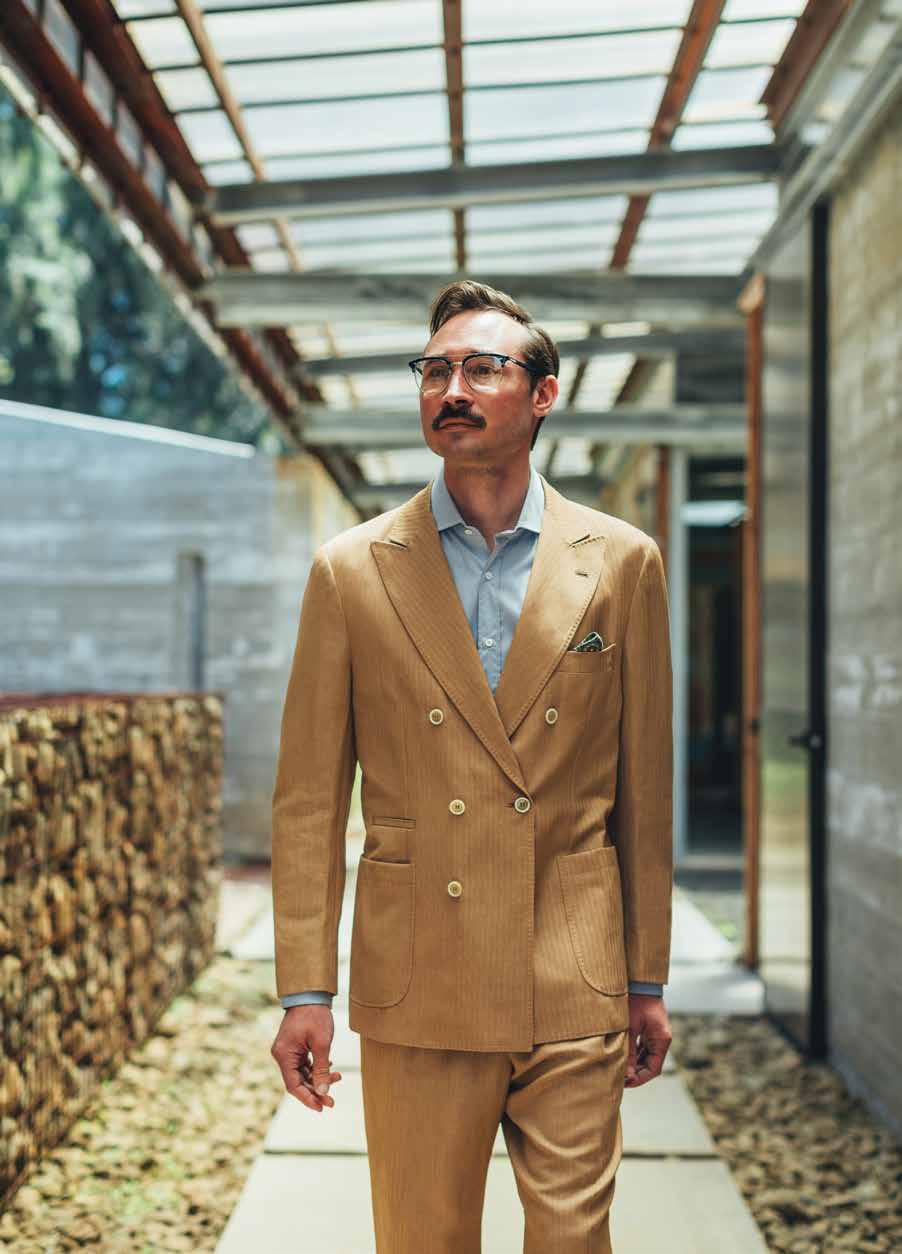
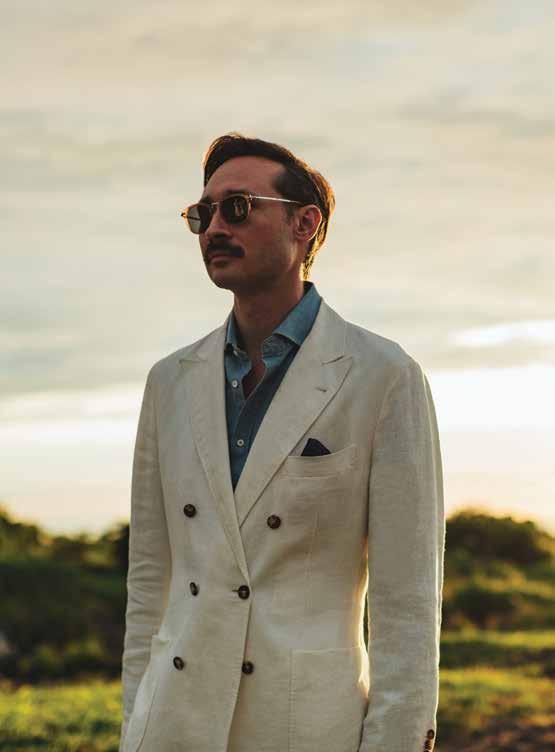
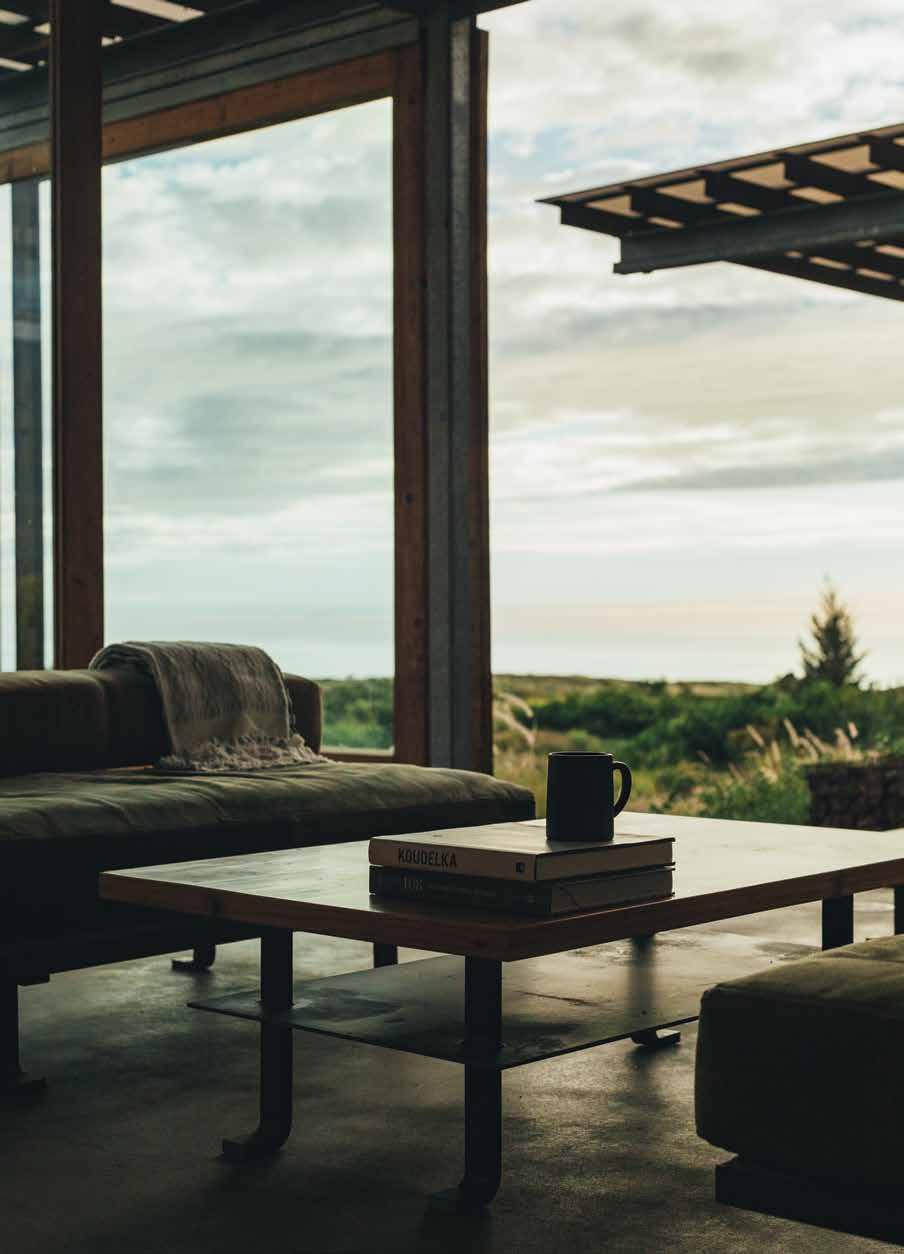
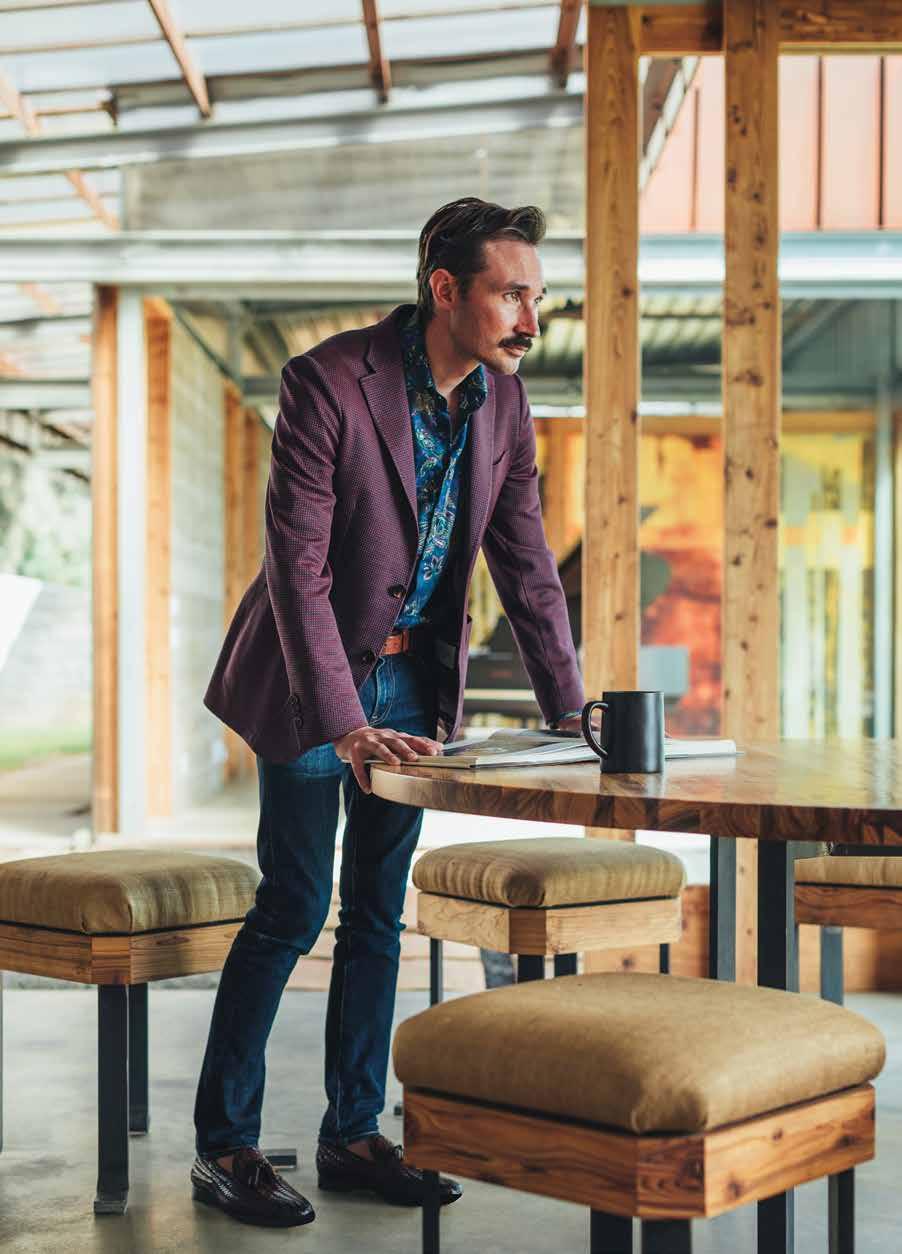
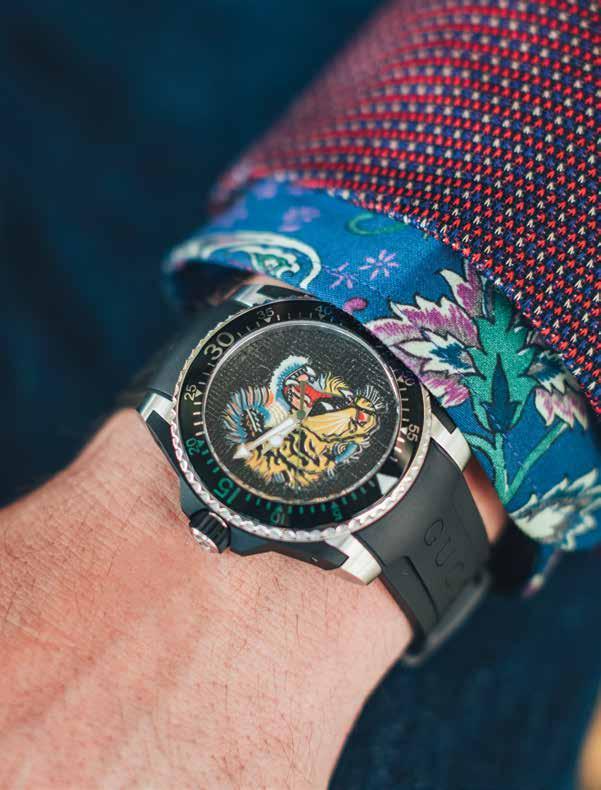 Jacket and shirt by Etro, shoes by Magnanni, watch by Gucci; all from Neiman Marcus. Pants, model's own.
Jacket and shirt by Etro, shoes by Magnanni, watch by Gucci; all from Neiman Marcus. Pants, model's own.
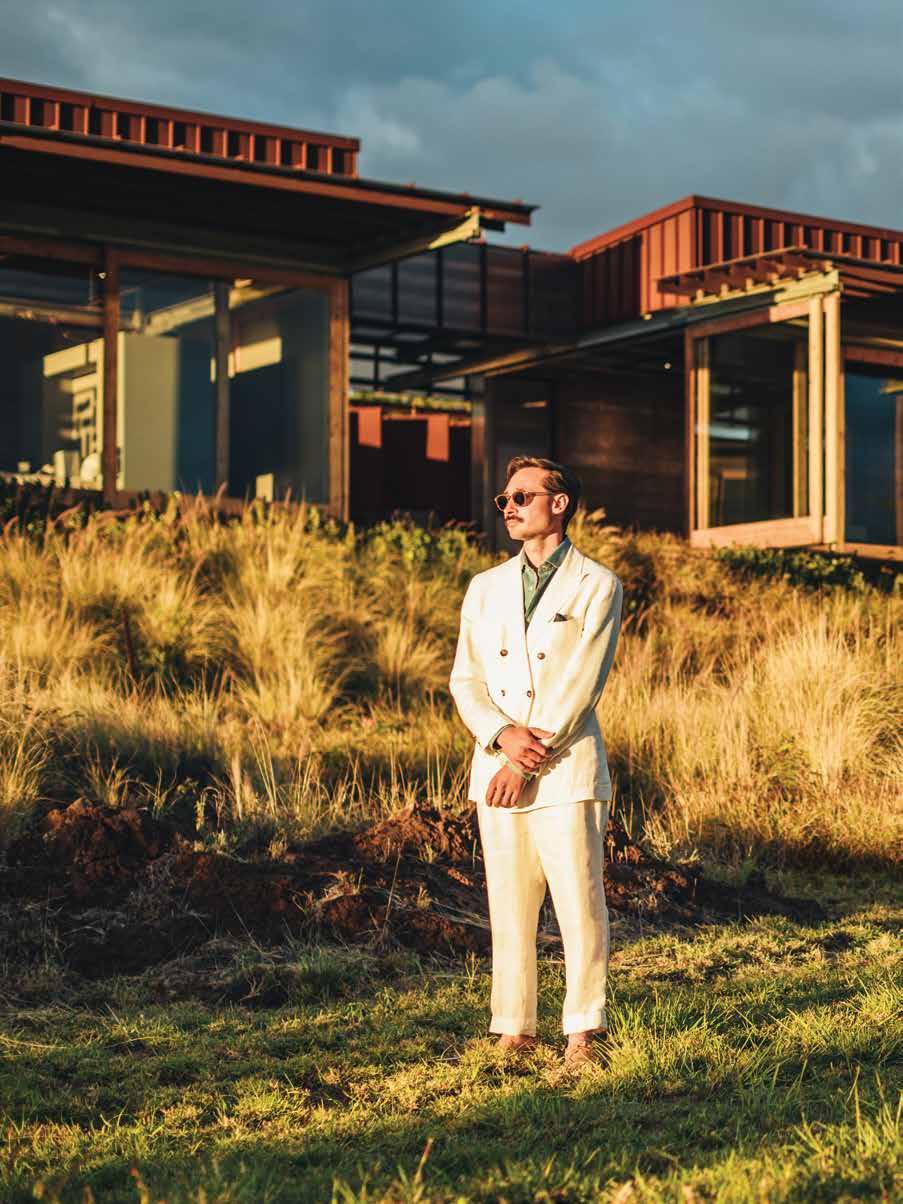
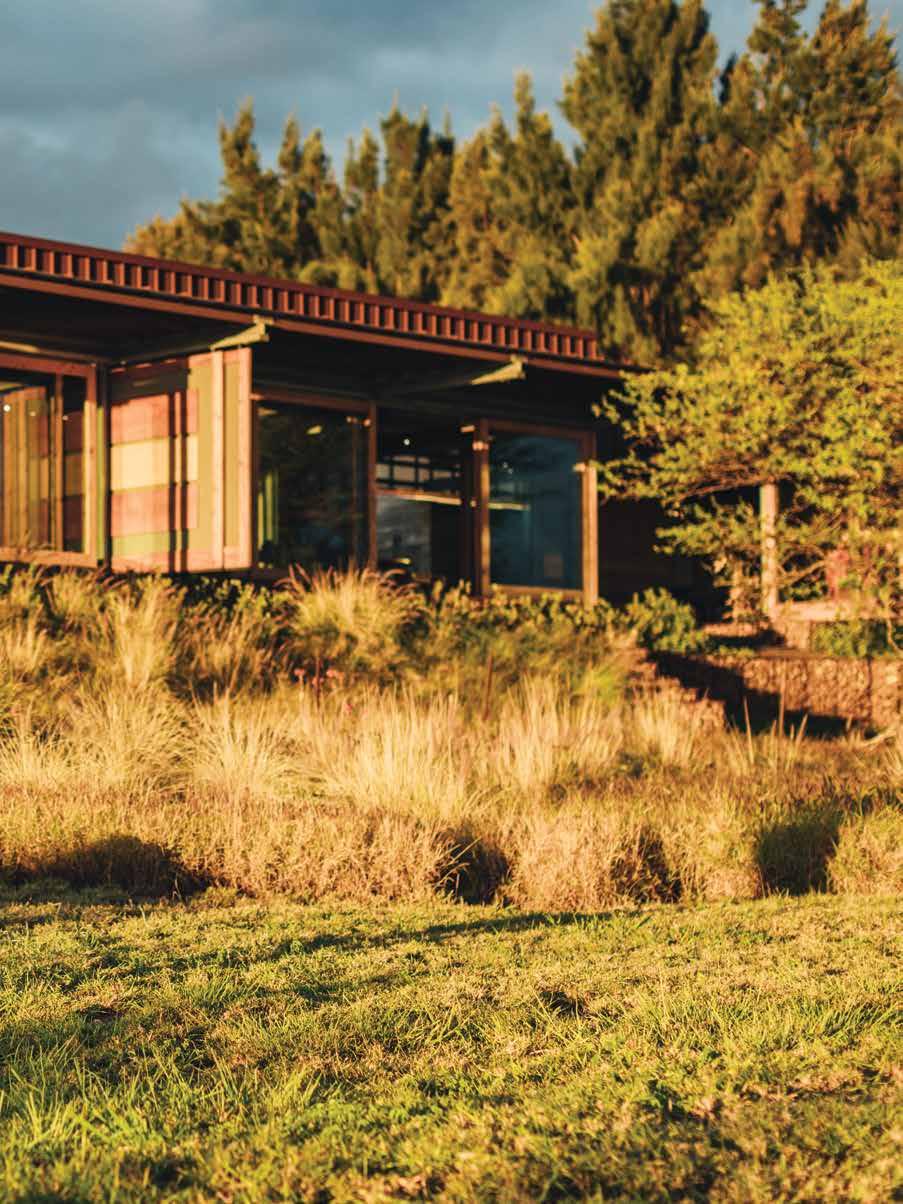
Travel
ES CA PES
experiences
both
E PALM エスケープ
CUL TU RE
of place that A sense fosters the human spirit
faraway and familiar
PALM PALM E
115
Swiss Storybook
Text by Kelsey Conant-Patterson
文 = ケルシー・コナント=パターソン
Images by Josiah Patterson
写真 = ジョサイヤ・パターソン
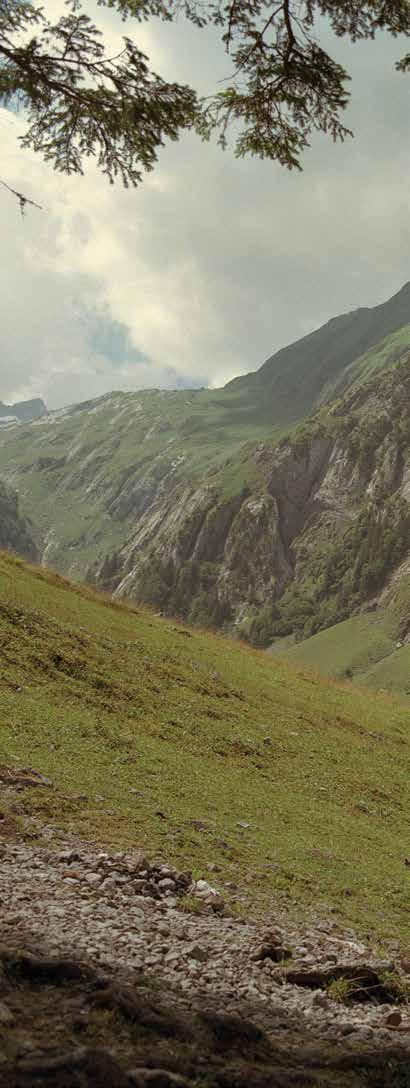
116 E EXPLORE Switzerland PALM
おとぎの国、スイス
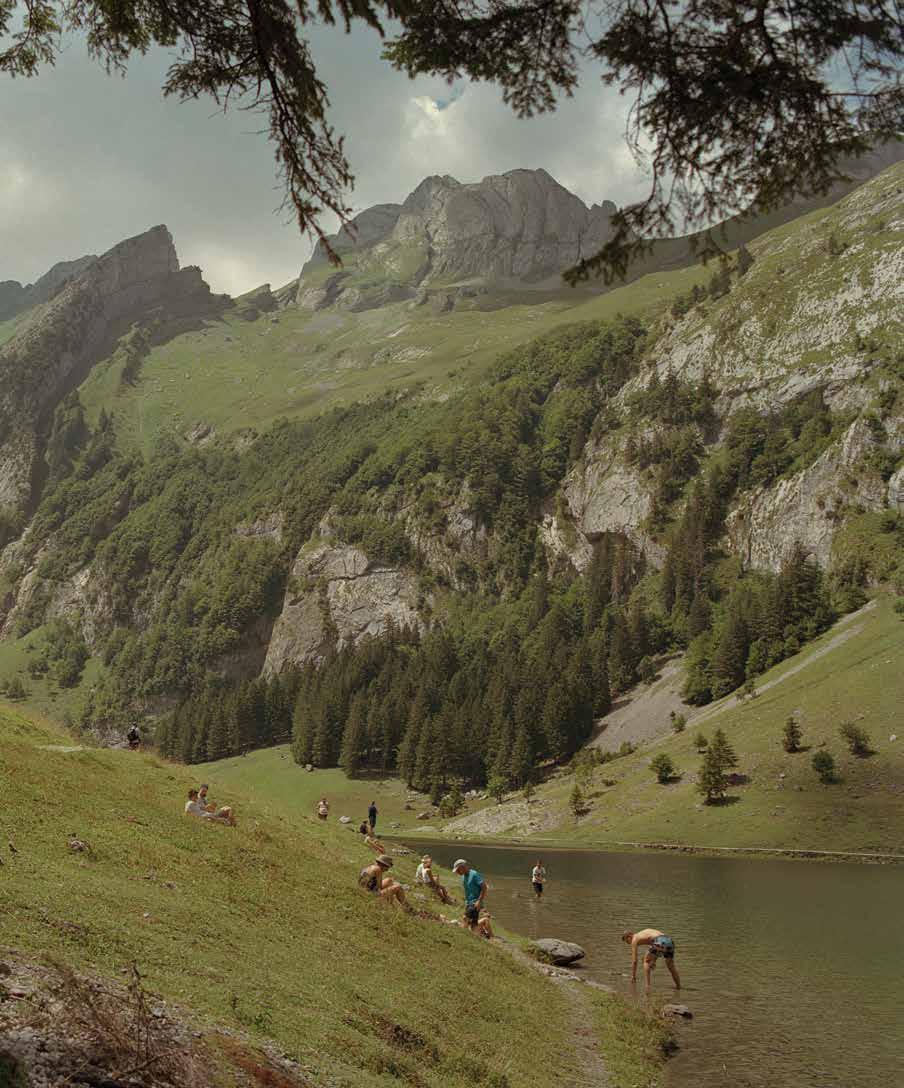
A family finds whimsy and wonder in seven days spent in the splendor of Switzerland’s central region.
スイス中央部の壮麗な景色の中で過ごした7日間。ハワイのファミリーが出会 った新鮮な驚きをご紹介します。
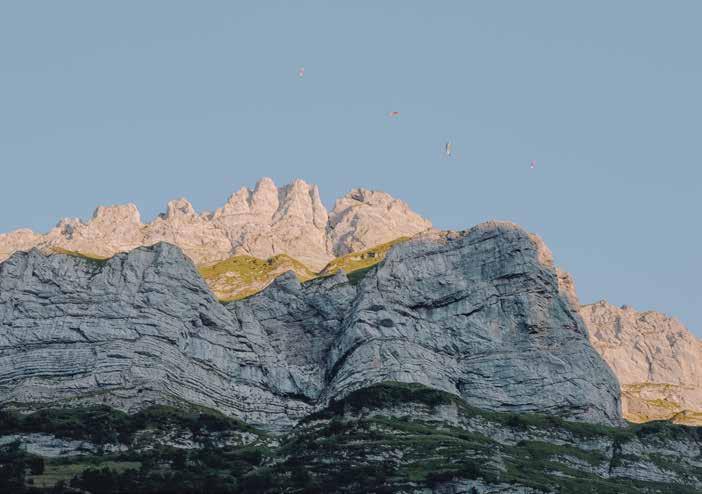
Once upon a time, my husband, daughter, and I took a European vacation. Our home base for our week in Switzerland was the lakeside city of Lucerne, which is considered to be the gateway to the country’s central region. An elevated way of living seemed to sustain Switzerland—the water was pristine, the cheese divine, and there was a chandelier in the local McDonald’s.
ある年のこと、夫と娘、そしてわたしはヨーロッパを旅しました。一週間のスイ ス滞在中に拠点としたのは湖のほとりの町、ルツェルン。スイス中央部への玄 関口として知られる町です。水は清らかで、チーズはとてつもなく美味。マクド ナルドの天井にもシャンデリアがありました。スイスには、そんな質の高い生 活が保たれているようです。
PALM
118 E EXPLORE Switzerland
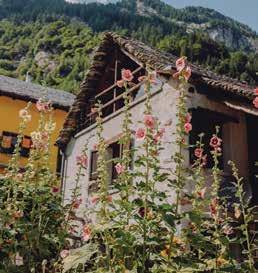
스위스에 있는 한 지역 가족의 유랑자들은
그들을 아펜젤, 라베르테초, 그리고
세인트로 떠돌아다닙니다. Gotthard Pass
입니다. 외딴 마을과 호수를 통한 그들의
휴가는 인상주의 그림에 발을 들여놓는
것과 같습니다.
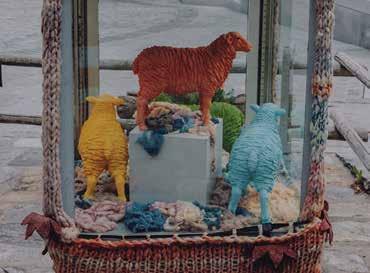
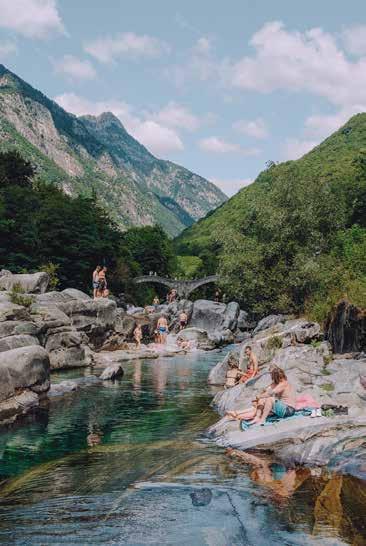 Scenes from Lucerne, Switzerland.
Scenes from Lucerne, Switzerland.
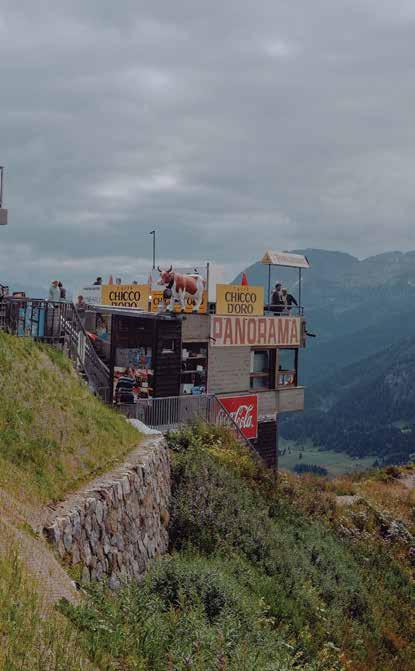
We went to Lucerne because of my husband’s close-knit circle of creative friends, all of whom enjoy traveling, camping, and working on photography projects together. Our families planned this trip for two years, spearheaded by my husband’s best friend, who had moved to Lucerne after getting married.
We arrived in midsummer and began our exploration on a hot day winding through bustling streets fronting a farmers market where vendors sold artisanal foods, a multitude of flowers, and crafts alongside a lazy river. On a trip to Meggen, a city in the canton of Lucerne, we found that castles and old, stone buildings are common sights. If not for modern conveniences like electricity and cellphones, it would have been easy to imagine in certain areas that we had been transported back a few hundred years.
ルツェルンを訪れたのは、結束の固い夫の仲間たちの影響でした。クリエイ ティブな人々が集まるこのグループは、旅行やキャンプ、写真撮影のプロジェク トなどを一緒に手がけています。この家族旅行は、夫の親友が結婚してルツェ ルンに移住した2年前から計画を温めてきたのです。
真夏に到着したわたしたちのスイス探検は、ゆったりと流れる川沿いの賑や かなファーマーズマーケットを歩くことからはじまりました。マーケットには職 人が作った食料品と、さまざまな種類の花や工芸品などが並んでいます。ルツ ェルン州の街メッゲンでは、城や石造りの古い建物があたりまえのようにそこ かしこにありました。電気や携帯電話など現代的な文明の利器がなかったら、 数百年前の時代にタイムスリップしたような錯覚に陥ってしまいそうです。
スイスはどこも全体的にそういった感じで、農業、現代的なデザイン、古い建 物が違和感なく調和しています。わたしたちは4つの州を訪れましたが、どこ に行っても自然とテクノロジーが絶妙なバランスで共存しているのです。岩や 崖を壁の一部に使っている家々など、見事に環境に溶け込んだ古い家々にも ソーラーパネルが設置されています。リサイクルが幅広く行われ、ゴミはどこに も見当たりません。国中で複数の言語が使われているので、一日のうちにスイ スドイツ語、フランス語、イタリア語を耳にするのもごく普通のことです。
PALM
EXPLORE Switzerland 120 E
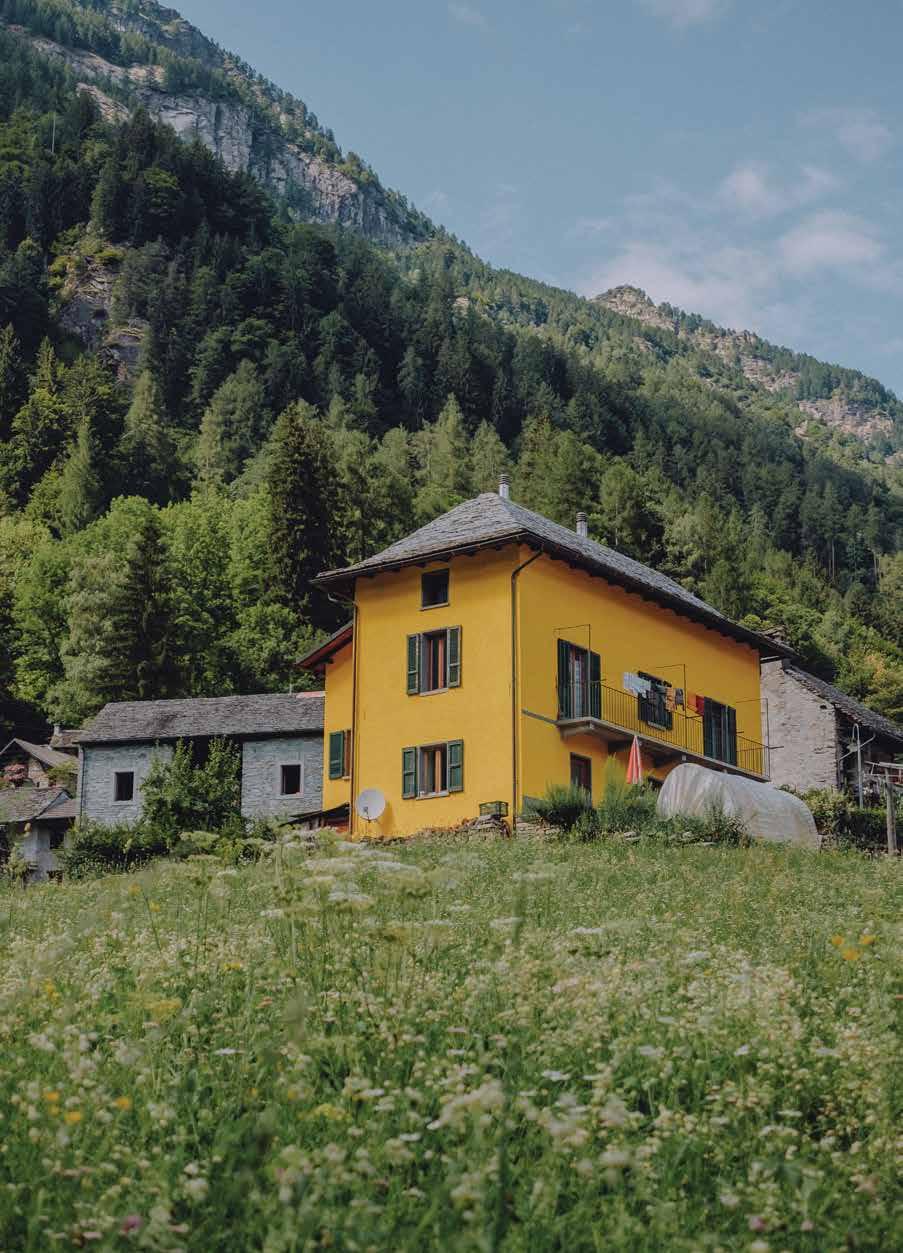
The same can be said for much of Switzerland. Agriculture, modern design, and old architecture seamlessly blend together. We visited four cantons, and all met a gold standard for balancing nature with technology. There were solar panels on old homes and houses that were embedded in the environment, like one that used the cliffside as a wall. There was recycling everywhere and no trash to be seen. It wasn’t uncommon to hear Swiss German, French, and Italian in the same day, since multiple languages are spoken across the country.
Each day we headed to a new destination. On a stop along the winding road of Gotthard Pass, we listened to three men playing alphorns for racing cyclists. We swam in the ice-cold, crystal-blue waters of Verzasca river in the town of Lavertezzo. We attended the Blue Balls music festival (yes, it’s actually called that, and no, they have no idea). We felt the spray from waterfalls in Lauterbrunnen and found a moment of peace in Locarno followed by divine pizza and sinful gelato.
わたしたちは毎日、新しい場所を訪れました。ゴッタルド峠の曲 がりくねった道の途中では、自転車レーサーのために3人の奏者が アルプホルンを吹いていました。ブルー・ボールズ音楽祭(そう、本 当にこういう名前なのです。英語のスラングに別の意味があるとは、 ここの人は誰も露ほども知らないようです)[訳注:blueballsには「 性的に興奮しながら欲求を満たせなかった男性が味わう強い不快 感」の意味がある]にも参加し、ラヴェルテッツォ村のヴェルザスカ 渓谷では氷のように冷たいクリスタルブルーの水で泳ぎました。ロ ーテルブルネンでは滝の水しぶきを浴び、ロカルノでは極上のピザ と罪深いほど美味なジェラートで幸せに浸りました。
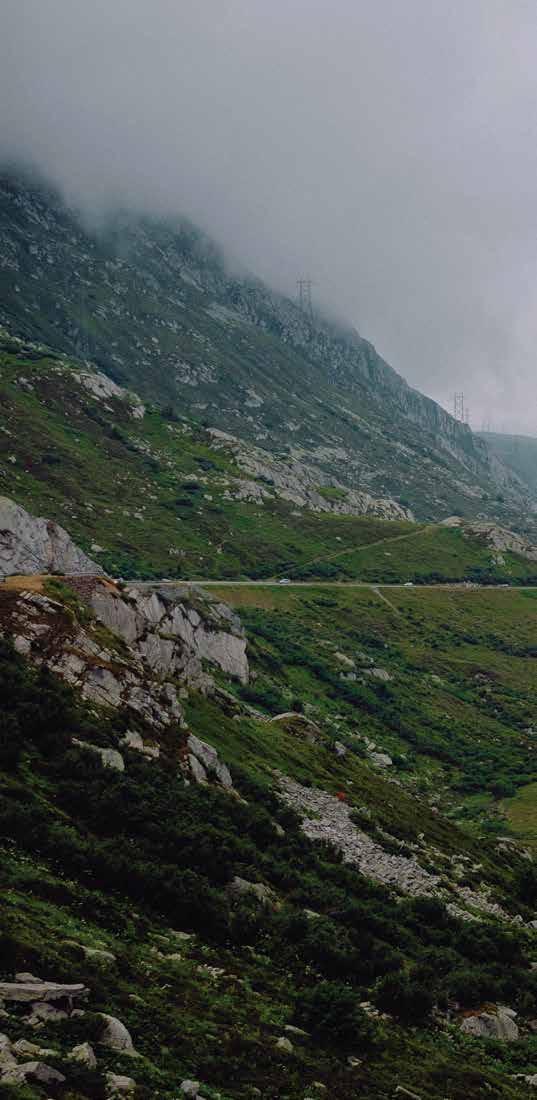
PALM
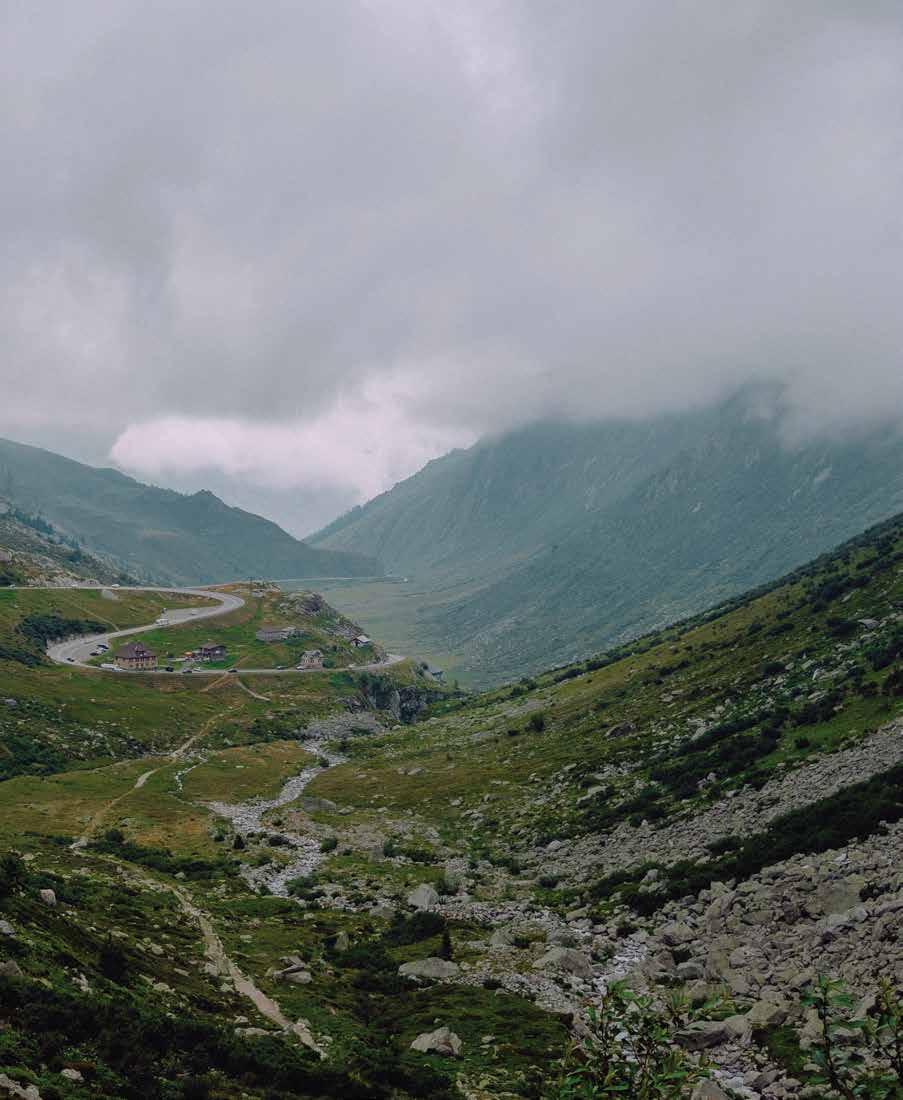
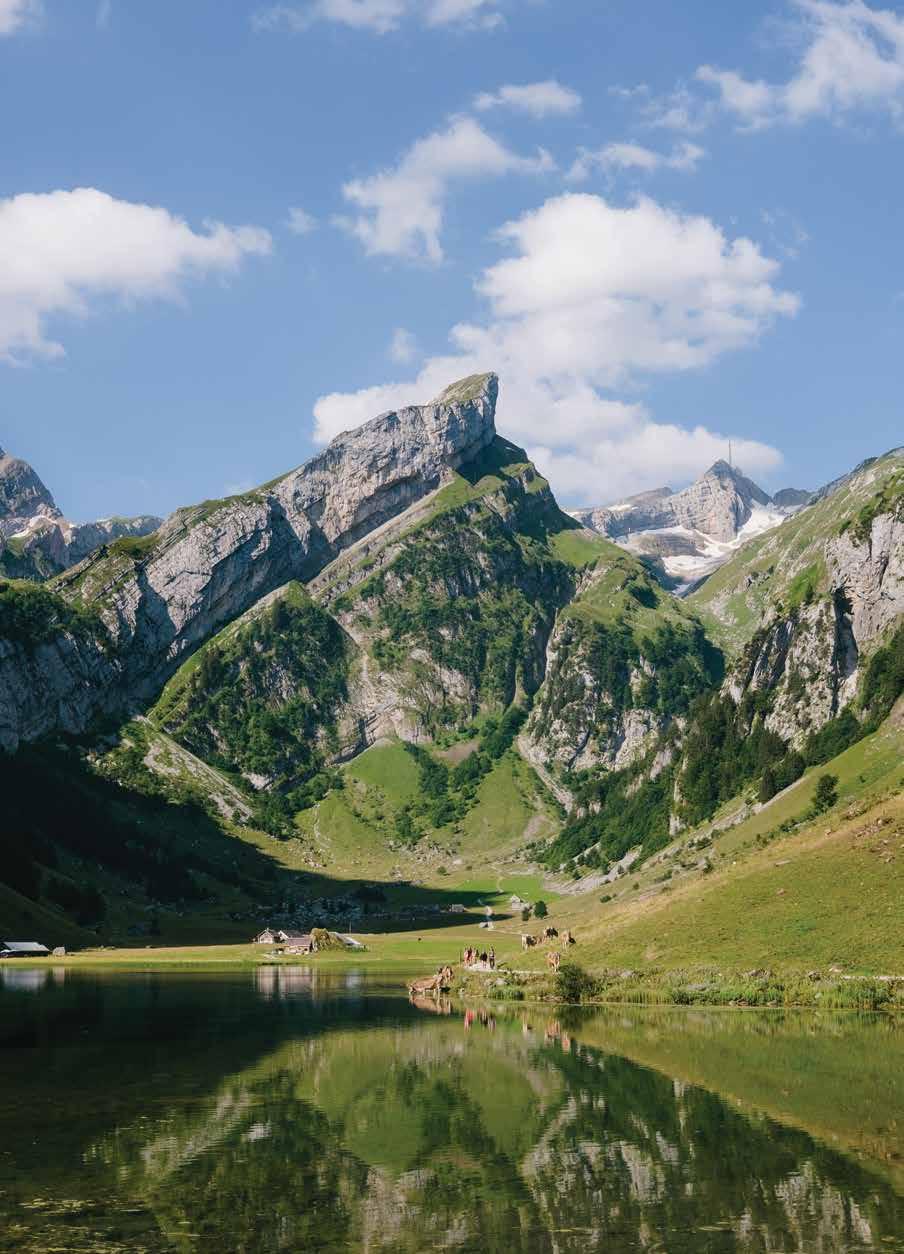
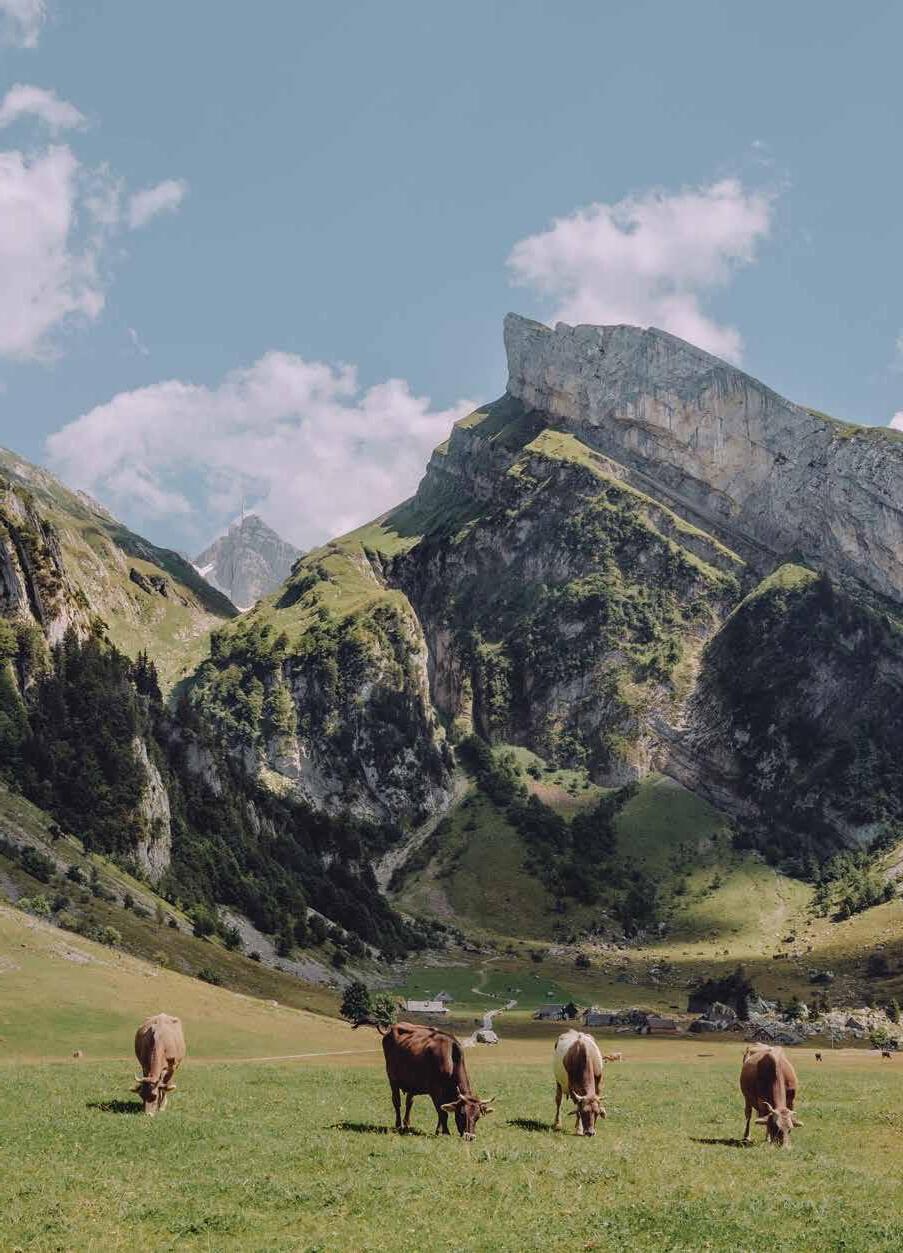
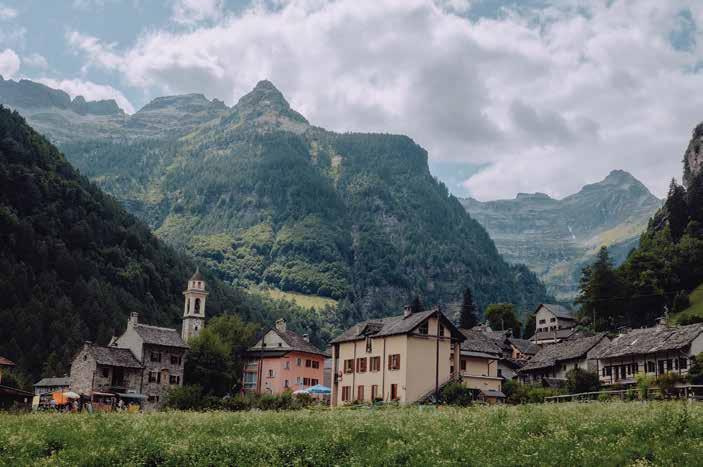
The small town of Sonogno and the mountainscape of the Swiss country.
But the time we spent at Seealpsee lake stood apart. A gondola took us to the top of the mountain summit Ebenalp, and as we hiked down, we watched paragliders while listening to cowbells as cattle grazed the rolling plains. We decided to bypass the large crowd and instead enjoyed a packed lunch nearby with our own private view. In the early evening, we rowed a boat across the lake while sharing a couple glasses of wine. At the moment the sun set, we experienced a traditional Alpine chant performed by a herdsman asking the saints to bless and protect all the plants and animals in the Alps. A friend turned to me, and I felt it before she said it—this was the Swiss equivalent to mana, the Hawaiian concept of spiritual energy. There was a stillness in the valley as it echoed off the hills.
そんな中でも別格だったのは、ゼーブリ湖で過 ごした時間です。ゴンドラでエブナルプの山頂まで 行き、ふもとまでハイキングしたわたしたちは、ゆる やかな丘陵で草を食む牛たちのカウベルの音を聞 きながら、パラグライダーを眺めました。人混みを 離れた場所で絶景を独占しながら、お弁当を食べ ることにしたのです。夕方は湖でボートを漕ぎなが ら、ワインを楽しみました。そしてまさに夕陽が沈 もうとするその時、牧夫たちの伝統的な詠唱(チャ ント)を耳にしました。アルプスの草木や動物たち を守ってくれるように、聖人たちの加護を求めるチ ャントです。わたしの方を振り向いた友人が言おう としていることが、彼女が口を開く前からわかりま した。これはスイスの「マナ」だ、ということ。ハワイ でスピリチュアルなエネルギーをさす「マナ」と同じ ものが、ここにもあったのです。チャントがこだます る谷間は、静けさに包まれていました。
PALM
126 E EXPLORE Switzerland


















































Pasta-tively the Best Italian Experience in the Pacific Hawai‘i's on l y It alian festival 09 . 28 .1 9 | kaka‘ako , o‘ahu @festaitaliana | #cialoha | @festaitalianahawaii www. festaitalianahawaii .com Wher e Ciao Meets Aloha
Heart of Hula
Text and images by Dino Morrow
文/写真 = ディノ・モロー
PALM 128 E EXPLORE Hilo
フラの魂
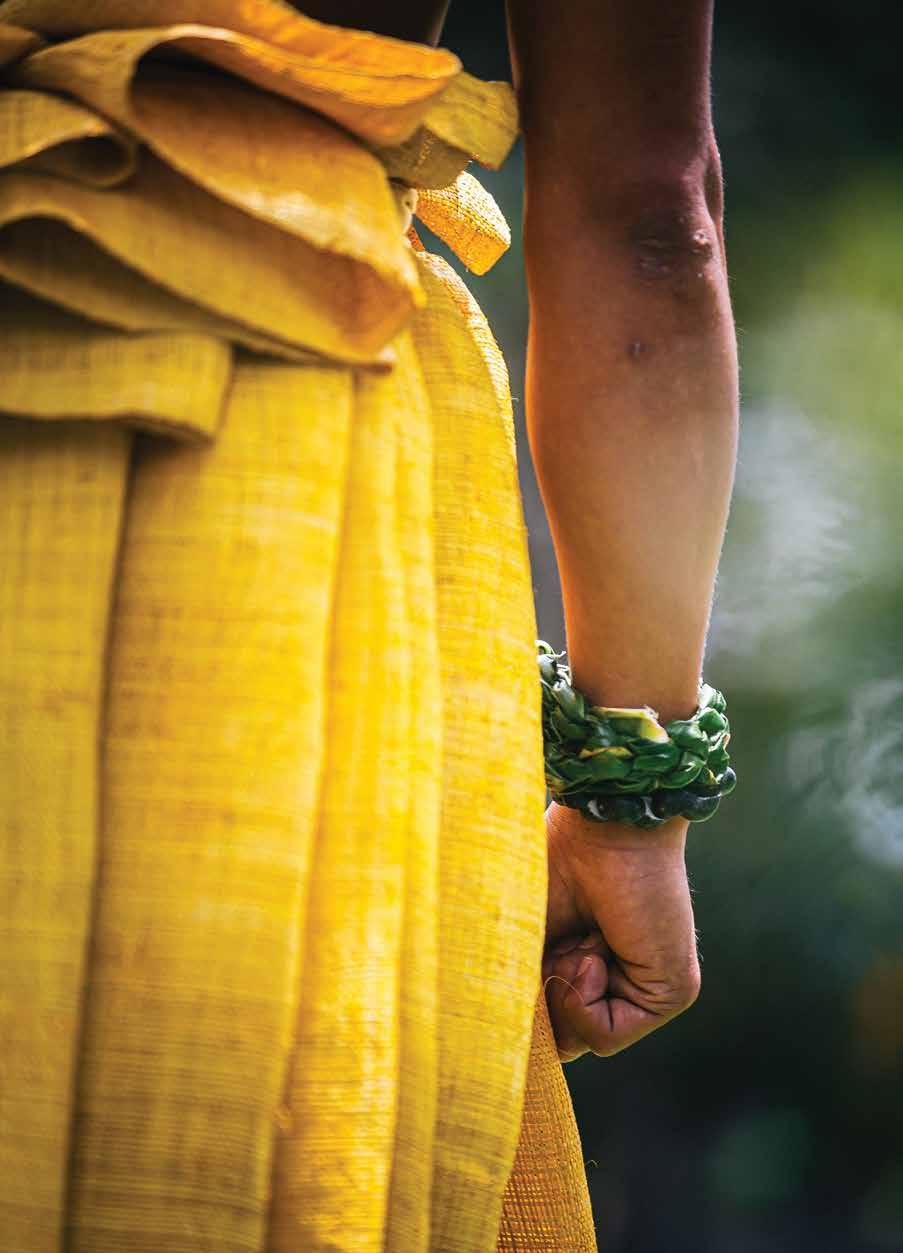
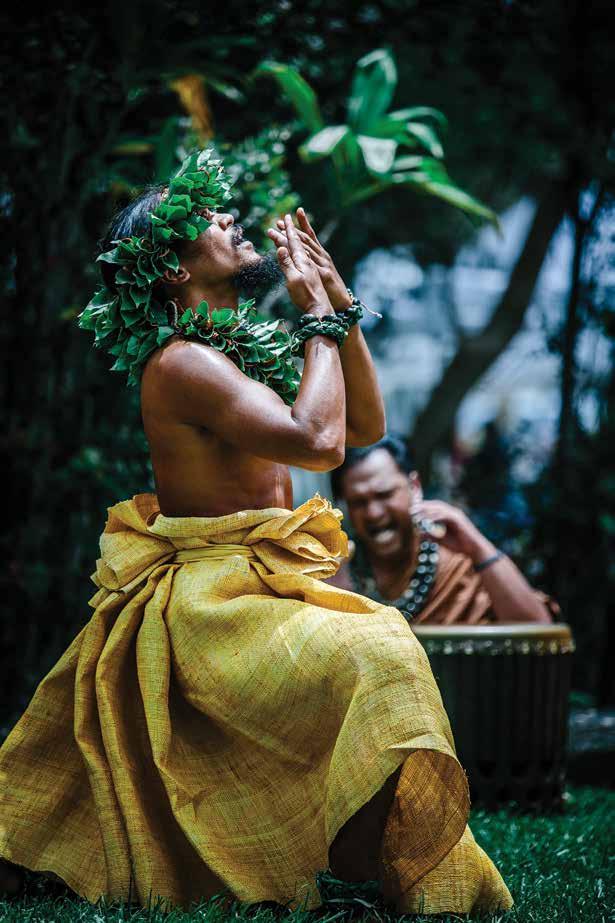
The essence of hula culture on Hawai‘i Island begins with the kumu of the dance.
フラ文化のエッセンスは、 心を震わせるフラの魂を体現する教師、 クムたちです。
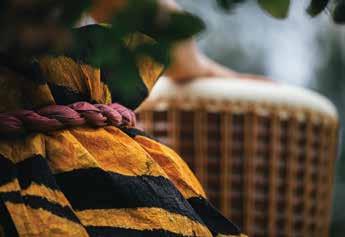
One of the first things that sets apart the visitor experience in Hawai‘i is language. Even before stepping off a plane onto the islands, most travelers know at least a couple Hawaiian words, like aloha and mahalo. The word kumu, meaning “teacher,” may not be one of them, but I believe it should be.
I am grateful and humbled by the kumu, the teachers, I meet through documenting hula as a photographer. While many of my kumu are terrestrial—they have frequent flyer numbers, voice their opinions on most things, and are a wealth of historical and highly specific, skilled knowledge—one of my most important kumu isn’t a person, but the art form of hula itself.
For most people, learning from hula means mastering oli (chants), practicing movements that require the raising of heels or bending of knees, and gathering tī leaf to make hula skirts by hand. However, my kumu came to me another way: through a camera. To me, the ultimate value of an image is that participants feels its perspective and composition are honorable and authentic. My aim is to capture the mana each and every location and dancer stirs within me, to share what my kumu has shown me.
訪れる人にとって、ハワイが他の場所とは違うこと を強く印象づける最初のものは、その言葉だろう。 ハワイ行きの飛行機に乗りこむ前から、たいていの 人はいくつかのハワイ語を知っている。「アロハ」や 「マハロ」といった単語は有名だ。でも「教師」を 意味する「クム」は、それほど知られていない。この 言葉こそもっと広まるべきだと私は思うのだ。 フラを通して出逢ったクムたちのことを思うといつ も心からの感謝を感じ、謙虚な気持ちにさせられ る。クムたちの多くは、航空会社のマイレージ番 号を持ち、多くの物事に意見を表明し、歴史に詳し く、高度に専門的な知識を豊かに備える人物だ。 でも、私の最も大切なクムは人ではなく、フラとい う芸術そのものなのだ。
多くの人びとにとってフラを習うというのは、 オリ(チャント)を覚え、かかとを上げて膝を曲げた 姿勢を保って踊る動きを練習し、ティ・リーフを集め てきてスカートを手作りする、といったことを意味 する。でも私のクムは別の形で、つまりカメラを通 して、私に語りかけてくれた。私にとって写真の究 極の価値とは、その視点と構図が正しいものであ り真実性があると見た人が感じとってくれること。 私の目標は、この土地の持つ「マナ(力)」とそれぞ れのダンサーが放つエネルギーを捉えること。私 の心を動かすそれらを、つまり私の「クム」の姿を、 皆と共有したいのだ。
“Hula is the language of the heart and therefore the heartbeat of the Hawaiian people.”
— King David La‘amea Kalākaua
섬에서
힐로에
둔 사진작가가 그들에게서
교훈을 공유합니다.
훌라는 하와이 문화의 심장박동이고 하와이
깊게 울려 퍼집니다. 훌라 할라우의
기반을
배운
130 E EXPLORE Hilo
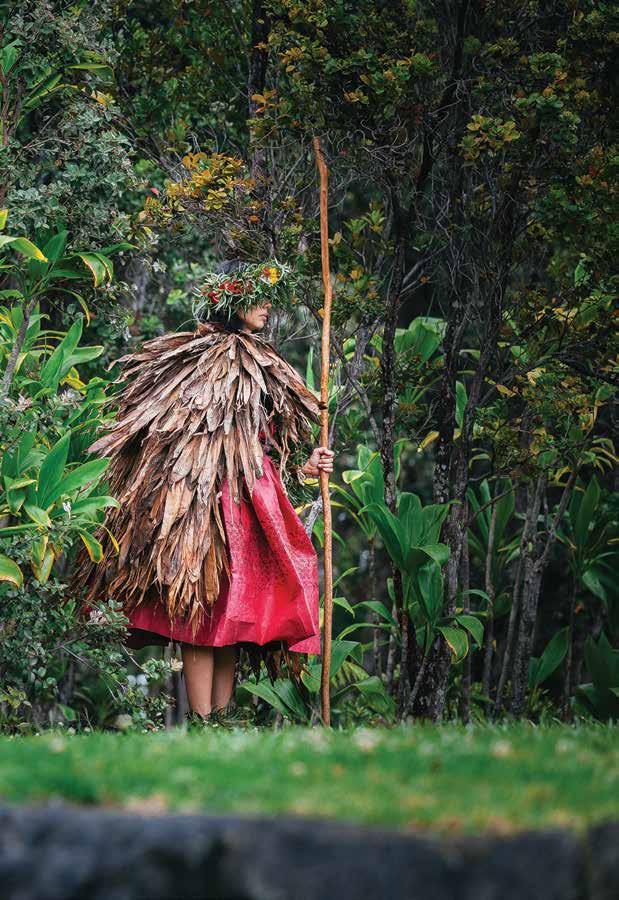 Hula is full of mana, or spiritual power.
Hula is full of mana, or spiritual power.
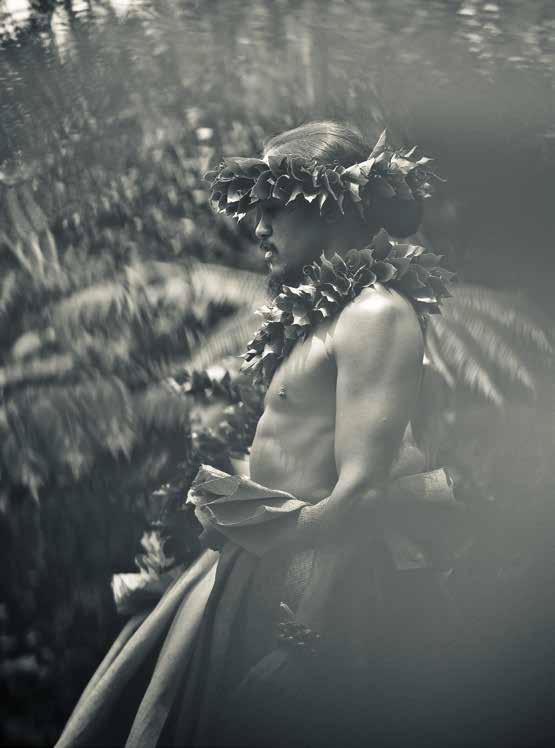
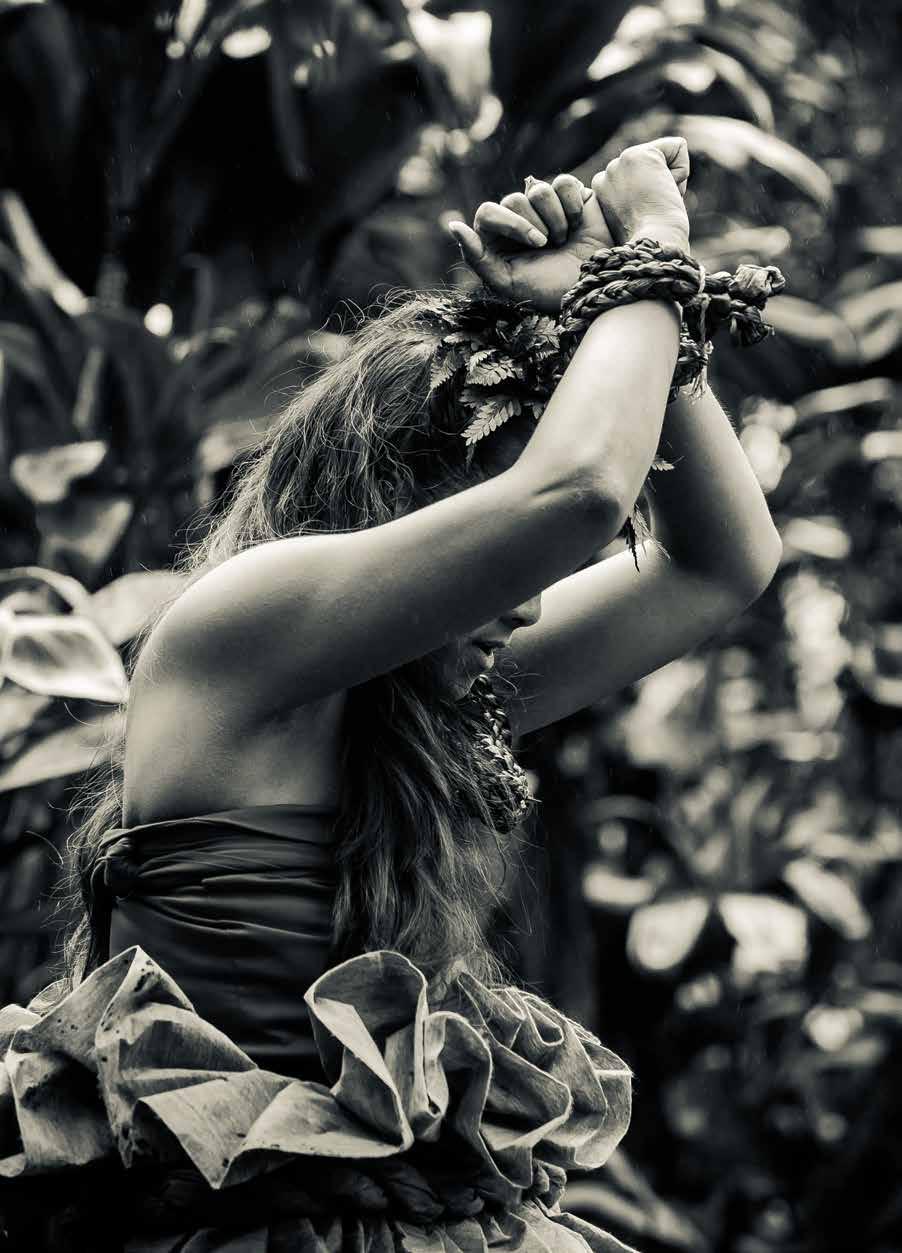
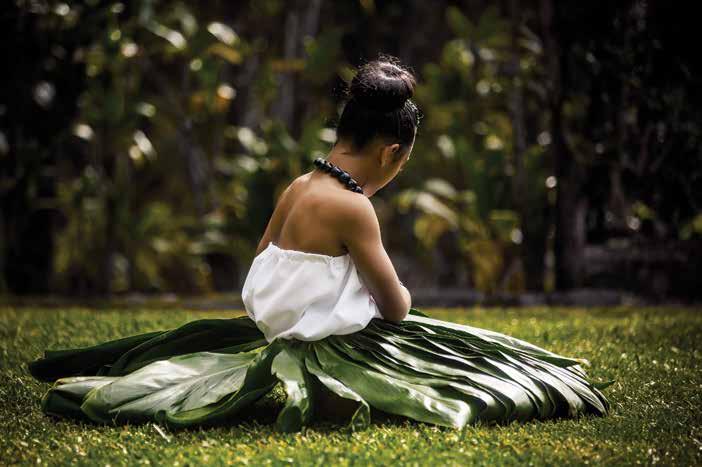
My kumu is hula, and her classroom is the island of Hawai‘i.
From Pele’s home in Halema‘uma‘u atop Kīlauea to a Merrie Monarch hula about Hualālai in Kailua-Kona to keiki dancing about Kalapana, the lessons of hula and the connection to Hawai‘i Island are ever-present. Everywhere you go on this island, there is an ancient history, a powerful story of the Hawaiian gods and their people. I have also learned that when I approach a sacred space, I should announce my presence, ask for permission to enter, and ask for forgiveness for anything negative I might bring or do.
私のクムはフラそのものであり、その教室は ハワイ島だ。女神ペレの住まう家であるキラウェ ア山のハレマウマウ火口から、カイルア・コナのフア ラライ山の周辺で練習するメリー・モナーク・フェ スティバル出場のフラダンサーたち、カラパナ近く のケイキ(キッズ)・ダンサーにいたるまで、フラのレ ッスンとハワイ島は深く結びついている。また、私 は、聖なる場所に近づくときには、自分の存在を告 げ、侵入する許しを請い、自分がその場に持ち込ん でしまったかもしれない悪しきもの、または自分が してしまったかもしれない良くない行為について許 しを請うべきであるということも学んだ。 フォトグラファーとしても個人的な生活の上 でも、私は「インサイダー」と「アウトサイダー」の両 方であり続け、そのことについて考え続けてきた。 私はハワイという土地のアイデンティと個性を写
PALM
134 E EXPLORE Hilo
A young hula dancer in a tī leaf skirt.
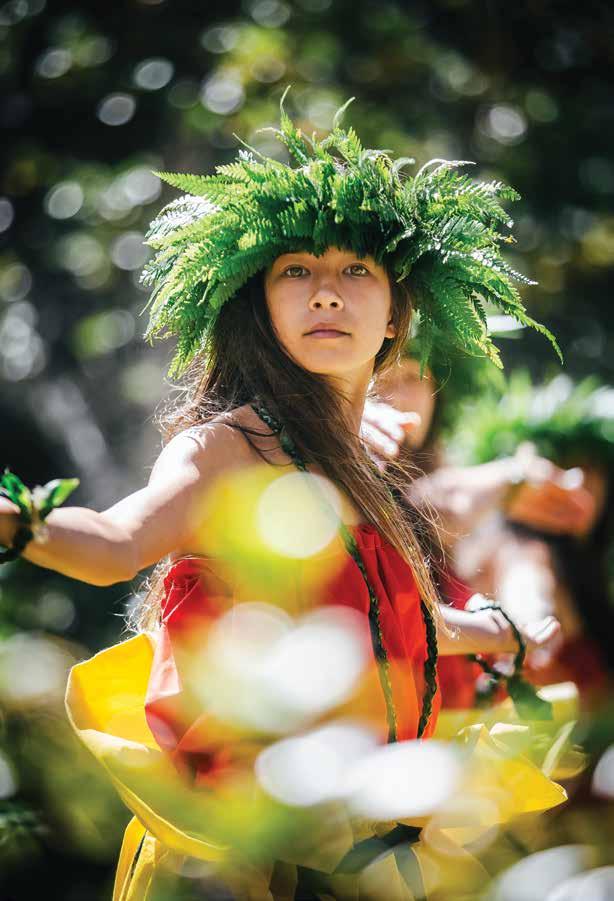 Every year hula hālau converge for the Merrie Monarch Festival.
Every year hula hālau converge for the Merrie Monarch Festival.
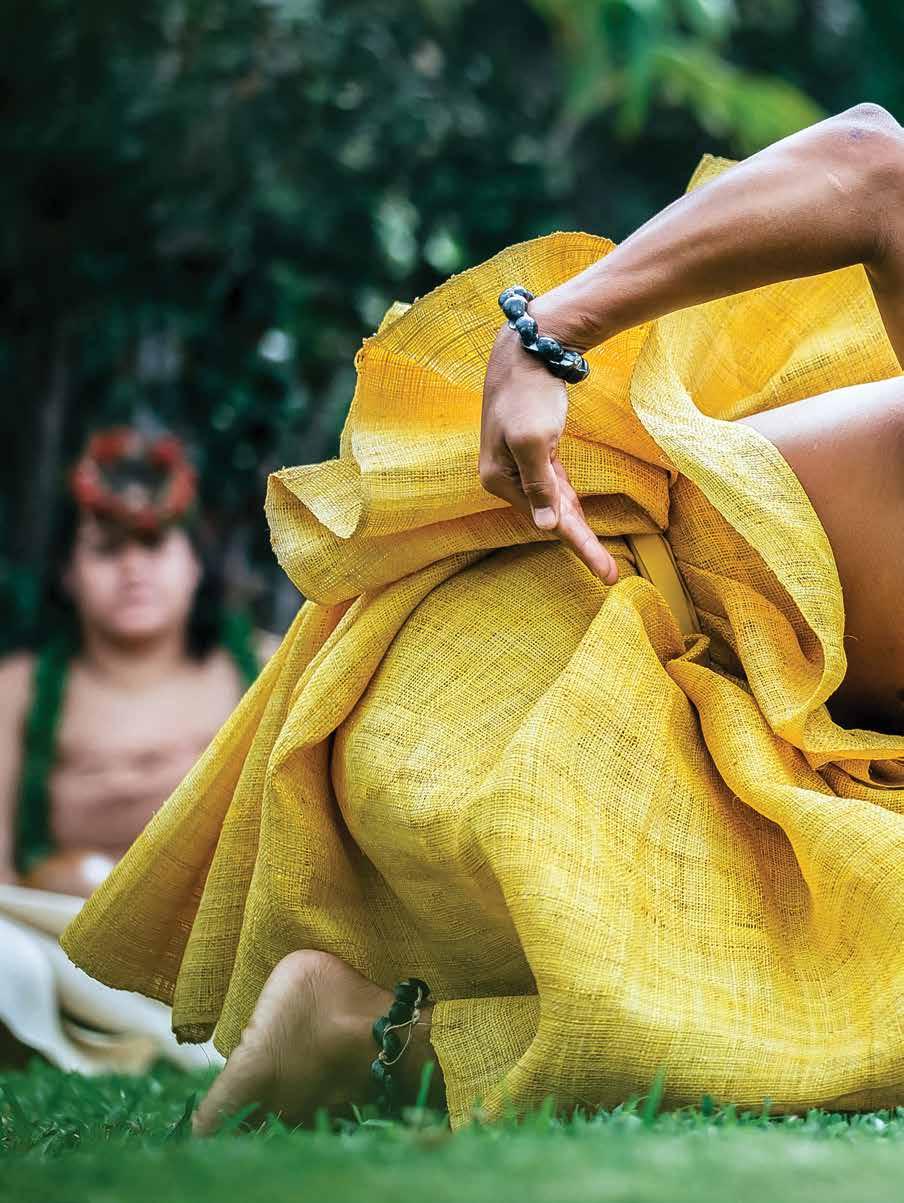
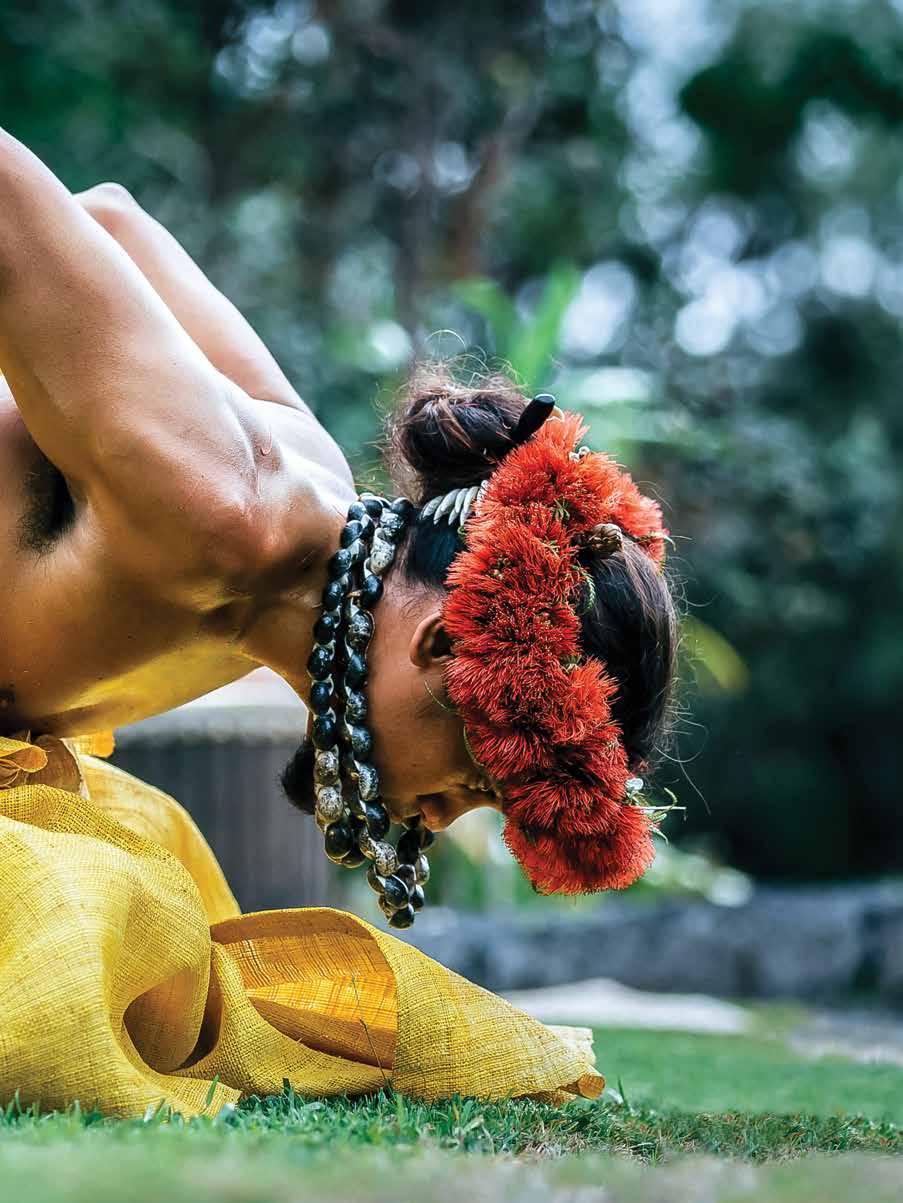
My experience as a photographer, and in life, has been a study in working as an insider and an outsider: I document identity and sense of place in Hawai‘i, but I am not Hawaiian. I capture sacred moments, families dancing together the same steps their ancestors have for hundreds of years, but this is not the tradition in which I was raised. My son’s first food was poi, but I was raised on Wonder Bread. In my role as insider and outsider, I have learned that for many people, hula is not a hobby but a lifestyle. Some dancers even say hula is life. Their dedication, discipline, attention to detail, and devotion can rival that of any professional athlete or broker on Wall Street. The person who just checked you in for your car rental, the executive director you met for drinks, the single mom in the lifted pickup truck, the friendly grocery store cashier, all may very well be accomplished hula dancers.
I have seen the hours, days, and months of preparation add up to those fleeting few minutes of graceful movement. I have learned that a kumu hula saying “almost ready” can mean the hālau continues to practice from the top over and over and over. I’ve seen how kumu teach dancers to develop muscles, moves, and mana to become their best selves.
From my kumu, I have learned that hula is more than just an expression of a story or prayer. In hula, the body, mind, and spirit are developed to act as one. Many of the traditions passed down through generations emphasize this unity. Without the Hawaiian language, there would be no hula. Without the stories of kūpuna, there would be no shared values, protocol, or responsibility. I have learned that living traditions— interactions between people, land, and practices—are not static. History is fluid. There are volumes I don’t yet know, and dimensions of hula that I never will. From my kumu, I have learned to be open to learning, because hula always has something to teach.
真で記録しているが、自分自身はハワイアンではない。何百年もの間祖先から 受け継がれてきたステップを家族が一緒に踊る、聖なる瞬間をカメラに捉える が、その伝統の中で育ってきたわけではない。私の息子の最初の食べものは ポイだったが、私自身は「ワンダーブレッド」を食べて育った。インサイダーとア ウトサイダーの両方として生きる中で、私は、フラは多くの人びとにとって単な る趣味ではなくライフスタイルだということを知った。ダンサーの中にはフラこ そ自分の人生だという人もいる。彼らの専心、修練、細部への気配り、献身は、 どんなプロ運動選手にも、またはウォール街の精力的な証券ブローカーにも 匹敵する。そうしたダンサーたちは、もしかすると、レンタカーのカウンターで あなたの車を手配してくれた係員かもしれないし、一緒にお酒を飲む約束をし ている企業重役かもしれない。または、ピックアップトラックに乗ったシングル マザーかもしれないし、スーパーの親切なレジ係かもしれない。そういった人 たちの中に、熟練したフラダンサーがいるのだ。
何か月にもわたって重ねた練習の成果が、ほんの数分間の優雅な動きに 結実していくのを、私は見てきた。クムフラが「もう一息で完成だ」と言った後 も、ハラウのダンサーたちは引き続き何度も何度も最初からその曲を練習する ことになる。ダンサーたちが最善を発揮するために、筋力、動き、マナを修錬す る方法をクムたちがどのように指導しているのかも私は見てきた。
私のクムは、フラが物語や祈りの表現以上のものであることを教えてくれ たのだ。フラでは、身体と心、精神がひとつになって働きはじめる。多くの伝統 が、世代を超えてこの統一性を伝えている。ハワイアンの言語がなければ、フ ラも存在しなかったに違いない。クプナの語る物語がなければ、人びとが守る 価値観も、そのための方法も、責任も存在し得なかった。私は、生きた伝統に ついて学んできた。人びとと土地と伝統の間に働く相互の力は、じっとした静 的なものではない。歴史は流れるように動き続けるものだ。そこには私がまだ 知らない歴史があり、私が決して学ぶことのないフラの深みがあることだろう。
私のクムを通して、私は学びに心を開くことを学んだ。フラには常に、何かしら 新しい教えがあるからだ。
PALM
138 E EXPLORE Hilo
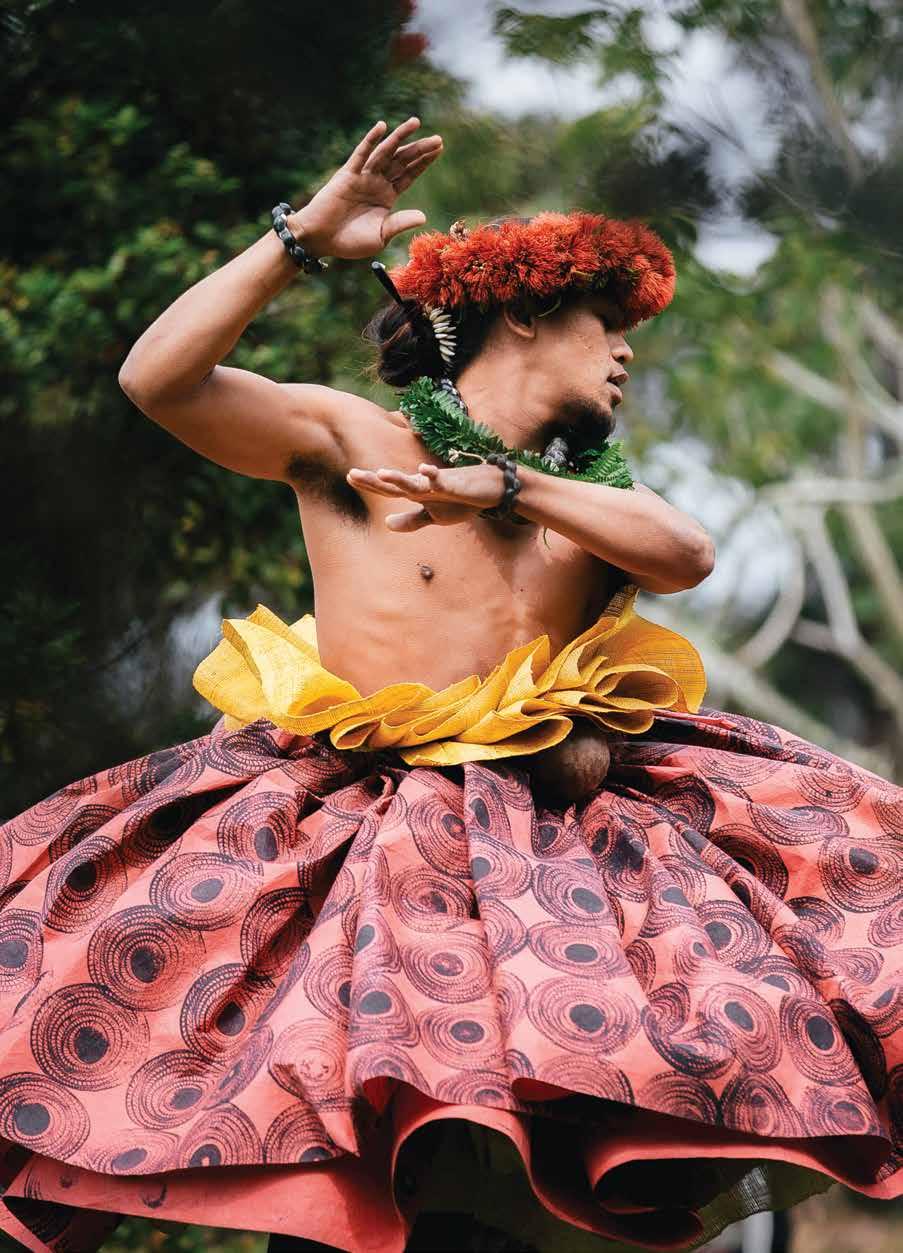
Culinary delights and
FA RE
PALM F 食
delectable hidden gems
F
PALM PALM
141
Ensemble Performance
アンサンブルの音色
A historic structure in Waikīkī, one that has seen many changes over the past century, cuts a handsome new profile as Zigu and Paris Hawaii, two restaurants with much to offer beyond global cuisine.
ワイキキのレストラン、ジグとパリ・ハワイは、 グローバルな料理にとどまらない魅力を放 っています。
음식, 건축, 패밀리가 뒤섞인 공간을 입 력합니다. 가족 소유의 이 건물의 부활
은 와이키키에 대한 인간의 관심의 한
文 = ティモシー・Aシューラー
Text by Timothy A. Schuler Images by Chris Rohrer 写真 = ジョン・フック、クリス・ローラー
측면으로 매혹적인 경험을 하게 합니다.
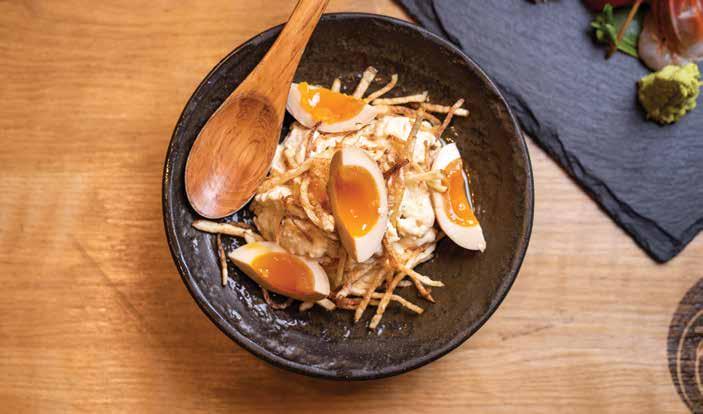
The late-afternoon sun warmed the wooden bar and made lanterns out of the whiskey bottles that lined its edge. Outside, Waikīkī was winding down. Or winding up. It was hard to say. The sidewalk was a ballet: Deliverymen dodged unwitting tourists while light-footed joggers pirouetted around them. In the kitchen behind the bar, cooks clad in tattoos and denim aprons prepped the evening’s dishes: fresh, local sashimi and cold kale udon with bitter okra and natto.
夕方の陽の光が木造のバーを温かく照らし、ずらりと並ぶウイスキーのボト ルがランタンのように輝く。ワイキキの街がくつろぎ始めている。いや、むし ろ熱気を増しつつあるのかもしれない、そんな微妙な時間。歩道では、周り に気を配らずに歩く観光客を配達人たちがひらりと避けたかと思えば、ジョ ガーたちがそんな彼らのまわりを足取り軽くピルエットのように優雅に回 り込み、まるでバレエを見ているかのようだ。バーの奥にあるキッチンでは、 タトゥーにデニムのエプロンといういでたちの料理人たちがディナーの仕
FARE Zigu 142 F
PALM
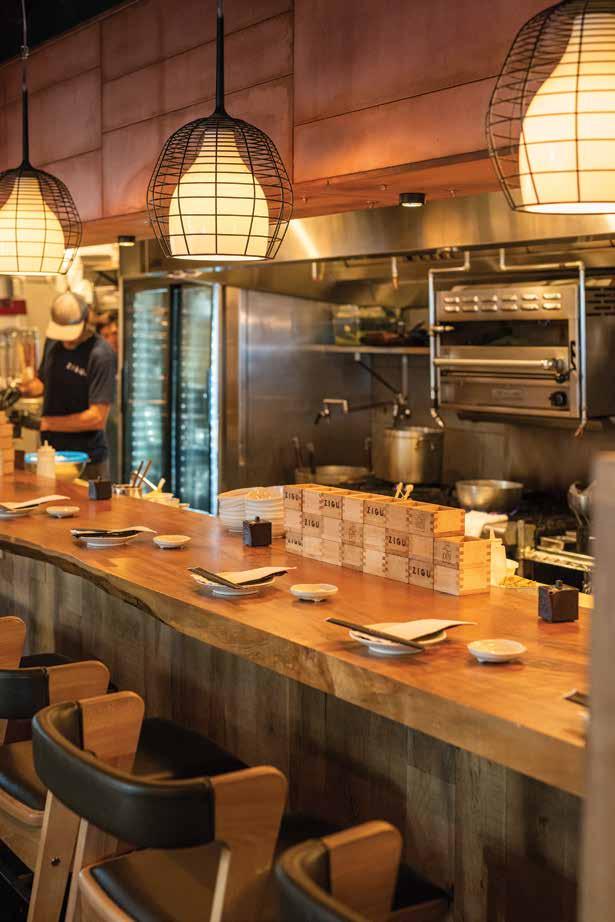
I’m at Zigu, a Japanese izakaya that feels deep in a love affair with Hawai‘i. Located on Seaside Avenue in Waikīkī, the menu features an abundance of locally sourced fish, pork, yuzu, and other produce, much of it assembled in surprising ways. The restaurant opened in 2018 alongside its more buttoned-up sibling, Paris Hawaii, an island-inspired French concept by chef Yuya Yamanaka, located just upstairs.
Both restaurants are owned by Japanese restaurant group Zetton, which has been honing its brand of local culinary style since 2009, when it opened Aloha Table, a casual eatery a few blocks away that serves everything from corn dogs to oxtail soup in a contemporary Hawaiiana setting. Zetton’s lineup of restaurants includes Goofy Cafe and Dine, Heavenly, and now Zigu and Paris Hawaii, all of which have laidback vibes and farm-totable menus, though some of the creations can feel odd, as if something has been lost in translation—Hawai‘i reflected in a disco ball. For instance, Goofy, whose name seems to be a reference to the right-foot-forward surf stance, appears unable to decide if it’s a casual breakfast spot, a coffee shop, or a breezy upstairs dive.
But time and repetition have worked their refining magic. Aesthetically, Zigu and Paris Hawaii are Zetton’s most restrained concepts, with minimalist material palettes of unfinished wood, raw concrete, and ebony steel. Paris Hawaii has pitch-black curtains, raw concrete, and custom details like a herringbone wood floor. Its interior design is as refined as the luxurious dishes of Yamanaka’s ever-evolving, seven-course, prix fixe menu (think ‘ahi poke topped with beef tartare and coconut). Zigu is equally concerned with ambiance, its restrained furnishings complementing the spartan space.
Much of both restaurants’ appeal comes from the building itself, 413 Seaside Avenue, a two-story walk-up constructed in the late 1930s that has withstood Waikīkī’s evolution from a quiet destination with a smattering of hotels to a dense, urban neighborhood. Listed on the National Register of Historic Places, the building was designed by Bjarne Dahl and Connie Conrad, a pair of California transplants who were in high demand at the time, and it is a perfect example of Hawai‘i’s architectural fusion: vaguely Mediterranean, slightly Chinese, 100-percent tropical. The scalloped wall that surrounds the lānai is incised by a circular moon gate, borrowed from Chinese architecture, while modern lines and Art Deco motifs reveal European influence. Despite this hodgepodge, the design still manages to feel subtle, exuding a stylish simplicity.
込みをしている。今夜のメニューはたとえば、地元産の魚の新鮮な刺身や、ケー ルを練り込んだ冷製うどんに苦みのあるオクラと納豆を添えた一皿など。 私が座っているのは、「ジグ」。ハワイへの強い思い入れを感じさせる日本 式居酒屋だ。ワイキキのシーサイド・アベニューにあるジグのメニューは、地元産 の魚、豚肉、柚子といった食材をふんだんに使い、その多くを驚くようなアレンジ で提供している。ジグがオープンしたのは2018年。その2階の店はやはり同年 に開店したジグよりもフォーマルな姉妹店「パリ・ハワイ」で、こちらでは山中祐哉 シェフによる、ハワイにインスピレーションを受けたフレンチを楽しめる。
どちらのレストランも、日本のレストラングループ「ゼットン」の経営だ。ゼッ トンはここから数ブロック離れた場所に、現代的にアレンジしたハワイ風のイン テリアでアメリカンドッグからオックステールスープまで幅広い料理を出すカジュ アルなレストラン「アロハ・テーブル」を2009年に開いて以来、ハワイらしい食事 処としてブランド力を固めてきた。「グーフィー・カフェ&ダイン」「ヘブンリー」そ してジグとパリ・ハワイ。ゼットンが展開するレストランは、どこもくつろげる雰囲 気があり、地産地消のメニューをそろえている。ただ、そこで出される創作料理 の中にはアレンジの過程で何かが失われたかのように、違和感を覚えるものもあ る。ミラーボールに映し出されたハワイとでも言ったらいいだろうか。たとえば、 右足を前に置くサーフィンのスタンスを表す「グーフィー」にちなんで名付けられ たらしいグーフィー・カフェ&ダインは、カジュアルな朝食スポットなのか、コーヒ ーショップなのか、それともバーなのか、方向性を決めかねているように見える。 しかし、時間と経験を味方に、ゼットンは洗練の術を身につけたようだ。未 塗装の木材、打放しのコンクリート、光沢のある黒いスチールだけに素材を絞っ たジグとパリ・ハワイの内装は、これまでのゼットンの店舗デザインの中で最も抑 えたものになっている。パリ・ハワイのインテリアは、漆黒のカーテンと打放しの コンクリートという背景にヘリンボーン柄のフローリングといった独自のこだわ りを配し、進化し続ける山中シェフの贅沢な7品のコース料理(たとえば、牛肉の タルタルソースとココナッツがあしらわれたアヒポケなど)と肩を並べるくらいに 洗練されている。階下のジグも同じくらい雰囲気にこだわっていて、その抑制の 利いたインテリアが余分なもののない空間を引き立てている。
この2つのレストランの魅力は、建物そのものに負うところが大きい。シー サイド・アベニュー413番地にある、1930年代後半に建てられた2階建ての家。 ほんの数軒のホテルしかない静かな観光地からビルが密集する都会へとワイキ キが変貌する中で、その姿を留めてきた建物だ。合衆国国家歴史登録財に登録 されているこの建物は、当時ひっぱりだこだった建築家ビャーネ・ダールとコニ ー・コンラッドによる設計。どことなく地中海風で、中国の影響もかすかに感じら れるが、どこから見てもトロピカルという、ハワイならではの融合建築のお手本の ような例だ。ラナイ(ベランダ)を囲む波形模様の壁をくり抜いて作られている円 形のムーンゲートは、中国の建築から引用されたもの。一方、モダンな直線とア ールデコのモチーフは、ヨーロッパの影響をうかがわせる。これほど雑多な要素 を寄せ集めているにもかかわらず、デザインは繊細でスタイリッシュなシンプルさ にあふれている。
PALM 144 F FARE Zigu
New French. Inspired by Aloha.
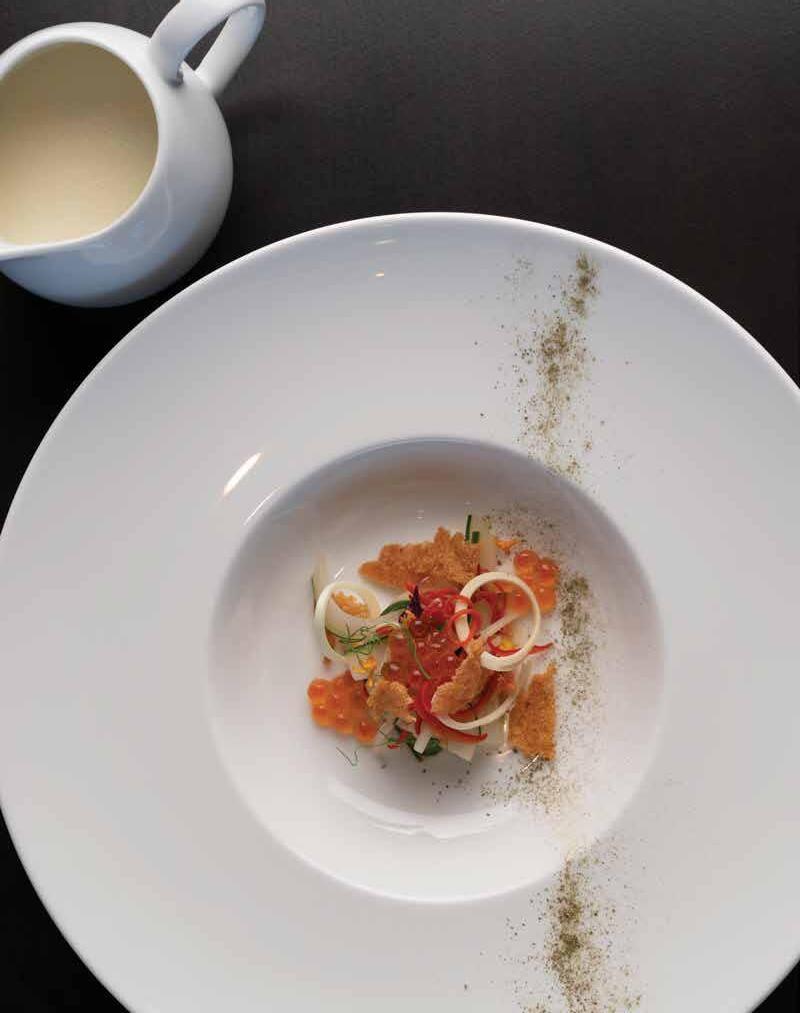

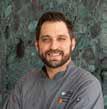

GRAND OPENING ON AUGUST 1
THE RITZ-CARLTON RESIDENCES, WAIKIKI BEACH
383 KALAIMOKU ST., HONOLULU, HI | 8F LOBBY LEVEL
4 HOUR COMPLIMENTARY VALET PARKING
DINNER 5PM–9PM | 808 729 9729
The La Vie team, pictured left: Dusty Grable, General Manager; Shaymus Alwin, Executive Chef; Patrick Collins, Chef de Cuisine.
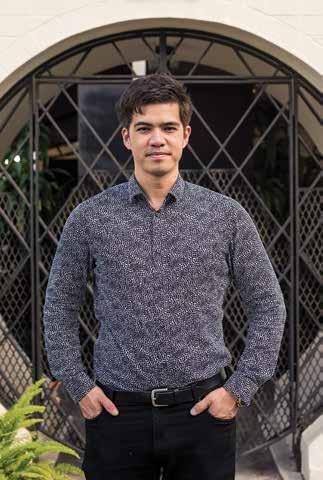
In renovating the interiors, Naoto Adachi, of Tokyo-based architectural design studio Garment, allowed the building’s original elements to shine. He retained the original windows, tile floors, and decorative metalwork around the lānai, which twists and spins into ferns and other floral patterns. The space was kept raw and unassuming, which, if not exactly innovative, is a rarity in Waikīkī, a scene that tends to abhor austerity.
Preserving the historic structure was of particular interest to its owner, Mark Smith, whose grandparents developed 413 Seaside Avenue more than 80 years ago. Smith’s grandfather, Francis Cooper, was the youngest child of Henry E. Cooper, a prominent attorney who helped overthrow the Hawaiian monarchy in 1893 and briefly served as the attorney general of the Republic of Hawai‘i. The Coopers were allies of sugar plantation owners like Sanford Dole, and Francis eventually got into sugar himself, moving his family to the island of Negros in the Philippines, where he operated three plantations and some of the country’s first movie theaters. When Cooper returned to Hawai‘i in 1936, he started a transportation and construction company in what is now Kaka‘ako. The company produced the concrete masonry blocks that workers stacked to make the walls of 413 Seaside Avenue, as well as the unique, redtinted, hollow concrete tile that still adorns the building’s roof, a product that Cooper developed.
インテリアのリノベーションにあたって、東京 に本社を置くデザインスタジオ「ガーメント」の安 立尚斗氏は、建物がもともと持っていた要素を輝 かせたいと考え、建築当初からの窓、タイルの床、 そしてラナイを取り巻くシダなどの植物のモチーフ を描いた金属細工の飾りを改装後も使うことにし た。控えめな内装の店内は、質素を嫌う傾向にあ るワイキキにあって、革新的とまではいえないとし ても稀有な空間となっている。
この歴史的建造物の所有者であるマーク・ スミス氏は、建物の保存に強くこだわっていた。ス ミス氏の祖父、フランシス・クーパー氏がシーサイ ド・アベニュー413番地を開発したのは80年以 上前にさかのぼる。フランシス・クーパー氏の父 は、1893年のハワイ王国の転覆にもかかわり、ハ ワイ共和国の司法長官を短期間務めたこともある 有力な弁護士、ヘンリー・E.クーパー氏である。ク ーパー家はサンフォード・ドールのような砂糖キビ プランテーションの経営者と姻戚関係にあった。 フランシス・クーパー氏も砂糖事業に手を染め、家 族を連れてフィリピンのネグロス島に移住した。そ こで彼は3つのプランテーションのほか、フィリピン で初の映画館もいくつか経営し、その後1936年に ハワイに戻って、現在のカカアコの地に輸送と建設 を手がける会社を創業した。同社が生産したコン クリートブロックがシーサイド・アベニュー413番 地の壁となり、赤色に染められて中が空洞になって いる独特な形のコンクリート製タイルが今も建物 の屋根を飾る。このタイルはフランシス・クーパー 氏自身が開発したものだ。
146 F FARE Zigu PALM
Mark Rogers, general manager of Zigu.
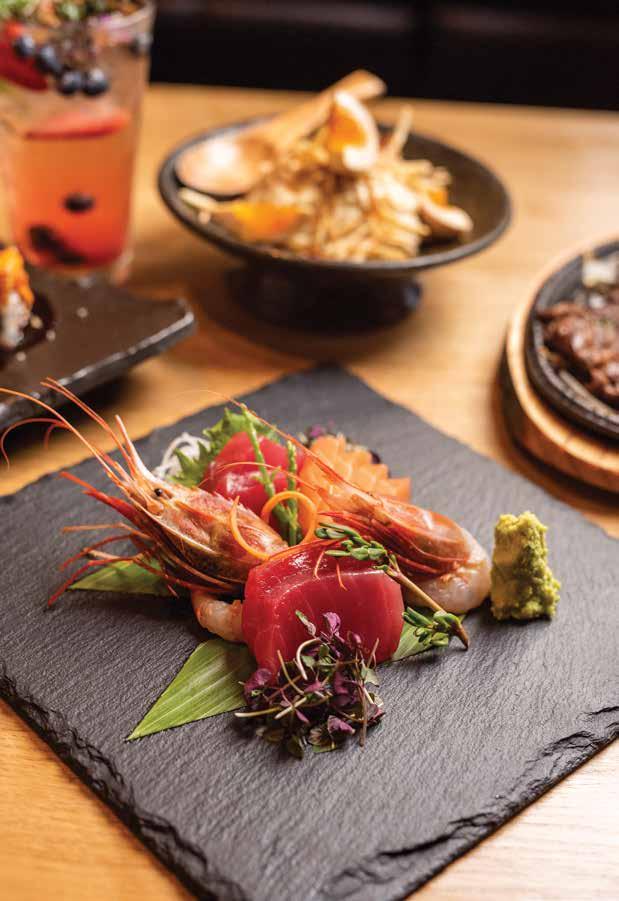 The plates at Zigu marry elements of French, Japanese, and Hawaiian cuisine.
The plates at Zigu marry elements of French, Japanese, and Hawaiian cuisine.
Smith, who grew up in Salem, Oregon, remembers 413 Seaside well. In the summers, he visited his grandmother Hazel Cooper, who managed the apartment building and the Cooper Apartments next door, which the family also built. Most summers, Smith stayed with his grandmother, but one year, while he was in college, he secured a studio in 413 Seaside. “That was a magical summer for me,” he says. “I was a big Charles Dickens fan. I read and reread Dombey and Son, Great Expectations, The Life and Adventures of Nicholas Nickleby. I was a runner, so I’d run, read Dickens, work, and study Japanese.”
The building was eventually converted into commercial space, but Smith, who moved to Hawai‘i full time in 2006 and oversees the property alongside his family, felt that 413 Seaside, and especially its spacious lānai, had gone underused. When Zetton approached Smith about opening a pair of restaurants there, Smith saw it as an opportunity to realize the building’s potential. After years of renovation, 413 Seaside reopened to the public in 2018, its clean, white masonry walls and deep eaves cutting a newly handsome profile.
History is short in Waikīkī, and often for sale, but 413 Seaside is part of a countertrend that embraces historic preservation as a way to prevent Waikīkī’s character from being completely lost. It joins a growing roster of exciting and thoughtful rehabilitations, including the newly opened White Sands Hotel, redeveloped by the same group as The Surfjack Hotel and Swim Club on Lewers Street.
Mark Rogers, Zigu’s general manager, says part of Zetton’s mission is to contribute to the character, creativity, and long-term prosperity of Waikīkī. “We should leave some of Hawai‘i’s old construction,” he says. If not, he says, Waikīkī becomes like anywhere else in the world.
With the group’s focus on French, Japanese, and Hawaiian cuisines, served in spaces that marry early modern architecture with Japanese minimalism, Zetton’s newest restaurants could not exist anywhere but Hawai‘i. And with so much creativity on display, no single dish, style, or element steals the show. The restaurants at 413 Seaside Avenue are an ensemble performance, and Waikīkī is richer for it.
オレゴン州セーラムで育ったスミス氏は、シーサイド413番地のことをよく 覚えている。子ども時代からスミス氏は夏になると祖母のヘイゼル・クーパーさ んを訪ねた。ヘイゼルさんは413番地の建物と隣の「クーパー・アパート」を管理 していた。いつもは祖母の家に滞在していたスミス氏は、大学時代のある年、シ ーサイド413番地の1部屋に滞在する機会を得た。「あの夏は、私にとって魔法 のような時間でした」とスミス氏は語る。「私はチャールズ・ディケンズの大ファン なのですが、その夏は『ドンビー父子』『大いなる遺産』『ニコラス・ニクルビー』を 何度も読み返しました。ランニングもしていたので、走って、ディケンズを読み、働 き、日本語を勉強する、という生活を送っていたのです」 スミス氏は2006年にハワイに完全に移住し、以来、家族と一緒にこの建 物を管理している。シーサイド413番地はいつしか商業スペースになったが、ス ミス氏はこの建物、中でも広々としたラナイが十分に活用されていないと感じて いた。ここに2軒のレストランを開店するというゼットンの提案を聞いたスミス氏 は、建物の持つ可能性を実現する機会になると考えた。数年のリノベーションを 経て2018年に完成した新生シーサイド413番地は、そのすっきりとしたブロッ ク積みの白い壁、奥行きのあるひさしを生かして、均整の取れた新しい魅力を放 っている。
ワイキキの歴史は浅く、歴史的建造物も売りに出されることが多い。その中 で、ワイキキの個性が完全に失われないように歴史的遺産をすすんで保存しよう とする新たな潮流が生まれており、シーサイド413番地もその一例だ。そうした スマートで面白い建築の再利用プロジェクトには、たとえば、ルワーズ・ストリー トのサーフジャック・ホテル&スイムクラブと同じチームが開発して最近開業した ばかりのホワイト・サンズ・ホテルなどがある。
ジグの総支配人、マーク・ロジャース氏は、ワイキキならではの個性と創造 性に貢献し、地域が長く繁栄する一助となることが、ゼットンのミッションの一つ であると語る。「ハワイの昔の建物の一部は保存すべきです。そうしなければ、ワ イキキは世界のどこにでもあるような場所になってしまうでしょう」
フランス、日本、ハワイのキュイジーヌに力を入れるゼットンが、レトロモダ ンな建築と日本のミニマリズムを融合させたスペースで提供するメニューの数 々。この新しい2軒のレストランはハワイ以外の場所には存在し得ない。創造性 があらゆる面でふんだんに発揮され、どんな一皿やスタイル、要素も、一つだけが 突出するということはない。シーサイド・アベニュー413番地の2軒のレストラン はアンサンブルが奏でる音楽なのだ。ワイキキのレパートリーが、また一つ豊か になっていく。
PALM 148 F FARE Zigu
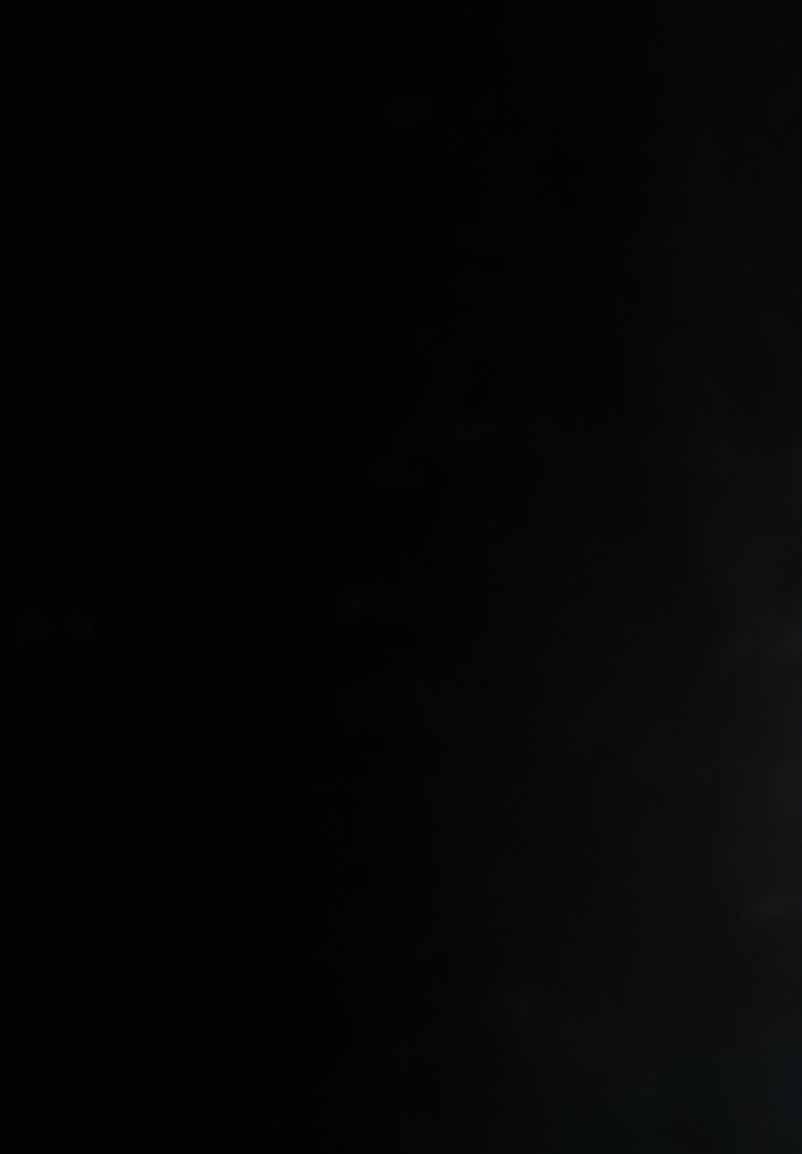
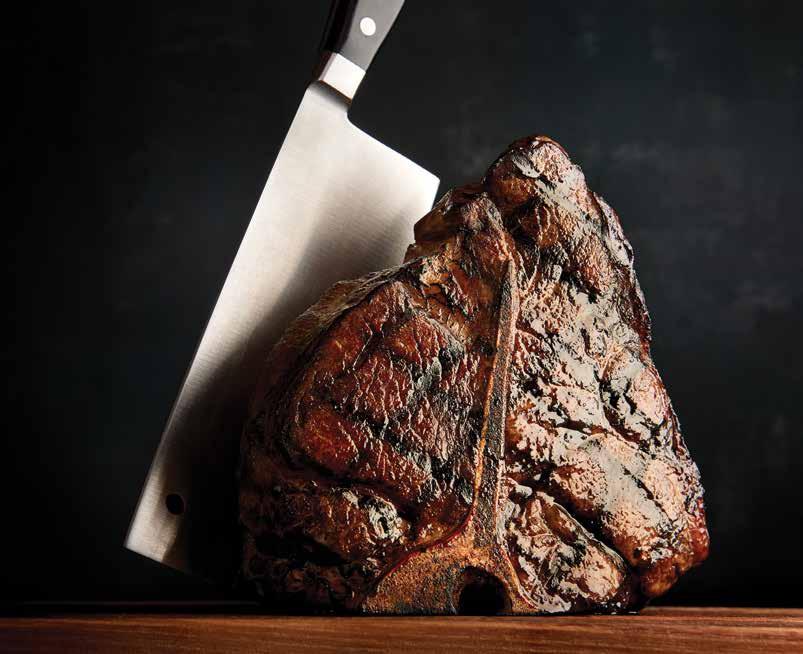
HONOLULU | 1450 ALA MOANA BLVD. | 808.949.1300 MORTONS.COM PRIME TIME all the time.
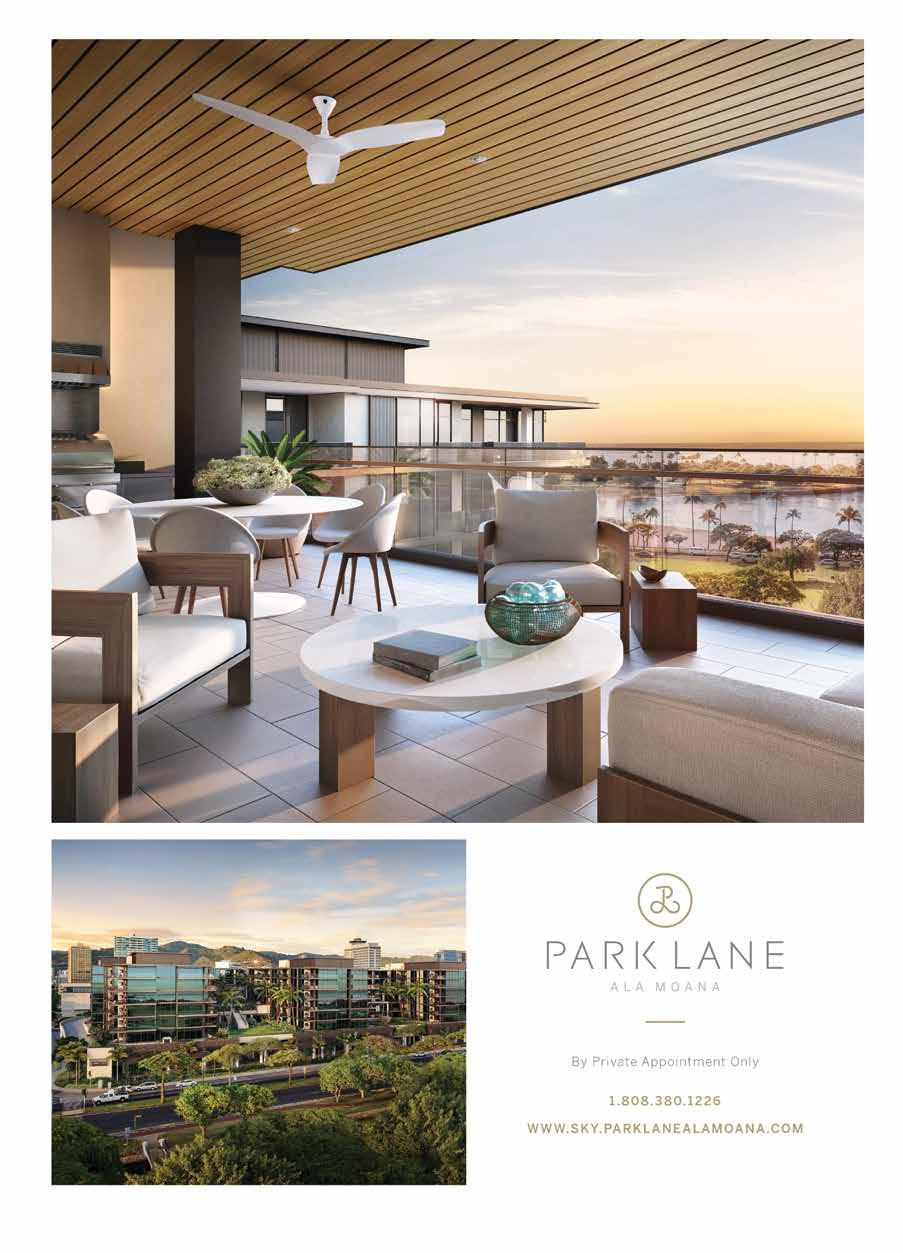
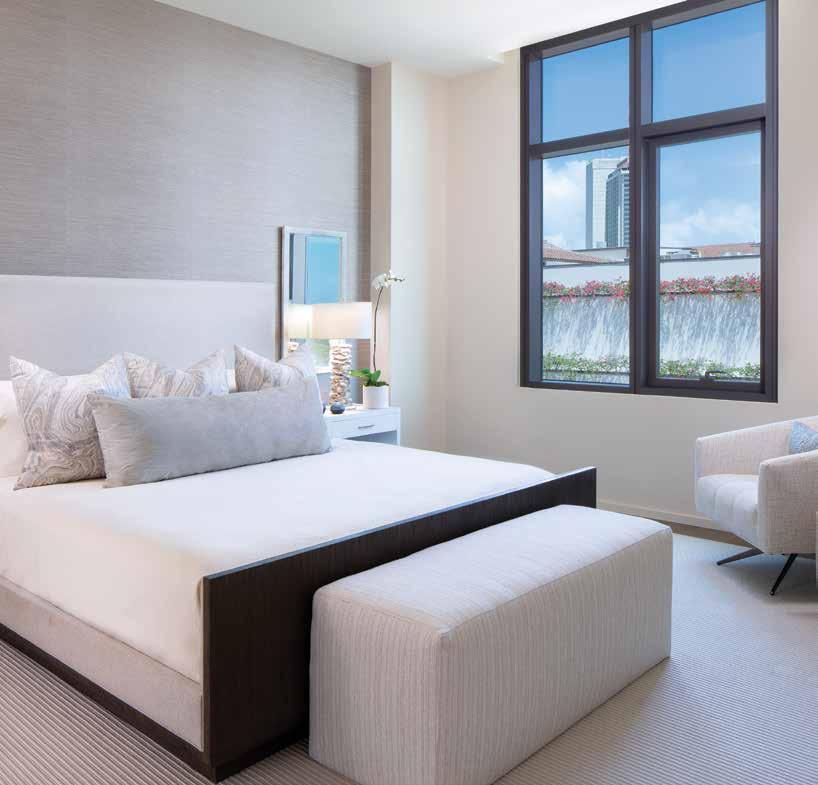
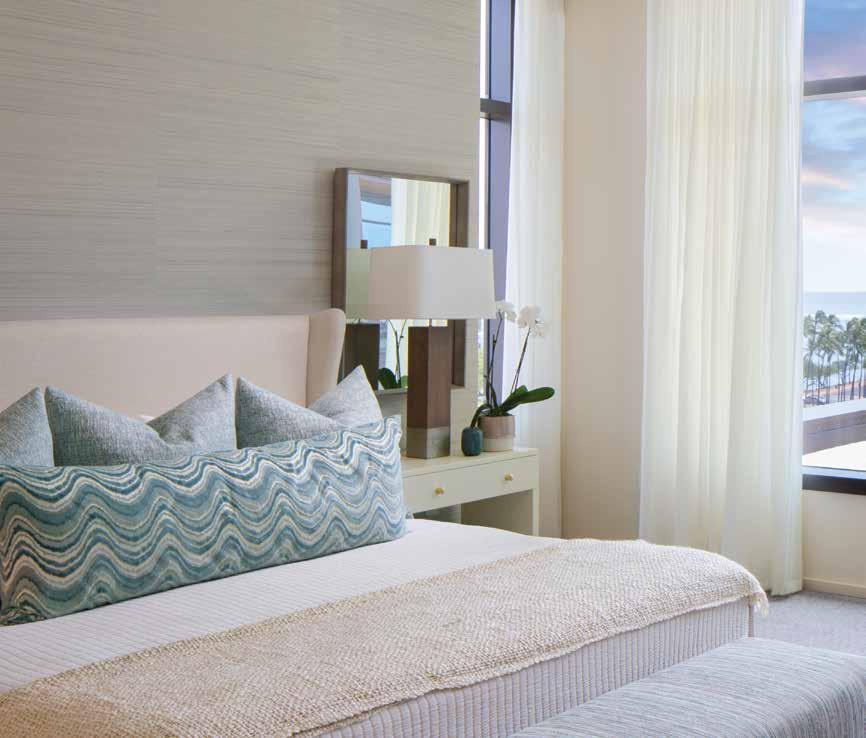
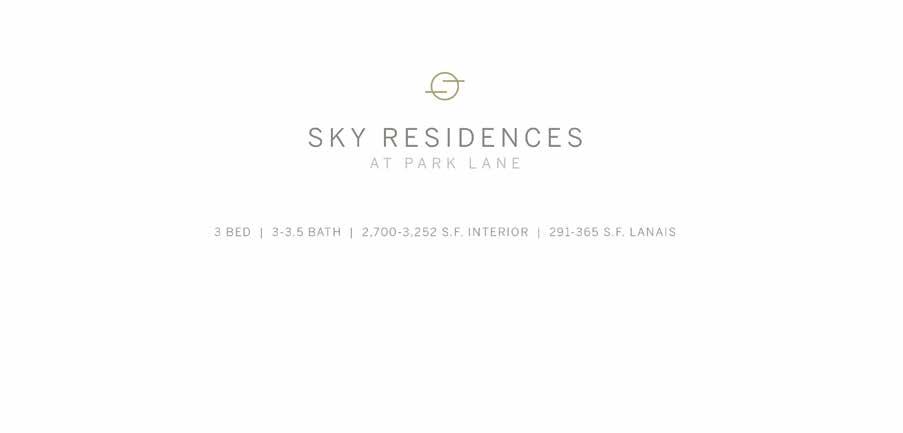
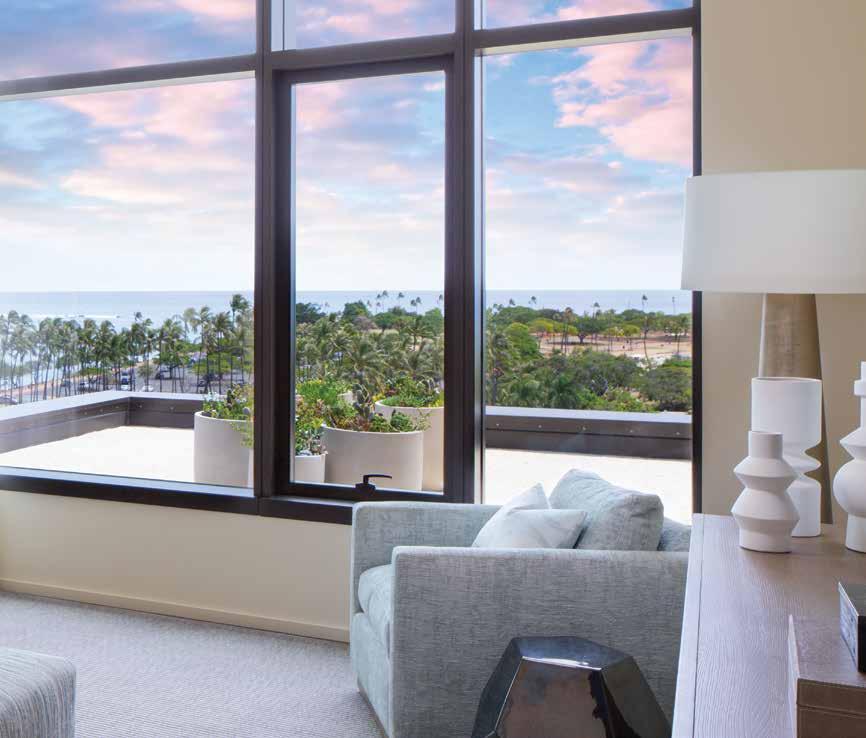
An Exquisite Estate In The Sky
Welcome to the Sky Residences, in the award-winning Park Lane Ala Moana. Experience the comfort, privacy and security of a single-family home and the relaxed refinement of a cosmopolitan oasis, right in the heart of Honolulu.
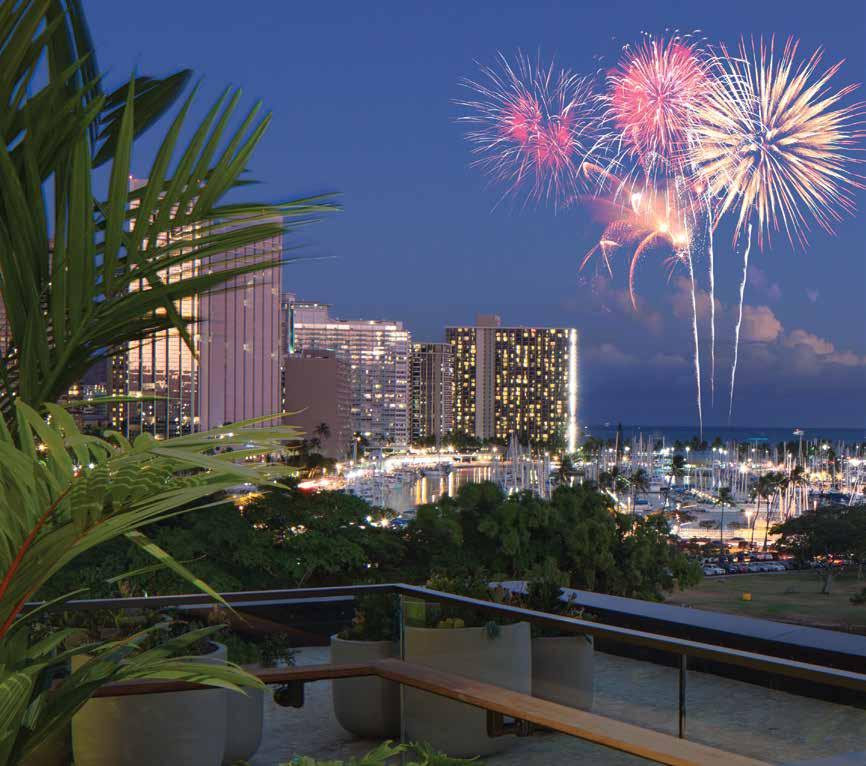
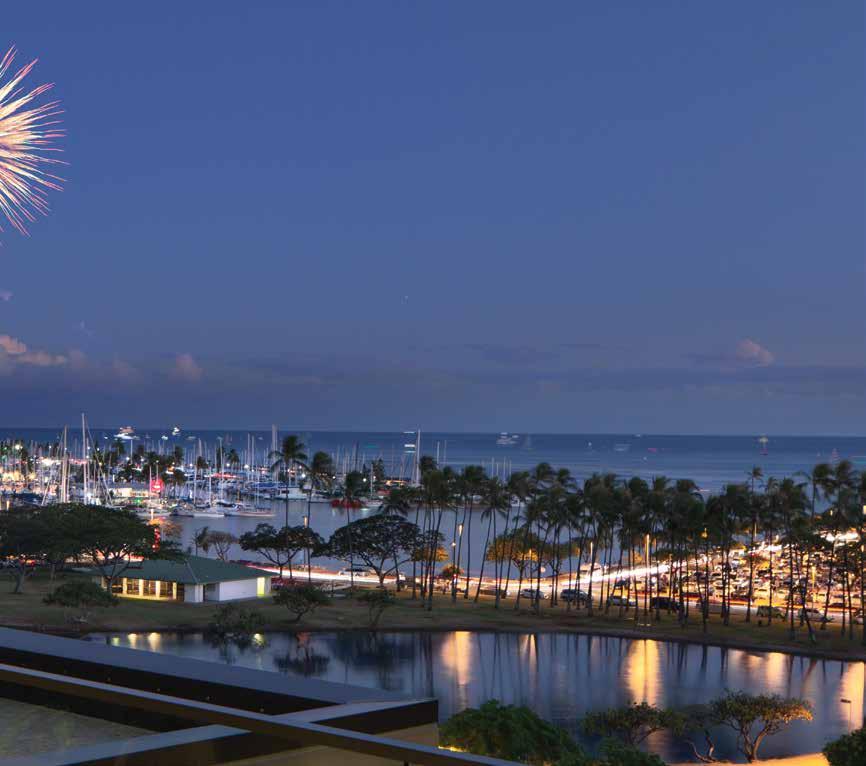
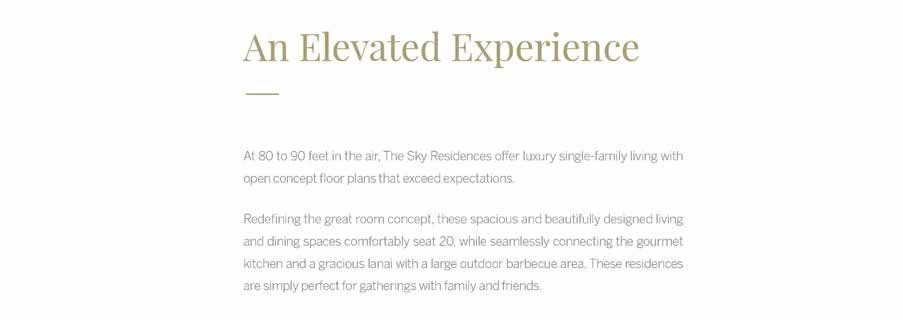
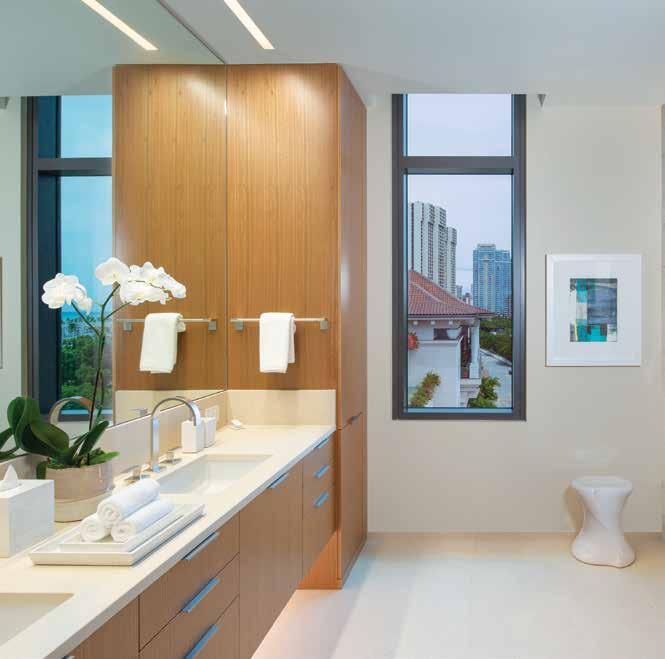
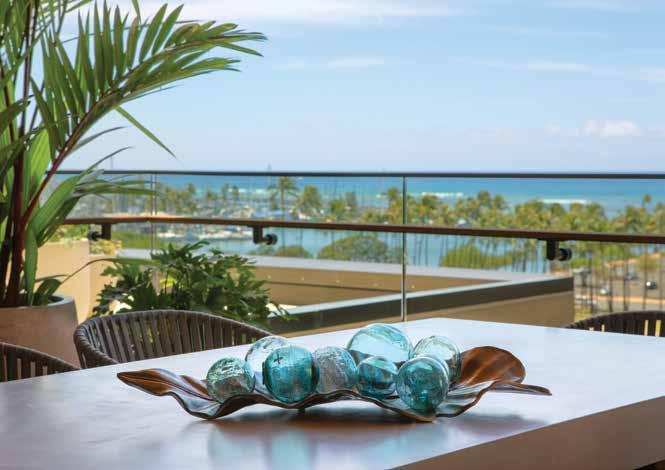

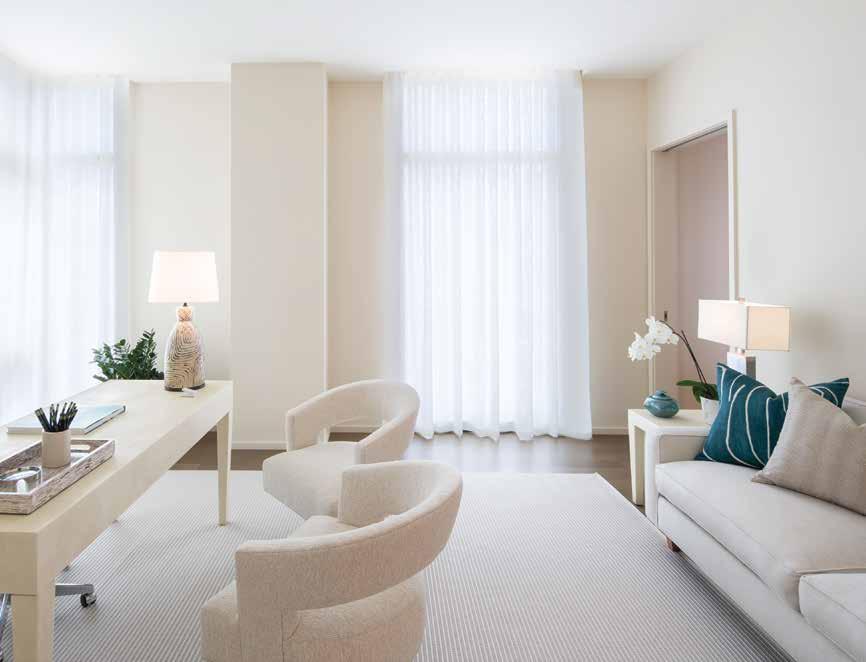

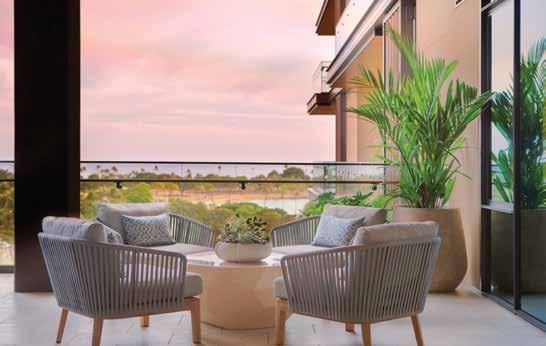
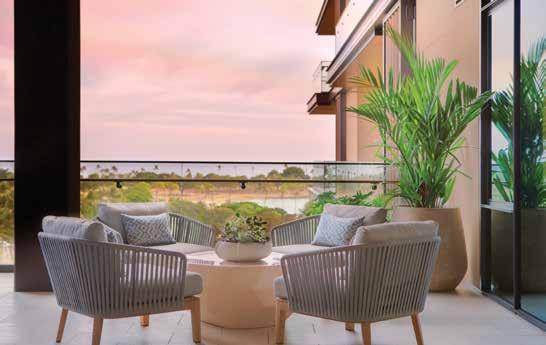
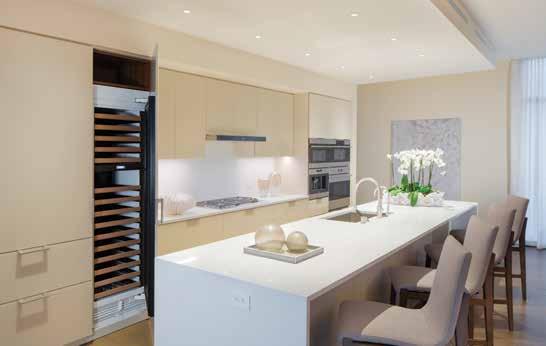
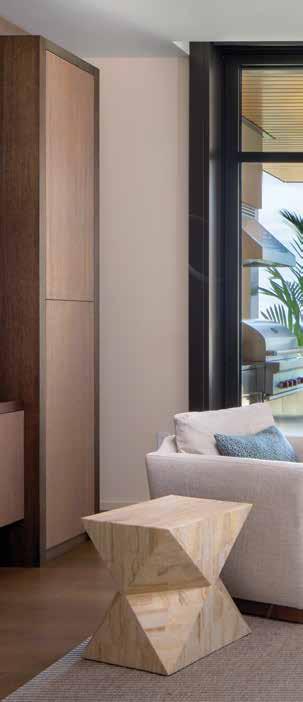

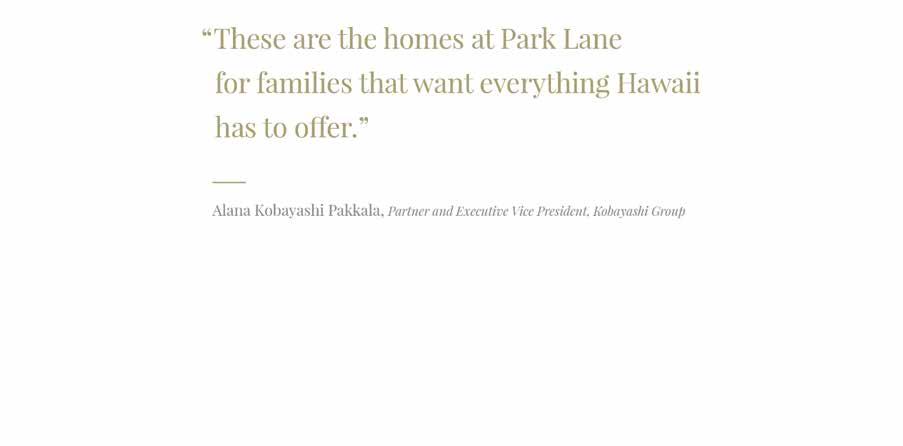
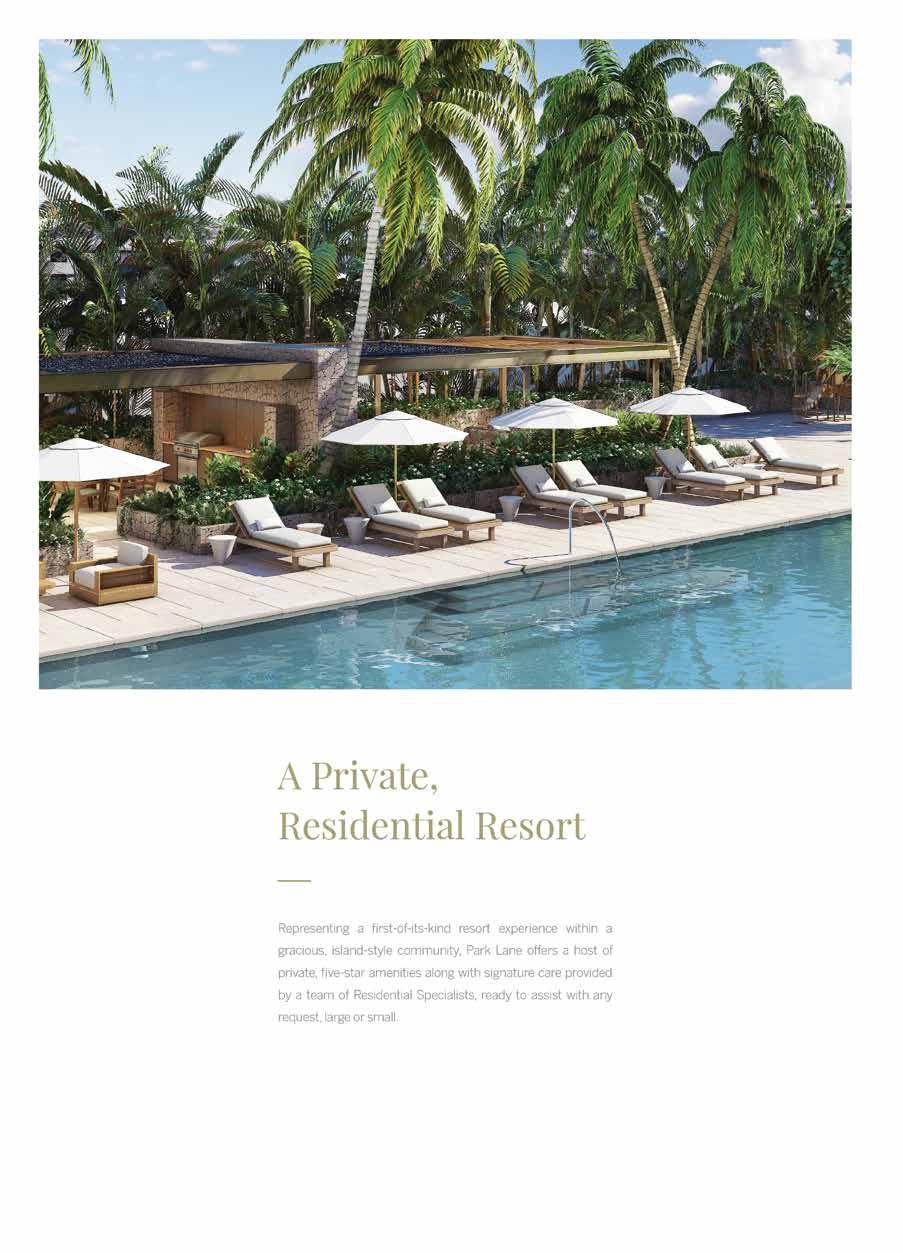
Personalized Service, Elegantly Presented
To Park Your Car or Arrange Transportation PARCEL DELIVERY And Acceptance. All Day / Every Day CONCIERGE
For Daily Needs, Large or Small
SECURE STORAGE
For Beach Gear, Seasonal Items and Everything Else
BEACH SERVICES
Transportation, Setup and Takedown of Beach Gear
GLOBAL COMMUNITY
Multilingual Residential Services Team
EXPERT PLANNING
Special-Event Coordination and Barbecue-Cabana Preparation
24-HOUR SECURITY
For Real Peace — and Peace of Mind
RESIDENCE CARE
Monthly Monitoring and Inspection for Offshore Owners
VALET
Disclaimer: Park Lane Ala Moana (the “Project”) is a proposed project that does not yet exist. It is estimated that the Project will be completed in December of 2017. All figures, facts, information and prices are approximate and subject to change at any time. All renderings, maps, site plans, photos, simulated views, floor plans, graphic images, drawings and all other information depicted in this brochure are illustrative only, and are provided to assist the purchaser in visualizing the residences and the Project and may not be accurately depicted and may be changed at any time. Photos and drawings and other visual depictions of the Project and residences contained in this brochure are artist renderings and should not be relied upon in deciding to purchase a residence. The Developer makes no guarantee, representation or warranty whatsoever that the residences depicted in this brochure will ultimately appear as shown. To the extent permitted by law, the Developer disclaims all liability that may arise out of errors or omissions in the content of this brochure, including any claims for actual or consequential damages. This is not intended to be an offering or solicitation of sale in any jurisdiction where the Project is not registered in accordance with applicable law or where such offering or solicitation would otherwise be prohibited by law. Exclusive Project Broker: Heyer & Associates, LLC. RBO-17416 | Courtesy to qualifying brokers; see project broker for details. 1288 Ala Moana Blvd. Suite 206 | Honolulu, HI 96814. Renderings by Steelblue and Matsma.
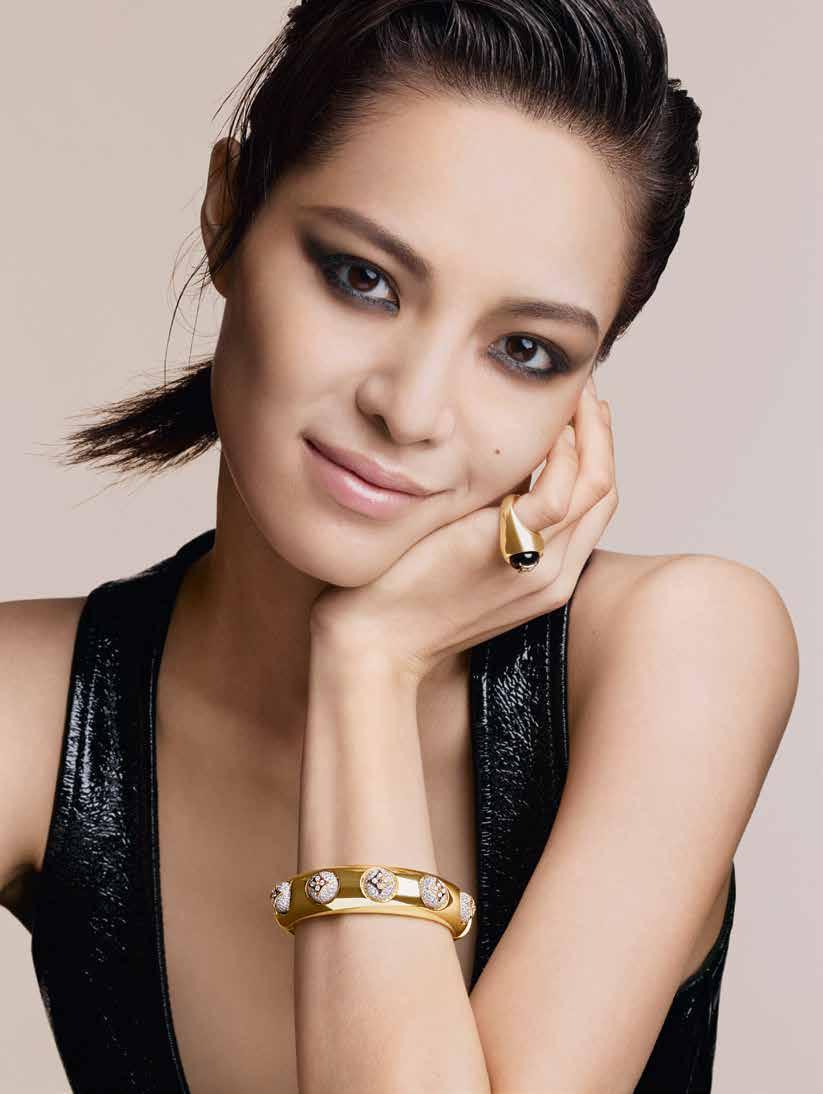









 KEIRA KNIGHTLEY
KEIRA KNIGHTLEY






















 Paul Pfeiffer, at his New York City apartment. Opposite and opening spread, Four Horsemen of the Apocalypse , photographic Digital C-print on Fujiflex, by Pfeiffer.
Paul Pfeiffer, at his New York City apartment. Opposite and opening spread, Four Horsemen of the Apocalypse , photographic Digital C-print on Fujiflex, by Pfeiffer.



 From Pfeiffer's photography series Four Horsemen of the Apocalypse
From Pfeiffer's photography series Four Horsemen of the Apocalypse




 Two Figures with Carefully Planned Obstruction (2017) by Kainoa Gruspe
Two Figures with Carefully Planned Obstruction (2017) by Kainoa Gruspe















 Details of Bassous' mural-scale piece Courting the Infinite
Details of Bassous' mural-scale piece Courting the Infinite














 Handcrafted cocktails and charming interiors enhance the experiences of guests.
Handcrafted cocktails and charming interiors enhance the experiences of guests.




 Exclusivity makes speakeasies alluring. At Wiki Waki Woo, entry requires a secret knock and a hand signal.
Exclusivity makes speakeasies alluring. At Wiki Waki Woo, entry requires a secret knock and a hand signal.












 Honolulu sign maker Von Monroe has been in the business since 1980.
Honolulu sign maker Von Monroe has been in the business since 1980.









 Kilin Reece, owner of KR Strings, is a luthier based in Kailua.
Kilin Reece, owner of KR Strings, is a luthier based in Kailua.













 Shirt and jacket by Tom Ford , pants by Brunello Cucinelli, glasses by Oliver Peoples; all from Neiman Marcus. Shoes by Gucci.
Shirt and jacket by Tom Ford , pants by Brunello Cucinelli, glasses by Oliver Peoples; all from Neiman Marcus. Shoes by Gucci.



 Suit and shirt by Brunello Cucinelli , sunglasses by Oliver Peoples, shoes by Salvatore Ferragamo; all from Neiman Marcus
Suit and shirt by Brunello Cucinelli , sunglasses by Oliver Peoples, shoes by Salvatore Ferragamo; all from Neiman Marcus


 Shoes & sunglasses by Gucci
Jacket & shirt by Bottega Veneta
Pants by Brunello Cucinelli from Neiman Marcus
Shoes & sunglasses by Gucci
Jacket & shirt by Bottega Veneta
Pants by Brunello Cucinelli from Neiman Marcus

 Suit and shirt by Brunello Cucinelli. Glasses by Barton Perreira; all from Neiman Marcus.
Suit and shirt by Brunello Cucinelli. Glasses by Barton Perreira; all from Neiman Marcus.




 Jacket and shirt by Etro, shoes by Magnanni, watch by Gucci; all from Neiman Marcus. Pants, model's own.
Jacket and shirt by Etro, shoes by Magnanni, watch by Gucci; all from Neiman Marcus. Pants, model's own.







 Scenes from Lucerne, Switzerland.
Scenes from Lucerne, Switzerland.


























































 Hula is full of mana, or spiritual power.
Hula is full of mana, or spiritual power.



 Every year hula hālau converge for the Merrie Monarch Festival.
Every year hula hālau converge for the Merrie Monarch Festival.










 The plates at Zigu marry elements of French, Japanese, and Hawaiian cuisine.
The plates at Zigu marry elements of French, Japanese, and Hawaiian cuisine.






















